Introduction
The journey of Large Language Models (LLMs) has been nothing short of revolutionary, reshaping the landscape of artificial intelligence and natural language processing. From the early days of statistical models to the groundbreaking transformer architecture, these advancements have unlocked unprecedented capabilities in language understanding and generation.
As LLMs find their footing across various sectors, particularly in healthcare, they not only enhance operational efficiency but also improve patient interactions and decision-making processes.
However, with great power comes great responsibility; organizations must navigate the ethical challenges that accompany the deployment of these advanced technologies.
This article delves into the historical development, current applications, and future trends of LLMs, offering insights into how they can be harnessed effectively while addressing the critical considerations that ensure their responsible use.
The Historical Development of Large Language Models
The evolution of llms is deeply rooted in the foundational concepts of artificial intelligence and natural language processing. Early statistical models, notably n-grams, established the groundwork for language comprehension. The introduction of neural networks in the 1980s marked a significant turning point, enhancing models’ ability to learn from data.
However, it was the emergence of the transformer architecture in 2017 that truly transformed the evolution of llms. This innovative architecture enabled more effective handling of context and relationships within language, paving the way for groundbreaking models such as BERT and GPT. These models have set new benchmarks across a variety of NLP tasks.
Kaplan et al. (2020) discuss the scaling laws for neural language models, highlighting the complexities that arise as these models grow in size. As large language models continue to advance, they have expanded exponentially in size and complexity, with modern iterations boasting tens of billions or more parameters.
This unprecedented growth facilitates remarkable capabilities in language understanding and generation. Notably, an Australian law firm recently leveraged ChatGPT to draft a statement of claim based on the landmark 1992 Mabo case, producing results comparable to those of a first-year lawyer, as noted by Iu and Wong. Such examples underscore the profound impact of large language models in practical applications, highlighting the evolution of llms as well as their historical development and ongoing advancements in the field.
Furthermore, the case study titled ‘Algorithmic Innovation in LLMs’ illustrates the transition from rule-based approaches to deep learning, emphasizing the advancements in transformer architecture that have contributed to the evolution of LLMs.
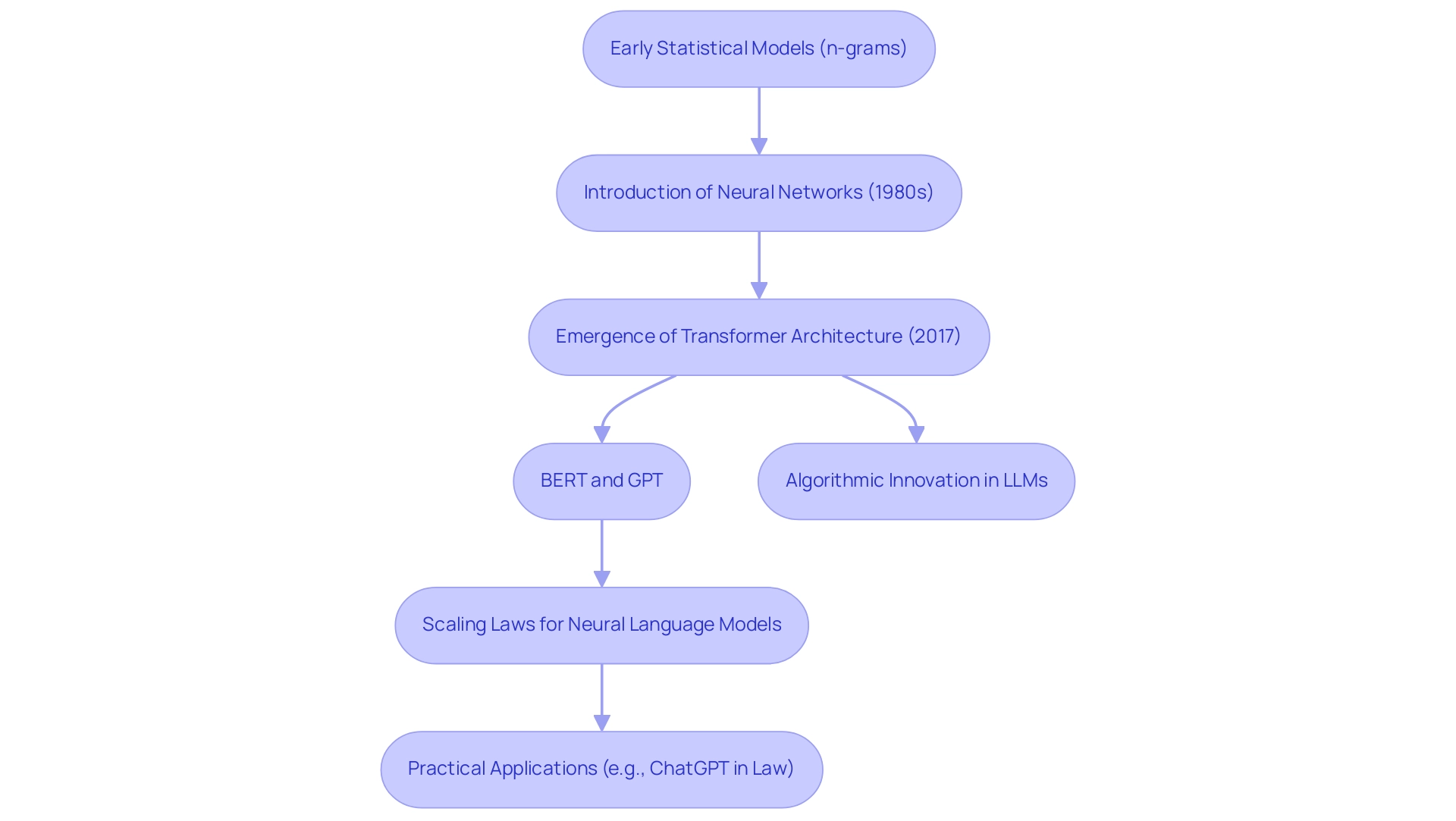
Current Capabilities and Applications of LLMs
The evolution of LLMs is revolutionizing productivity and efficiency across numerous fields, including medicine, where they significantly enhance operational processes. For example, GUI automation has been effectively applied to enhance documentation and connect legacy systems in medical settings, tackling issues such as:
- Manual information entry errors
- Slow software testing
- Challenges in integrating outdated systems without APIs
A notable case study demonstrated that a mid-sized medical company reduced data entry errors by 70% and accelerated testing processes by 50% through automation, leading to an impressive 80% improvement in workflow efficiency.
This not only enhances the quality of interactions with individuals but also allows healthcare professionals to concentrate on care rather than repetitive tasks. Furthermore, as highlighted by Alapati et al., researchers are exploring the use of ChatGPT to generate clinically accurate responses to patient inquiries, exemplifying how AI can transform patient engagement and diagnostic assistance. However, transparency in LLM applications remains a critical concern, as evidenced by a review indicating that 56% of studies lacked clear information on methodological rigor.
In the broader business context, the evolution of LLMs, along with tools like EMMA RPA and Microsoft Power Automate, facilitates smoother workflows by automating data entry and report generation, which alleviates the workload on employees and boosts morale. The integration of these technologies not only represents a technological leap but also leads to measurable improvements in operational success across various sectors, with ROI achieved within six months of implementation.
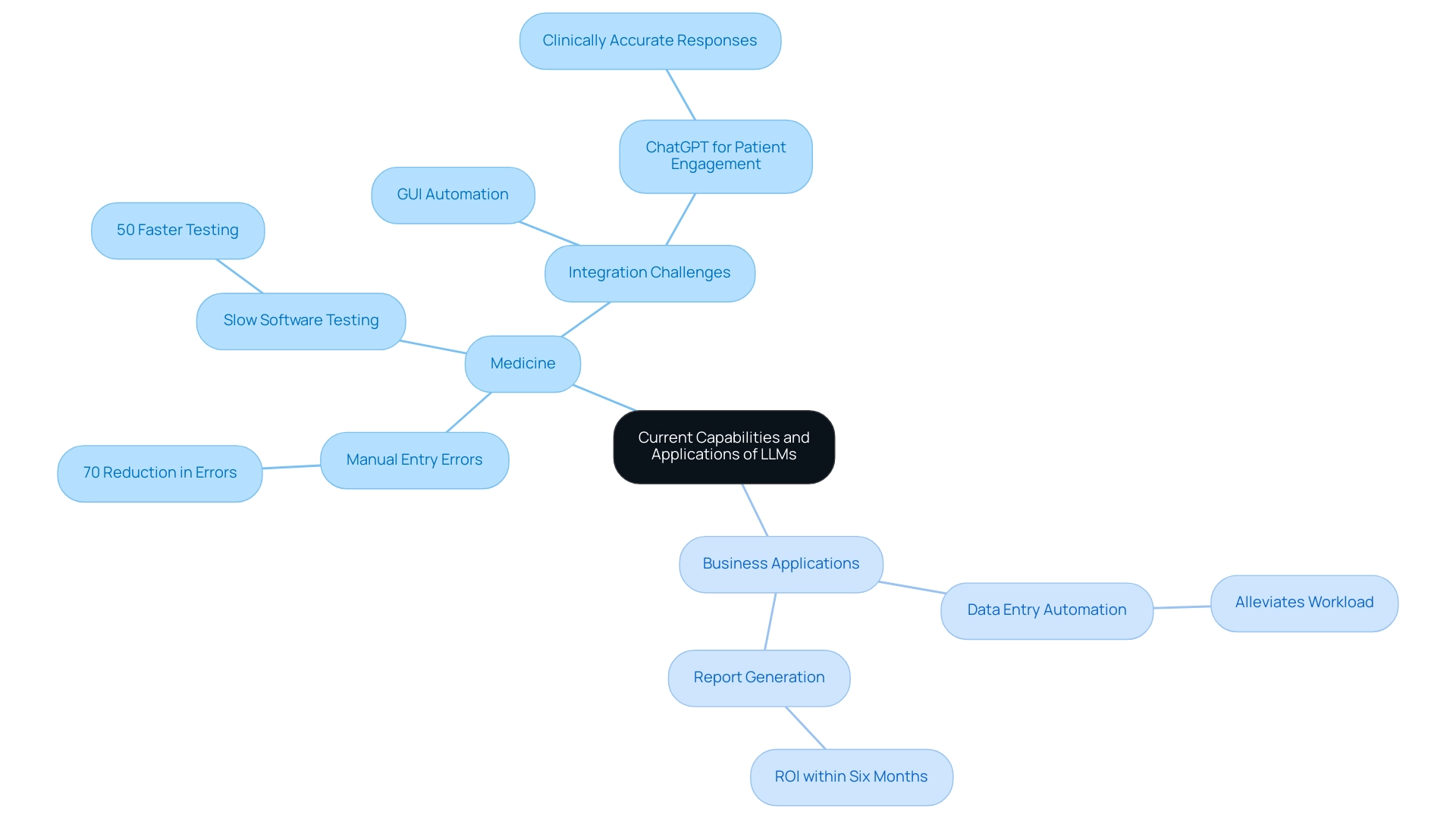
Future Trends and Innovations in LLM Technology
The future of Large Language Models is on the brink of significant evolution of llms, driven by innovations such as real-time learning and advanced human feedback mechanisms. These advancements will contribute to the evolution of llms, empowering large language models to continuously adapt and enhance their capabilities, leading to even more sophisticated understanding and generation of human-like language. In this rapidly evolving AI landscape, organizations must confront the challenges posed by manual, repetitive tasks, which can significantly hinder operational efficiency.
By leveraging Robotic Process Automation (RPA), businesses can automate these workflows, streamline operations, and enhance overall efficiency. As highlighted by recent findings, 64% of individuals believe the primary purpose of AI is to assist, enhance, and empower consumers, underscoring the growing emphasis on ethical AI deployment. By integrating tailored AI solutions and Business Intelligence, businesses can transform raw data into actionable insights, enabling informed decision-making that drives growth and innovation.
For instance, a case study on ‘Electrification and Renewables Investment‘ illustrates how RPA and Business Intelligence have been successfully implemented to optimize operations and support strategic initiatives. Furthermore, the evolution of llms, in conjunction with complementary AI technologies such as computer vision and robotics, is expected to yield comprehensive solutions that significantly boost operational efficiency across various sectors. To navigate these transformative trends effectively, businesses must embrace a proactive and agile approach in adopting these technologies, ensuring they remain competitive in an ever-evolving landscape.
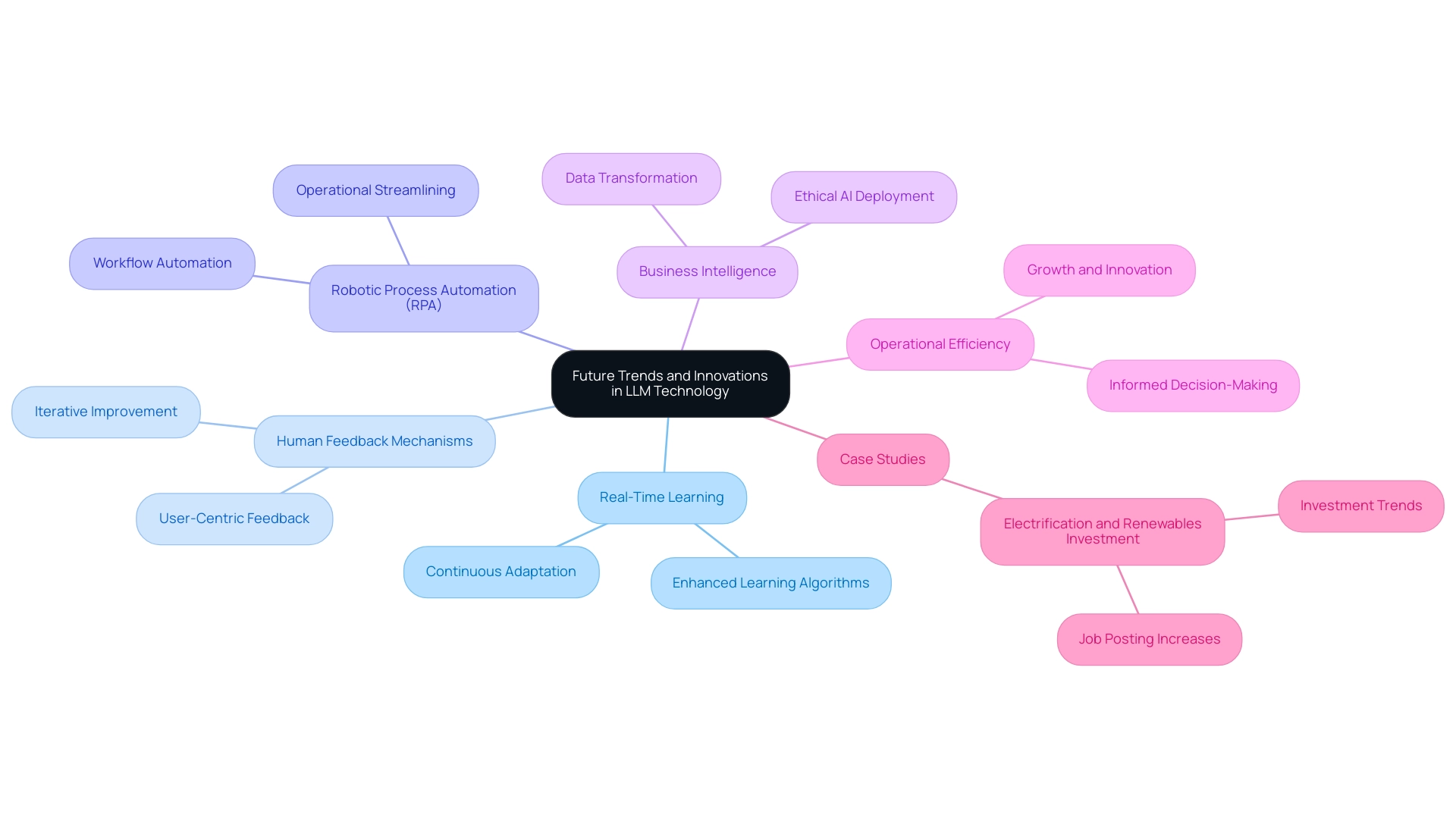
The Role of LLMs in Transforming Healthcare
Large Language Models are transforming the healthcare environment by improving user interactions and optimizing administrative processes. Their integration with electronic health records (EHRs) leads to more efficient information retrieval and analysis, significantly enhancing clinical decision-making. For instance, large language models can produce brief summaries of clients, identify relevant medical literature, and even predict outcomes based on historical data patterns.
Moreover, LLMs improve communication between individuals and medical providers through advanced chatbots, which can address common inquiries and offer timely assistance beyond standard office hours. However, the rapidly evolving AI landscape presents challenges in identifying the right solutions for medical organizations. Tailored AI solutions can help navigate these complexities, ensuring that technologies align with specific operational goals.
To further enhance operational efficiency, incorporating Robotic Process Automation (RPA) can automate manual workflows, minimizing repetitive tasks that hinder operations and allowing medical professionals to concentrate on direct care. This synergy allows for enhanced productivity and informed decision-making by leveraging Business Intelligence tools. As we approach the threshold of this thrilling new age in medical services, it is essential to accept the potential of machine learning while focusing on the safety and welfare of those we assist, as emphasized by Eli Ben-Joseph, Co founder & CEO:
- ‘As we approach the threshold of this thrilling new age in medical services, it’s time to accept the potential of machine learning while prioritizing the safety and welfare of the individuals we support.’
This balance will be vital as the evolution of LLMs alongside RPA technology continues to shape the future of medical care in 2024 and beyond. Insights from healthcare professionals further emphasize the importance of large language models in enhancing patient interactions, reinforcing the need for ongoing dialogue in this transformative domain.
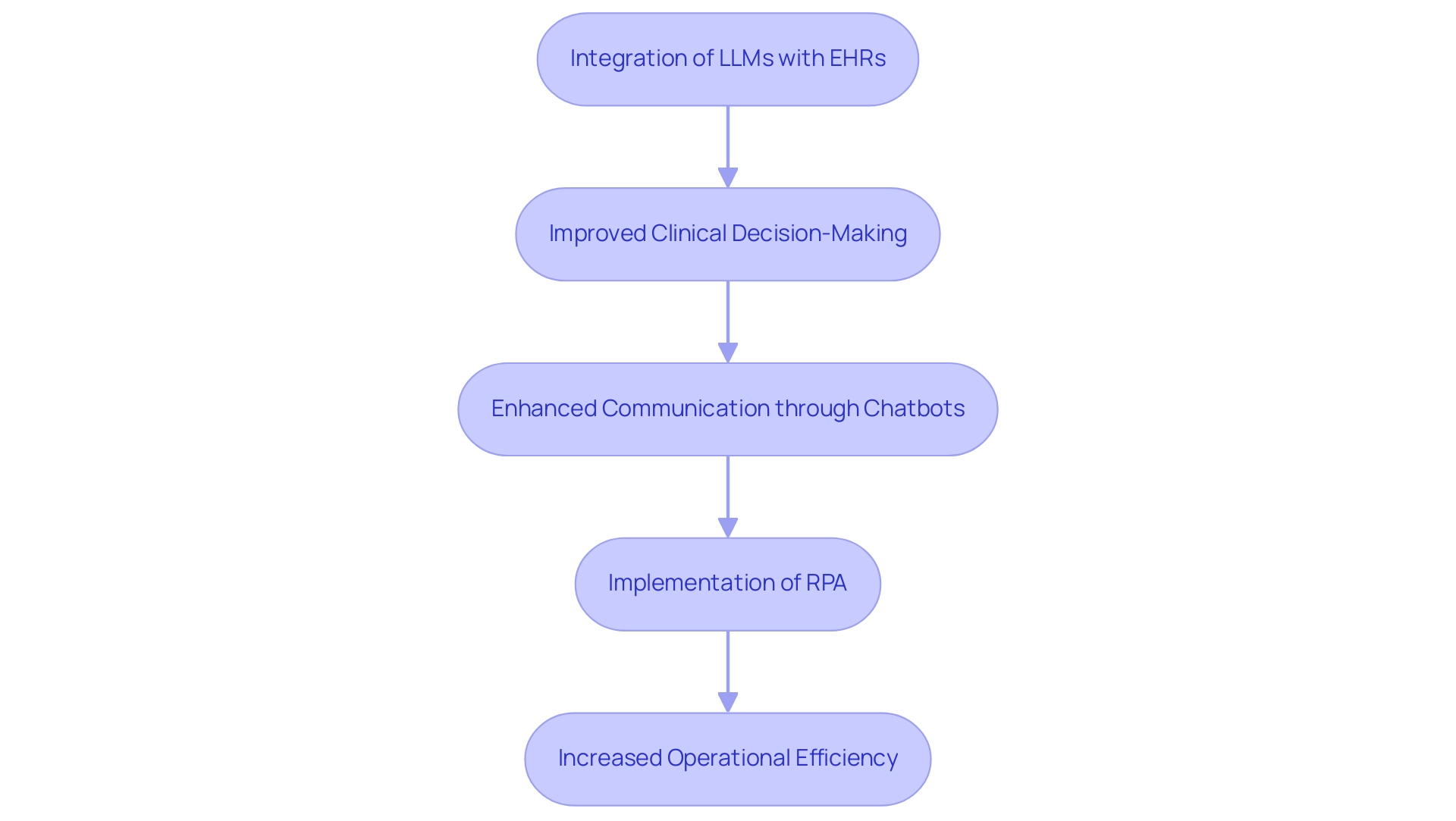
Ethical Challenges and Considerations in LLM Deployment
As organizations increasingly adopt Large Language Models, the evolution of LLMs makes navigating the ethical challenges they present essential. Major issues involve information privacy, especially as large language models require access to sensitive details to operate efficiently. To maintain user trust, it’s vital to manage this data responsibly.
Additionally, the issue of ‘hallucinations’—instances where large language models generate inaccurate or nonsensical output—poses serious risks, especially in critical sectors like healthcare and finance. Organizations must, therefore, implement rigorous validation processes and establish comprehensive guidelines for the ethical use of large language models, considering the evolution of LLMs. Educational initiatives, such as GenAI workshops, can empower teams with hands-on training, enabling them to integrate AI solutions effectively while adhering to ethical standards.
These workshops not only equip participants with practical skills but also focus on enhancing customer satisfaction and loyalty through personalized AI interactions. Statistics reveal that 27 percent of consumers would discontinue dealings with a company after a negative AI experience, highlighting the urgency for ethical AI practices. Furthermore, the case study titled ‘Trustworthy AI Practices’ indicates that although IT professionals acknowledge the importance of transparency and ethics in AI, fewer than half have taken substantial steps toward implementation.
As Dan Simion, Vice President of AI & Analytics for Capgemini North America, emphasizes, ‘In the future, it’s up to IT leaders to ensure that ethics are a part of the conversation from the beginning when deploying these AI systems – even when deployments are done quickly.’ By proactively addressing these ethical considerations and leveraging tailored AI solutions, businesses can harness the potential of LLMs, contributing to the evolution of LLMs while mitigating risks and fostering a responsible approach to AI deployment that meets consumer expectations for transparency and accountability.
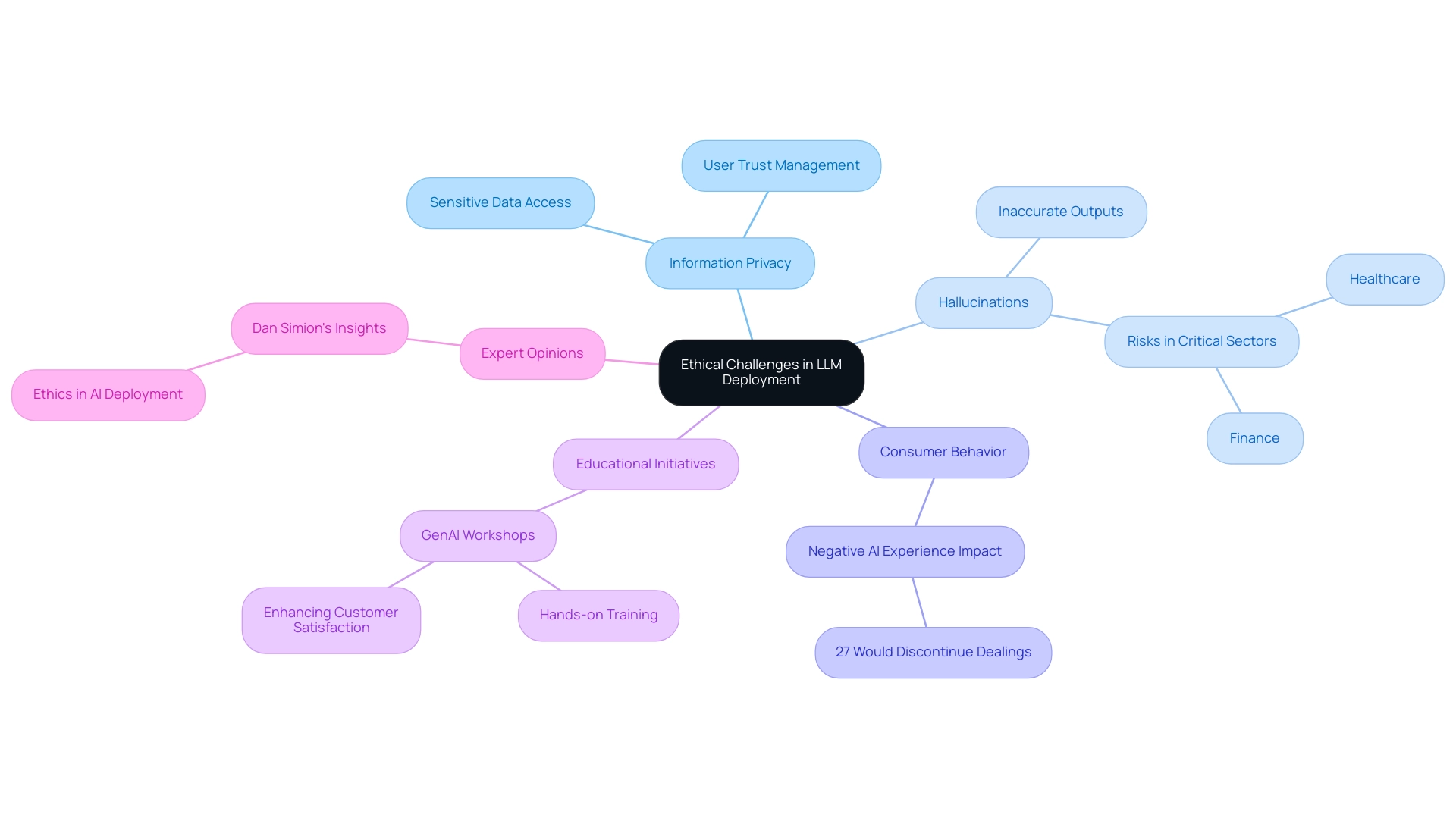
Conclusion
The remarkable journey of Large Language Models (LLMs) has not only transformed the field of artificial intelligence but has also profoundly impacted various sectors, particularly healthcare. From their historical roots in statistical models to the innovative transformer architecture that has propelled their capabilities, LLMs have demonstrated their potential to enhance operational efficiency and improve patient interactions. Real-world applications, such as GUI automation and advanced chatbots, showcase how LLMs streamline workflows and reduce errors, allowing healthcare professionals to concentrate on what truly matters: patient care.
As organizations look to the future, the integration of LLMs with complementary technologies like Robotic Process Automation and Business Intelligence will be crucial. These advancements promise to further refine operational processes, enabling businesses to make informed decisions based on actionable insights. However, the deployment of these powerful tools comes with ethical responsibilities that cannot be overlooked. Addressing data privacy, ensuring accuracy, and fostering transparency are essential steps to build user trust and maintain high standards in AI applications.
In conclusion, embracing the potential of LLMs while navigating the associated challenges will empower organizations to thrive in an increasingly competitive landscape. By prioritizing ethical considerations and leveraging tailored AI solutions, businesses can harness the full capabilities of LLMs, ultimately driving innovation and enhancing the quality of services provided. The future of LLM technology is bright, and as organizations adapt to these changes, they will be well-equipped to meet the demands of tomorrow while ensuring a responsible and positive impact on society.
Introduction
In an age where data reigns supreme, organizations are increasingly turning to advanced data analytics to unlock insights that drive growth and streamline operations. The landscape of analytics is rich with opportunities, yet many companies grapple with the complexities of selecting the right tools and methodologies.
This article delves into the intricacies of advanced analytics, exploring its various types—from descriptive to prescriptive—and how they can be tailored to meet specific business objectives. By addressing challenges such as data quality and resource allocation, and leveraging innovative technologies like Robotic Process Automation (RPA), organizations can enhance their decision-making processes and operational efficiency.
As the demand for data-driven insights continues to rise, understanding how to effectively implement and measure the impact of these analytics becomes crucial for achieving lasting success.
Understanding Advanced Data Analytics in Business
Advanced information analysis includes a variety of complex methods and instruments created to examine intricate sets of information, enabling companies to reveal patterns, trends, and insights that conventional analysis might miss. In an increasingly data-driven environment, the effective application of advanced data analysis, alongside Robotic Process Automation (RPA), is crucial for enhancing decision-making processes, streamlining operational workflows, and fostering innovation. Companies can leverage RPA to automate manual workflows, reducing repetitive tasks that slow operations and freeing up resources for strategic initiatives.
However, many organizations struggle with poor master information quality, which can lead to inconsistent, incomplete, or flawed information that hampers effective analysis and decision-making. Tackling these challenges is crucial for optimizing the advantages of RPA and advanced data analysis. To address specific needs, one can select four types of advanced data analytics, including:
1. Predictive analytics, which predicts future outcomes;
2. Prescriptive analytics, which provides actionable recommendations;
3. Diagnostic analytics, which determines reasons behind past results;
4. Descriptive analytics, which outlines historical information.
Understanding these distinctions is essential for enhancing information utilization and aligning analytical efforts with overarching business objectives. Furthermore, tailored AI solutions can help organizations navigate the overwhelming AI landscape, ensuring that the technologies implemented align with specific business goals and challenges. A study published in Pharm Pract highlights that 65% of healthcare professionals believe that interpretative phenomenological analysis can deepen understanding of individuals’ lived experiences, illustrating the significance of qualitative insights in enhancing interpretation.
As one participant noted, ‘Nobody actually sat down and had a talk and showed some interest in you as a person; you were just there basically labelled.’ This underscores the necessity for a human-focused strategy in information analysis and the function of business intelligence in converting raw information into actionable insights. Furthermore, the case study titled ‘Conclusions on Qualitative Research’ demonstrates how qualitative research provides insights into participants’ thoughts and feelings, which can inform healthcare practices.
As we move into 2024, the focus on sophisticated information analysis, backed by RPA and business intelligence, continues to increase, highlighting its importance in informed decision-making across sectors.
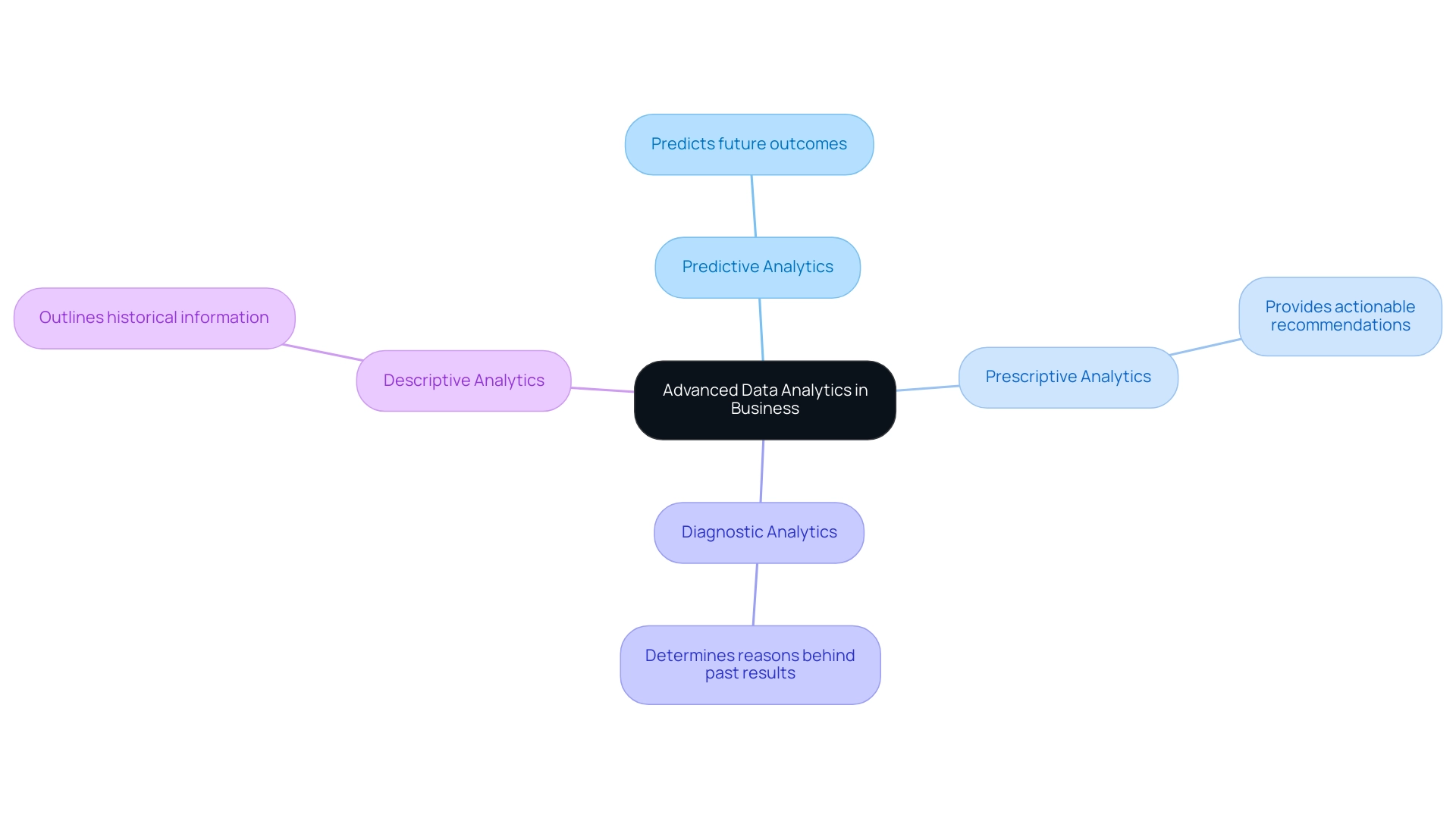
Criteria for Selecting the Right Types of Data Analytics
Choosing the appropriate types of data analytics for your organization demands careful consideration of several crucial criteria:
-
Business Objectives: Start by defining your particular aims for information analysis. Whether your focus is on enhancing customer satisfaction, streamlining supply chain processes, or refining sales forecasts, a clear understanding of your objectives will steer your selection process.
-
Information Quality: The integrity and accessibility of your information cannot be overlooked. High-quality information is the backbone of precise analytics. Confirm that your information sources are trustworthy and that you can access the essential points needed for your analysis. Poor master information quality can significantly hinder your ability to extract meaningful insights, leading to inefficient operations. A survey of 300 students revealed that organizations prioritizing information quality significantly outperform their competitors in analytical outcomes. RPA can play a crucial role in improving data quality by automating data entry and validation processes, thereby reducing errors and inconsistencies.
-
Resource Availability: Take stock of the resources at your disposal, including budget constraints, technological capabilities, and personnel expertise. Some data analysis solutions necessitate sophisticated tools or specialized analysts. Utilizing Robotic Process Automation (RPA) can assist in streamlining these processes, ensuring that your data choices align with your available resources while minimizing manual workload. For instance, EMMA RPA can automate repetitive data collection tasks, freeing up your team to focus on analysis rather than data gathering.
-
Scalability: It’s essential to evaluate whether the selected data analysis type can grow in tandem with your business. As your entity adjusts and grows, so too may your data analysis needs. Choosing an adaptable solution will guarantee that your information analysis efforts can develop in tandem with your operational environment. Tailored AI solutions can help cut through the noise of overwhelming options, providing the right technologies that align with your specific business challenges.
By meticulously evaluating these criteria, organizations can confidently select four types of advanced data analytics that are aligned with their unique operational challenges and strategic aspirations. As Dr. Nikita Thattamparambil aptly stated, “Remember that your aim is not just to describe your methods, but to show how and why you applied them and demonstrate that your research was rigorously conducted.” This approach not only enhances analytical efficacy but also underscores the dedication to quality and precision in your data-driven decisions.
For example, the case study of a Food and Beverage Director demonstrates how effective management and innovative planning in data analysis can drive revenue growth and improve customer service, aligning data selection with business objectives while harnessing the power of Business Intelligence. Additionally, testimonials from clients who have successfully implemented RPA and Business Intelligence solutions can provide practical insights into the benefits and effectiveness of these tools.
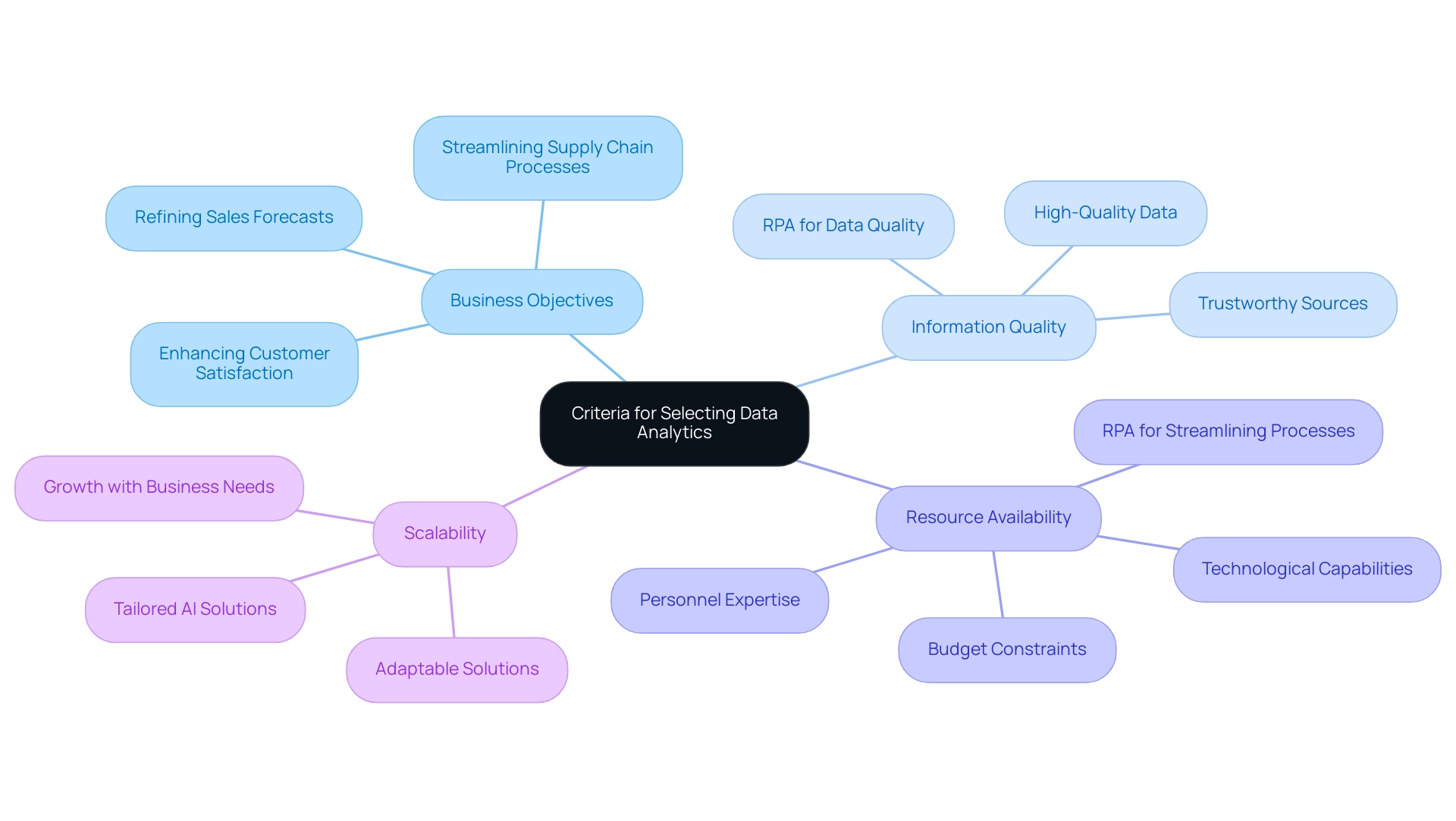
Exploring Different Types of Advanced Data Analytics
In the field of advanced information analysis, four primary types stand out, each designed to meet specific business needs:
- Descriptive Analytics: This foundational type emphasizes summarizing historical information, allowing entities to comprehend past occurrences and recognize key trends. By offering insights into performance measurement, descriptive analysis serves as a crucial tool for reporting and strategic planning. With services like Power BI, organizations can enhance their reporting capabilities, ensuring data consistency and actionable guidance. Recent statistics indicate that 65% of global enterprises are planning to increase their spending on data analysis, showcasing the widespread recognition of this type’s value.
Diagnostic Analysis: Building on descriptive analysis, diagnostic analysis delves deeper to uncover the reasons behind past events. By examining historical information for patterns and correlations, organizations can identify the factors influencing their performance. This type of analytics is essential for driving informed decision-making and addressing operational challenges. Utilizing robotic process automation (RPA) solutions, such as EMMA RPA and Microsoft Power Automate, can help streamline the collection process, making it easier to perform diagnostic analyses. EMMA RPA automates repetitive data entry tasks, while Power Automate facilitates seamless integration of various data sources, enhancing the overall efficiency of the diagnostic process.
-
Predictive Analysis: Leveraging statistical models and machine learning techniques, predictive analysis forecasts future outcomes based on historical trends. This powerful type enables organizations to anticipate customer behavior, recognize emerging trends, and identify potential risks, fostering proactive decision-making. According to Jan Hammond, Professor at Harvard Business School,
People that have those capabilities—as well as an understanding of business contexts—are going to be the ones that will add the most value and have the greatest impact.
This highlights the essential role of predictive analysis in developing successful business strategies, as it necessitates both technical abilities in information examination and strong communication skills to effectively convey insights. Tailored AI solutions can assist in improving data quality, further enhancing predictive capabilities. -
Prescriptive Analysis: As the most advanced form of analysis, prescriptive analysis goes beyond forecasting by providing actionable recommendations based on predictive insights. This type helps organizations determine optimal courses of action to achieve desired outcomes, thereby enhancing resource allocation and operational efficiency. Case studies, such as those concerning Domo’s applications, which produced an impressive 455% ROI over three years, demonstrate the significant financial advantages that can be attained through effective data analysis. Specifically, Domo’s applications had an estimated present value of $16 million, with a net present value of $13.2 million, highlighting the significant impact data analysis can have on a business’s bottom line. Furthermore, businesses adopting RPA solutions have indicated decreases in operational expenses by as much as 30%, highlighting the concrete financial advantages of these technologies.
By comprehending and utilizing the ability to select four types of advanced data analytics, along with creative tools like Power BI and RPA solutions, entities can greatly improve their operational effectiveness and achieve superior business results.
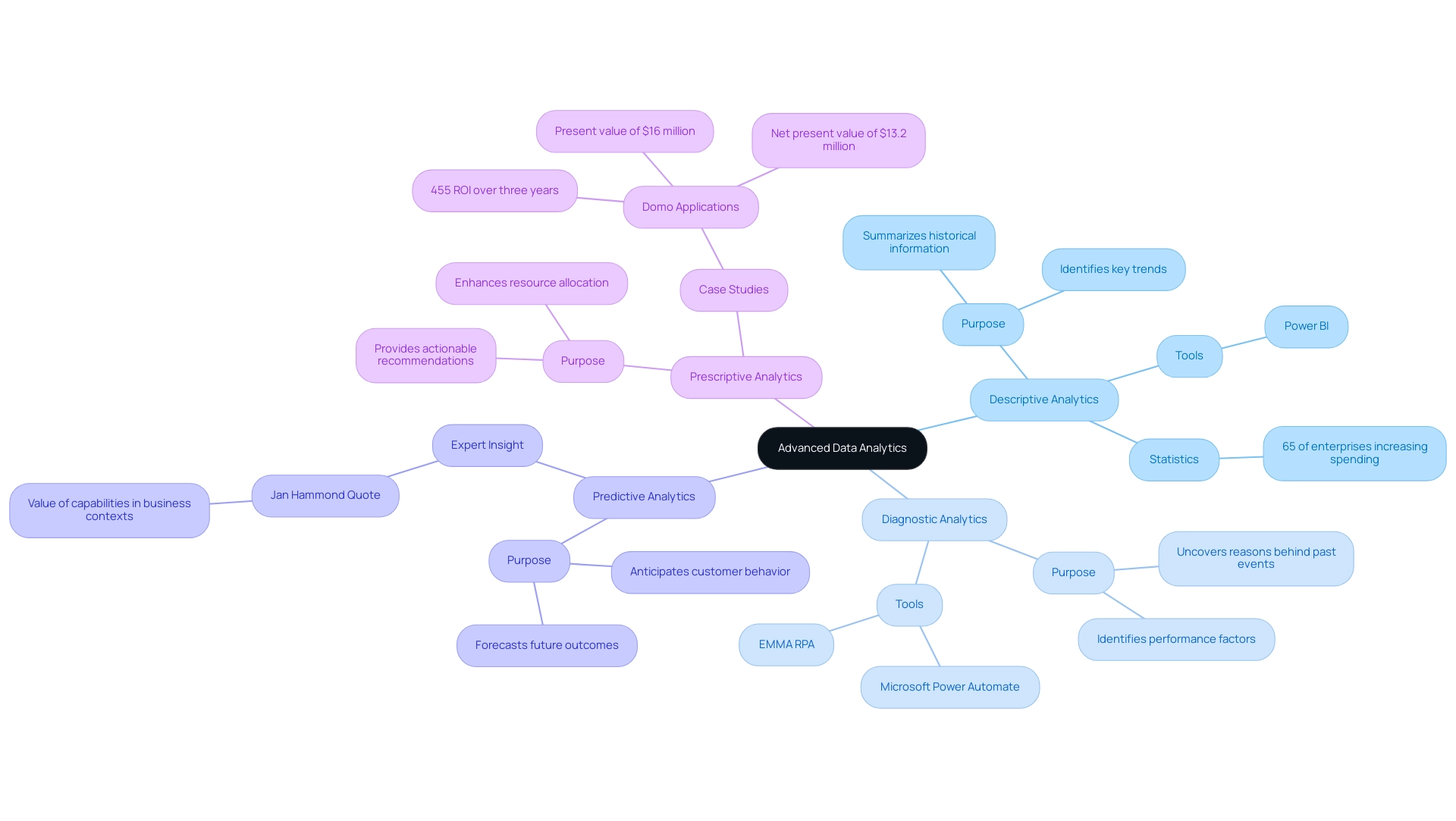
Implementing Advanced Data Analytics in Your Organization
Successfully executing sophisticated information analysis in your organization requires a strategic approach to select four types of advanced data analytics. Here are essential steps to guide you:
-
Define Clear Objectives: Begin by identifying specific business challenges or opportunities you aim to tackle through data analysis. Setting clear objectives is vital as they will influence your data strategy and guarantee that your efforts are focused and efficient.
-
Invest in the Right Tools: Select analytics tools that not only meet your business requirements but also fit your budget. In 2024, numerous organizations are opting for cloud-based solutions for their scalability and ease of access, enabling more flexible management and analysis. Consider utilizing services such as Creatum’s Power BI offerings, which provide custom dashboards and smooth information integration, essential for making informed decisions and driving actionable insights.
-
Build a Skilled Team: Assemble a proficient group equipped with essential skills in analysis, statistics, and relevant industry knowledge. This may involve training existing personnel or recruiting new talent. As Bob Frankston emphasizes, “This is a nuanced question. We trained generations of people to be ‘phone operators’ by making it easy to operate the phone. Today programming is increasingly becoming a trade.” This highlights the need for a nuanced approach to skill development, reinforcing the necessity for ongoing learning in the workforce. To facilitate this, Creatum offers expert training and support, ensuring your team can maximize Power BI’s capabilities.
-
Establish Governance: Implement robust governance practices to ensure quality, privacy, and compliance with regulations. This entails defining ownership of information, setting access controls, and establishing management protocols to protect your evaluation initiatives. For example, our Power BI Governance workshop tackles the necessity for clear access permissions and trust in data precision, guaranteeing that your data processing is both secure and effective.
-
Leverage RPA for Efficiency: Recognize that automation is vital in today’s fast-paced environment. Implementing Robotic Process Automation (RPA) can streamline manual workflows, reduce errors, and enhance operational efficiency, allowing your team to focus on strategic decision-making rather than repetitive tasks.
-
Iterate and Improve: Acknowledge that data analysis is an iterative process. Regularly review your strategy, tools, and outcomes to pinpoint opportunities for improvement. Fostering a culture of experimentation and learning within your establishment can significantly improve your data analysis skills and flexibility in a swiftly evolving job market. The case study titled ‘Co-evolving Work and Workers‘ illustrates that critical thinking remains a significant challenge as the workforce adapts to new technological realities, emphasizing the importance of ongoing training and development.
By adhering to these steps and using services such as the 3-Day Power BI Sprint to improve your report generation and insights utilization, along with custom dashboards and personalized AI solutions, your entity can position itself to select four types of advanced data analytics, which will drive informed decision-making and encourage innovation.
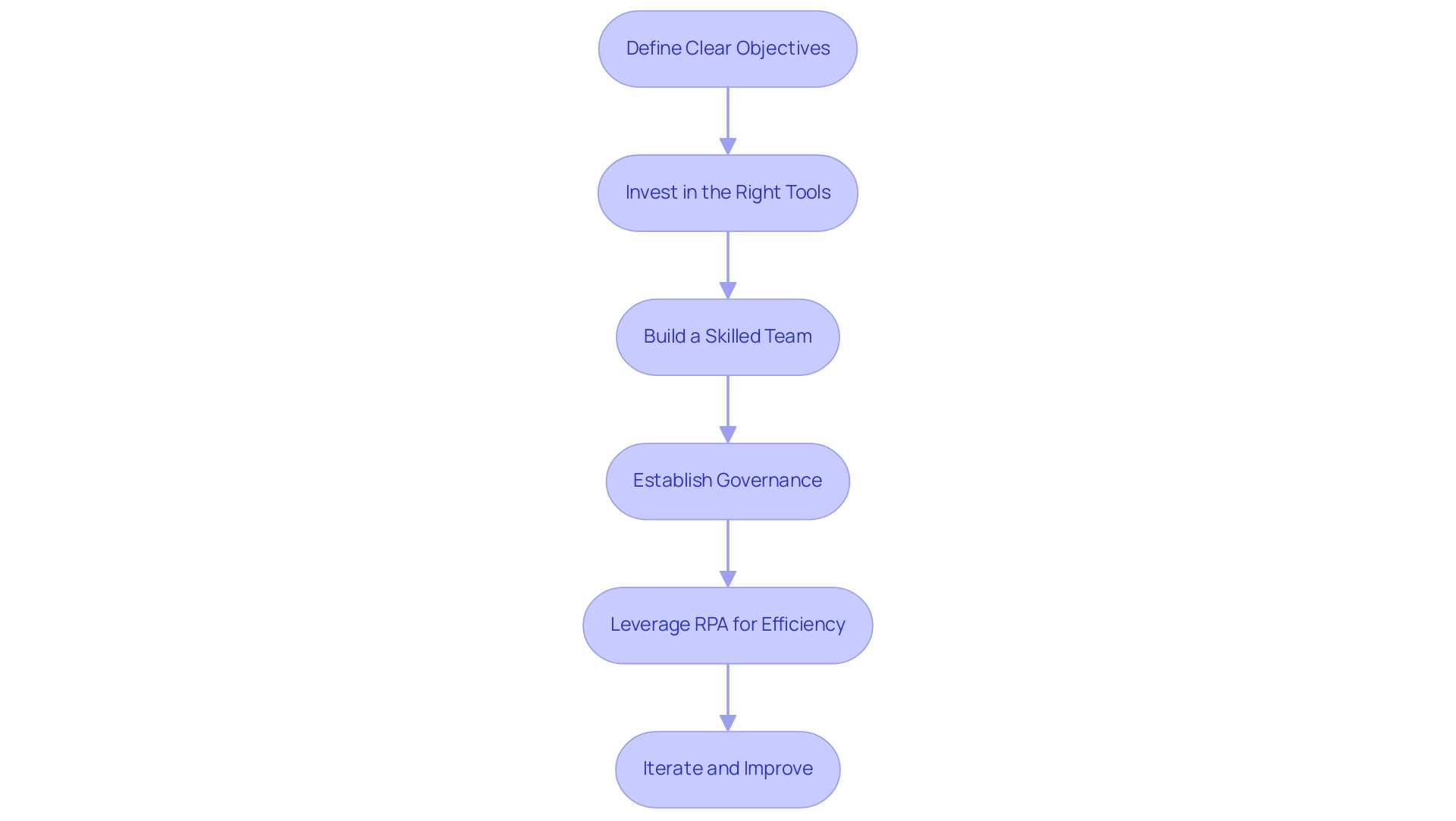
Measuring the Impact of Advanced Data Analytics
Assessing the impact of advanced data analysis within your organization necessitates a strategic approach that not only concentrates on performance metrics but also highlights the role of sales leadership in directing teams. Here are some effective strategies to consider:
- Define Key Performance Indicators (KPIs): Establishing KPIs that align with your business objectives is crucial.
These metrics can encompass revenue growth, cost savings, customer satisfaction, and operational efficiency. As you define these indicators, remember that they should serve as a compass guiding your evaluation efforts towards achieving tangible results. For example, a recent study showed that companies with well-defined KPIs saw a 20% increase in operational efficiency within a year, particularly when combined with insights garnered from Business Intelligence.
- Conduct Regular Reviews: Implement a schedule for periodic assessments to evaluate the performance of your data initiatives.
These reviews should focus on assessing whether the insights gained have translated into measurable improvements in decision-making and business outcomes. Regular analysis allows your team to stay aligned with strategic goals and make informed adjustments as needed.
Incorporating feedback from sales leaders during these reviews can enhance the effectiveness of your analysis efforts, especially in identifying areas where Robotic Process Automation (RPA) can streamline processes, reduce errors, and improve efficiency.
- Gather Feedback: Actively solicit input from stakeholders and users of data tools to gain insights into their experiences and challenges.
This feedback is invaluable for refining your data strategy and ensuring that it meets the needs of the organization effectively. Engaging users not only helps in identifying areas for improvement but also fosters a culture of collaboration and innovation. Furthermore, sharing motivational quotes from leaders, such as sending a daily email or posting them in break rooms, can reinforce the significance of data analysis and inspire the sales team.
- Adjust Strategies as Needed: The field of data analysis is ever-evolving, making it essential to be adaptable.
Utilize performance information and feedback to guide essential modifications to your evaluation method. Ongoing enhancement is crucial in maximizing the advantages of advanced data analysis, which can be achieved when we select four types of advanced data analytics and leverage RPA to eliminate manual workflows and improve operational efficiency.
As William James aptly stated,
Act as if what you do makes a difference.
It does.
Embrace this mindset, recognizing that your leadership in data analysis, particularly in guiding sales teams, can significantly impact your organization’s success. For instance, a case study demonstrated that a company’s shift in analytics strategy, driven by leadership input and supported by tailored AI solutions, resulted in a 30% increase in sales productivity over six months.
To learn more about how RPA and Business Intelligence can transform your operations and drive efficiency, book a free consultation with us today.
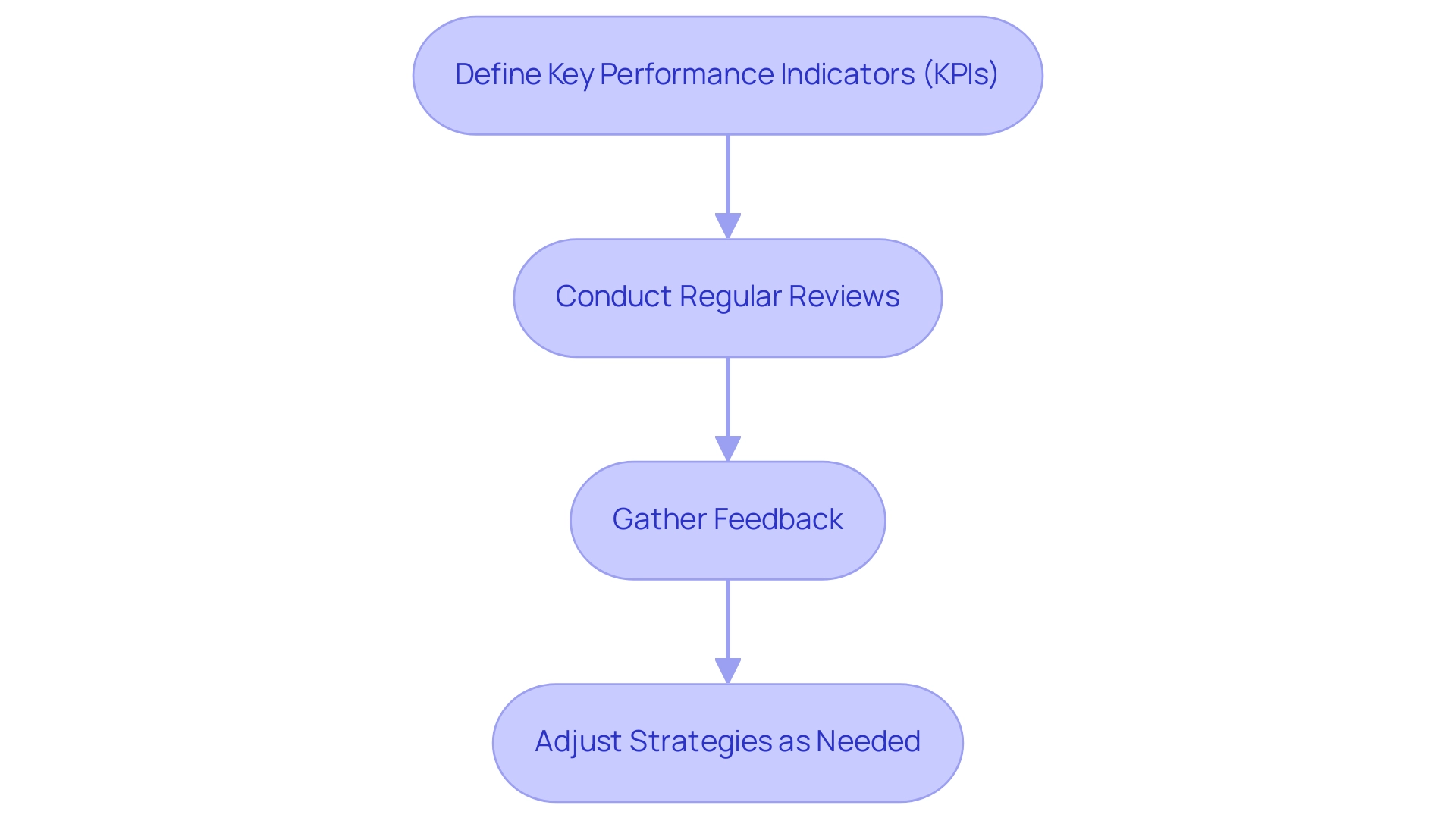
Conclusion
Advanced data analytics presents an invaluable opportunity for organizations striving to enhance decision-making and operational efficiency. By understanding the various types of analytics—descriptive, diagnostic, predictive, and prescriptive—companies can tailor their approaches to meet specific business objectives. The integration of Robotic Process Automation (RPA) further amplifies these efforts, streamlining workflows and improving data quality, which are critical components of successful analytics implementation.
Selecting the right analytics tools involves a thoughtful assessment of:
- Business goals
- Data quality
- Available resources
- Scalability
Organizations that prioritize these criteria are better positioned to leverage the full potential of advanced analytics, ultimately driving growth and innovation. As the landscape continues to evolve, the importance of establishing clear objectives and fostering a skilled team cannot be overstated. Continuous learning and adaptability are essential as businesses navigate the complexities of data-driven environments.
Measuring the impact of advanced analytics through well-defined Key Performance Indicators (KPIs) and regular reviews ensures that organizations remain aligned with their strategic goals. Gathering feedback and adjusting strategies based on performance data fosters a culture of improvement and collaboration. Embracing these practices empowers organizations to make informed decisions and harness the transformative power of data analytics, paving the way for sustained success in an increasingly competitive marketplace.
Introduction
In an era where data drives decisions and shapes strategies, mastering Business Intelligence (BI) is more crucial than ever. Organizations are increasingly turning to Power BI, a powerful tool that transforms raw data into insightful narratives, enabling smarter decision-making and enhanced operational efficiency.
As the reliance on AI technologies grows, with a significant percentage of business leaders optimistic about their impact, the demand for professionals skilled in BI is surging. This article delves into the multifaceted world of Power BI training, exploring the essential skills acquired, various learning formats available, and the promising career opportunities that await graduates.
By understanding how to harness these tools effectively, professionals can position themselves at the forefront of the data revolution, ready to tackle the challenges of today’s dynamic business environment.
Introduction to Business Intelligence Courses: The Role of Power BI
In today’s information-driven landscape, the availability of BI courses online has become essential for organizations seeking to leverage insights effectively amidst the challenges and reluctance in adopting AI. Power BI stands out as a leading tool for information visualization and analysis, empowering businesses to convert raw information into actionable insights, thus enhancing informed decision-making and driving efficiency. Notably, 74% of business owners expect AI to generate customer responses, such as chatbots, highlighting the growing reliance on AI technologies in business processes.
Furthermore, 97% of business owners express confidence that tools like ChatGPT will improve their operations, emphasizing the necessity for professionals to be well-versed in BI technologies. The Hanlon Financial Systems Center at Stevens exemplifies how organizations are investing in technology and resources to enhance information management and analysis skills. Additionally, the integration of Small Language Models (SLMs) can address concerns about poor master information quality by offering efficient, secure, and cost-effective analysis.
These models can help mitigate issues of inconsistency and inaccuracies, leading to improved operational efficiency. In this rapidly evolving AI landscape, leveraging Robotic Process Automation (RPA) can further streamline manual workflows, enhancing operational efficiency. Organizations can effectively integrate AI into their existing processes by adopting a phased approach, starting with pilot projects that allow for gradual adaptation and learning.
A practical example can be seen in the BIA 679 Big Information Practicum course, a BI course online, where students learn to navigate the entire value chain for information-intensive products and services through hands-on projects, ultimately creating case studies of complete information pipelines. This experience not only enhances their critical thinking and technical skills but also positions professionals equipped with BI expertise, SLM insights, and RPA solutions as invaluable assets across various industries. To explore how these technologies can transform your operations, consider booking a consultation to discuss tailored solutions.

Key Skills and Knowledge Acquired in Power BI Training
Participants in the BI course online are equipped with a comprehensive suite of skills essential for effective analysis and visualization. They explore essential competencies such as:
- Information modeling
- Report creation
- Dashboard design
These skills are pivotal in translating complex datasets into actionable insights. This training tackles common challenges such as:
- The excessive time spent on report creation
- Inconsistencies in information across reports
- The frequent absence of clear, actionable guidance
A significant focus is placed on DAX (Data Analysis Expressions), enabling learners to perform intricate calculations that enhance their analytical capabilities. Furthermore, grasping how to link BI with diverse information sources further broadens their toolkit, enabling them to create engaging visual stories. As one industry expert states, ‘the ability to weave storytelling into insights is vital, as it helps communicate the significance of findings to non-experts.’
This fusion of technical prowess and narrative skill positions individuals as invaluable assets in the workforce, driving operational efficiency and informed decision-making. Additionally, RPA solutions complement these skills by automating repetitive tasks, further enhancing operational efficiency. Moreover, with the increasing need for data-related skills emphasized by programs such as the Google Cybersecurity – December 2024 Cohort, which takes place from December 1, 2024, to April 1, 2025, for only $20, the importance of Power BI education is highlighted.
This BI course online not only prepares participants for analysis but also emphasizes the importance of cybersecurity in protecting information integrity. Additionally, the case study ‘Foundations of Restorative Justice Practices’ showcases how the skills acquired in preparation can be applied effectively in real-world scenarios, illustrating the practical impact of data analysis and visualization in various fields.
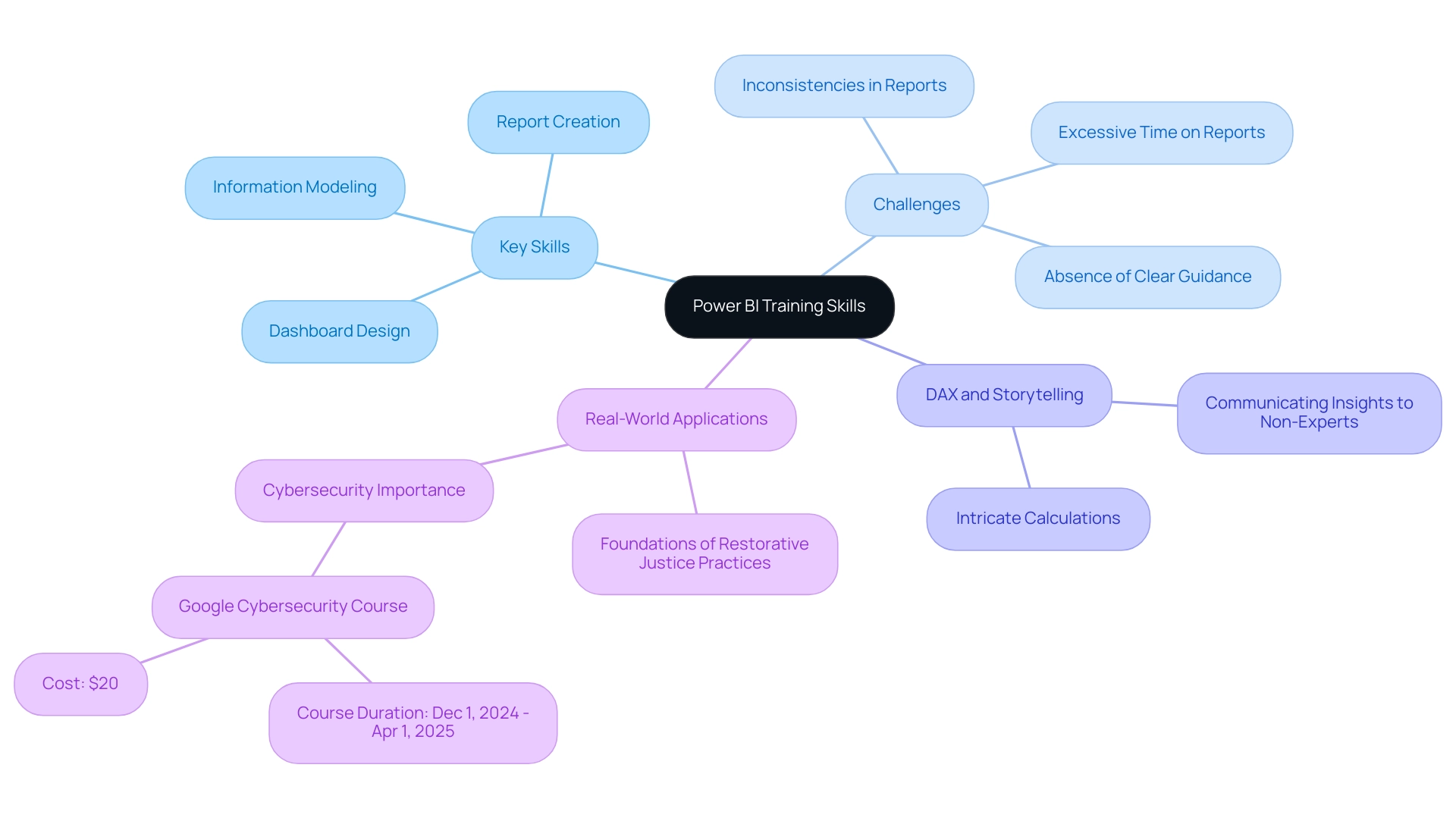
Exploring Different Formats of Power BI Training
BI instruction is offered in various formats, each customized to accommodate different educational preferences and timetables. Instructor-led live sessions facilitate real-time interaction with seasoned experts, providing immediate feedback and the opportunity to clarify complex concepts. This format is particularly effective for those who thrive in collaborative environments.
As Maggie, a Data Scientist in Product Analytics, states, “If you want to transition into more of a machine intelligence role, the above will assist you in researching and constructing your model, but you’ll also need to acquire frameworks for deploying your models.” This emphasizes the importance of Power BI training as a basis for further exploration in data science and machine learning. Conversely, self-paced online courses, including a BI course online, empower individuals to navigate their educational journey at their own pace, making them an excellent choice for busy professionals balancing multiple commitments.
These courses encourage autonomy and enable learners to absorb material in a manner that best fits their educational style. Furthermore, hybrid models combine the advantages of both methods, providing a well-rounded educational experience that includes structured guidance alongside adaptable opportunities. A case study titled “Promoting Diverse Instructional Approaches” illustrates how STAT encourages a broader understanding of development beyond traditional classroom settings, advocating for various educational methods such as on-the-job experience, mentoring, and e-learning.
This approach fosters a culture of self-sufficiency and continuous learning within the NSO, enhancing staff development and motivation. Moreover, considering the difficulties of lengthy report generation and inconsistencies in information, choosing the appropriate format for the BI course online instruction becomes essential. By equipping teams with the skills to create efficient reports and ensuring information governance, organizations can transform their reporting processes.
Statistics suggest that various formats can greatly influence learning effectiveness, emphasizing the necessity of aligning training with personal and professional commitments to ensure successful mastery of BI and drive actionable insights that lead to enhanced operational efficiency.
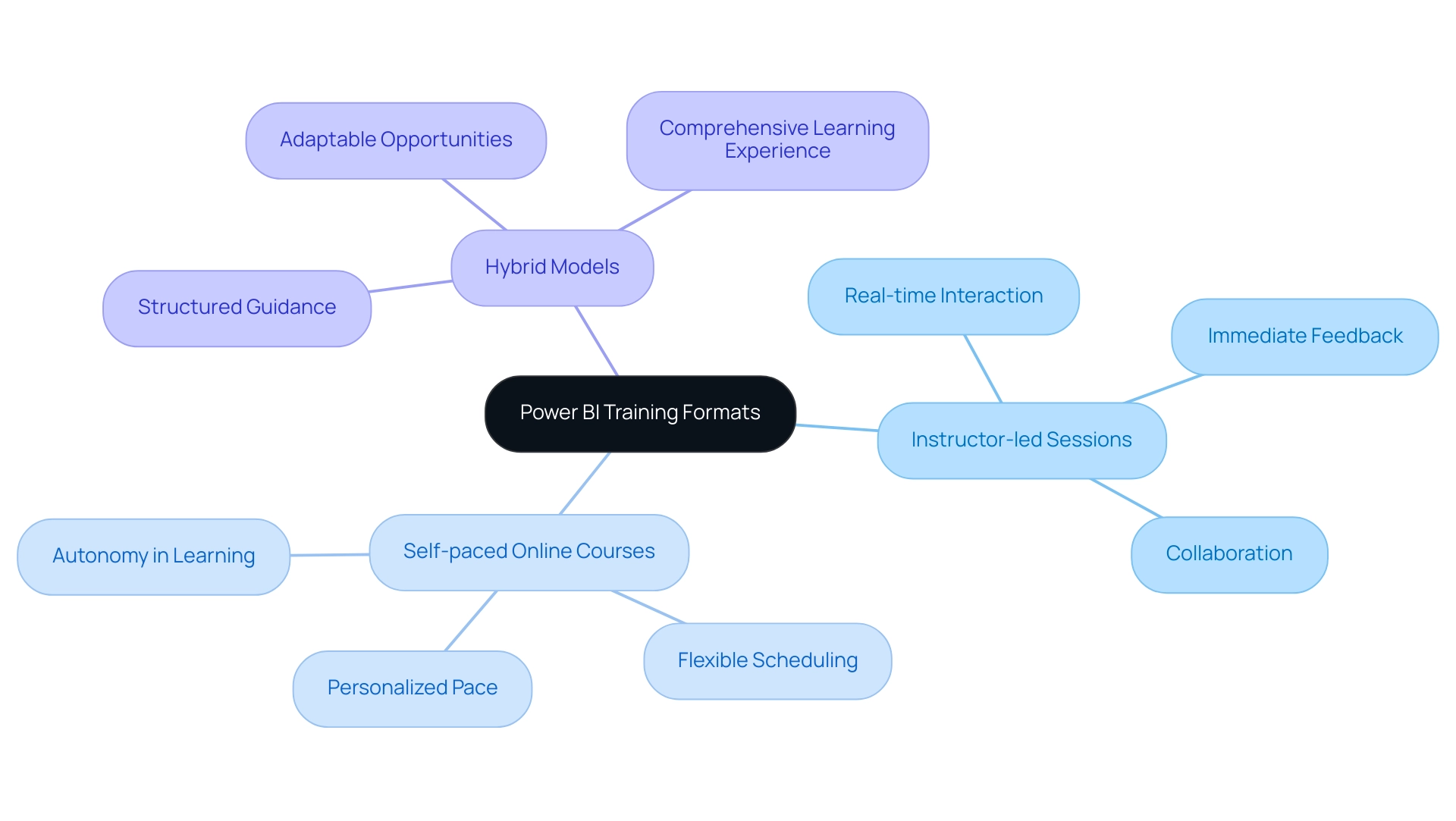
Career Opportunities After Completing a Power BI Course
Completing a BI course online opens up numerous career options in analysis, business intelligence, and visualization. Graduates can pursue roles such as:
- Business Intelligence Analyst
- Data Analyst
- Reporting Specialist
Significantly, BI Consultants oversee projects autonomously and create tailored solutions that improve organizational decision-making, thus playing an essential role in tackling the common issues of lengthy report generation and inconsistencies.
Tools such as EMMA RPA and Automate can further streamline these processes, enabling organizations to automate repetitive tasks and concentrate on deriving insights from their data. The financial prospects in these fields are promising, with entry-level positions typically starting at competitive salaries. For instance, BI Consultants earn between $96,000 and $132,000 annually, reflecting the strong demand for professionals skilled in this tool.
A 2023 survey from the Bureau of Labor Statistics revealed that individuals with relevant certifications or licenses experience lower unemployment rates and higher average earnings compared to their non-certified counterparts. As industries increasingly depend on data-driven decision-making, the need for BI expertise continues to grow, making a BI course online a strategic investment for career advancement. Moreover, a case study on BI Consultants demonstrates how they provide a comprehensive array of services to assist organizations in optimizing their information, aligning solutions with business objectives and improving BI capabilities.
Additionally, 75% of Google Career Certificate Graduates reported positive job outcomes within six months of completing their certification, underscoring the significant value of acquiring such skills in today’s competitive job market.
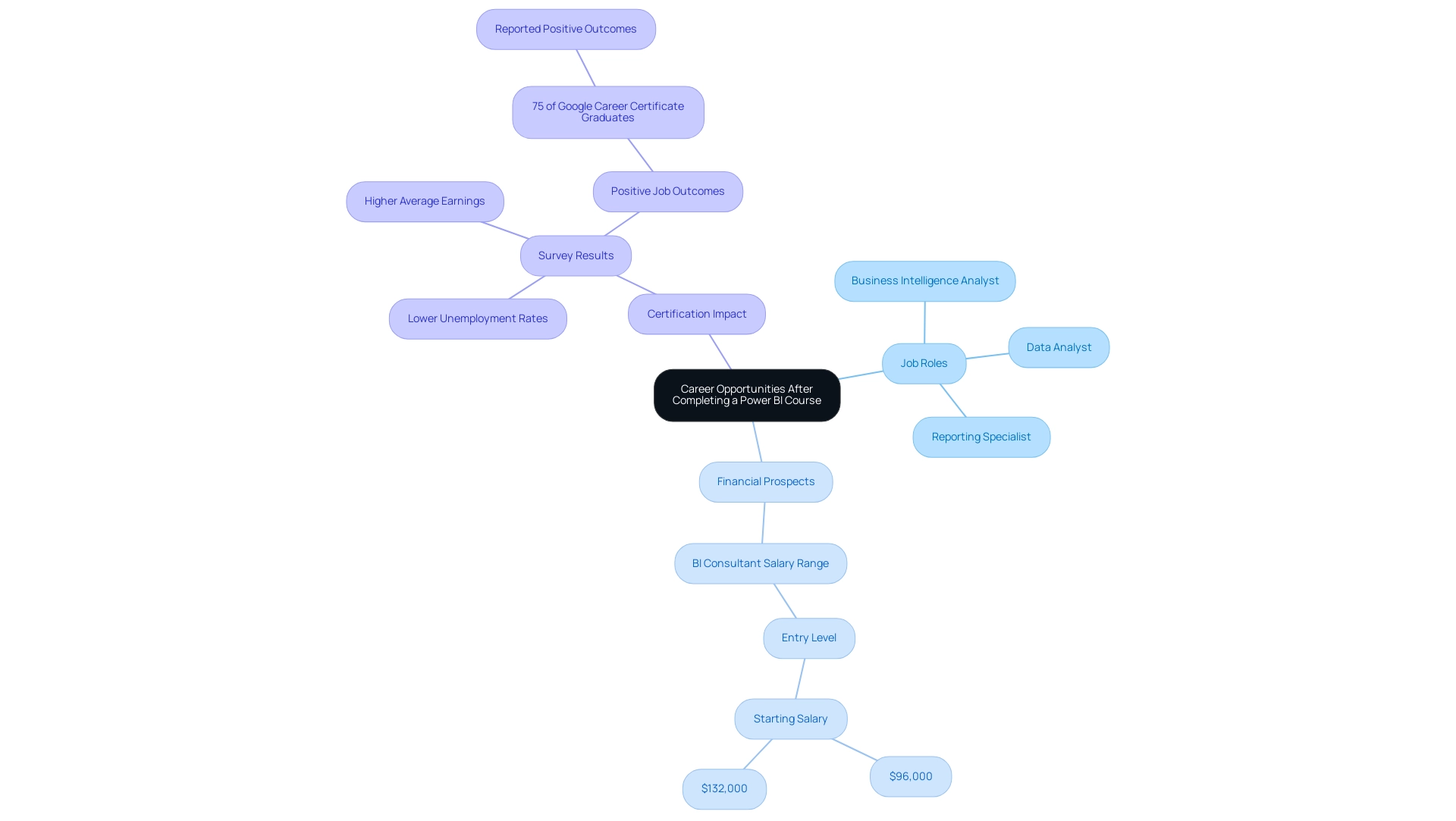
Are You Ready for Power BI Training? Prerequisites and Considerations
When considering enrollment in a BI course, it’s crucial for prospective learners to evaluate their current skill level and understanding of data concepts, especially in light of common operational challenges. Many professionals find themselves investing excessive time in report creation rather than leveraging actionable insights from BI dashboards. This BI course online is designed specifically for beginners, providing essential foundational knowledge to effectively tackle these issues.
Notably, proficiency in Excel is a key asset that can significantly enhance the learning experience in BI. Moreover, experts with certifications or licenses experience lower unemployment rates and receive higher wages than those lacking them, highlighting the importance of pursuing Power BI education. The Microsoft Copilot for Data Science Specialization, for example, offers practical experience intended to assist participants in utilizing generative AI tools for significant insights.
By empowering learners to assess their readiness and stay open to new challenges, this training equips them to address the prevalent issues of data inconsistencies, the lack of actionable guidance in their reporting processes, and the need for a governance strategy. Thus, recognizing the value of being well-prepared is essential as they embark on their Power BI journey, ensuring they are ready to thrive in this dynamic field.
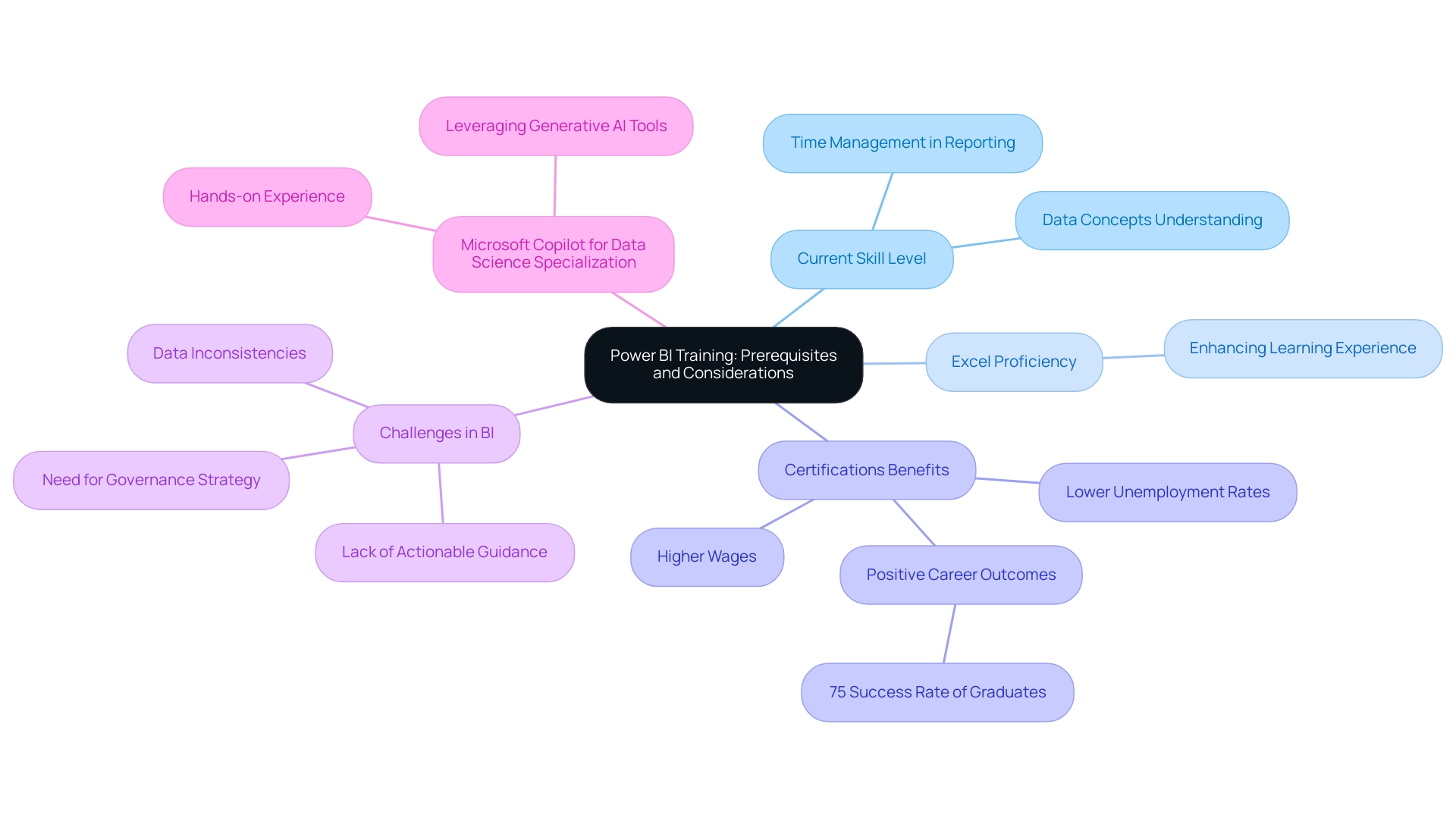
Conclusion
Harnessing the power of Business Intelligence through training in Power BI is a transformative step for professionals aiming to excel in today’s data-centric environment. As explored in this article, Power BI equips individuals with essential skills in data analysis, visualization, and report creation, empowering them to derive actionable insights that drive informed decision-making and operational efficiency.
The diverse formats of Power BI training—ranging from instructor-led sessions to self-paced online courses—cater to varied learning preferences, ensuring that professionals can find an approach that suits their needs. This flexibility not only fosters a culture of continuous learning but also addresses common challenges like time-consuming report creation and data inconsistencies, ultimately streamlining processes and enhancing productivity.
The career opportunities available upon completing Power BI training are abundant and lucrative, with roles such as Business Intelligence Analyst and Power BI Consultant in high demand. The growing reliance on data-driven strategies underscores the importance of acquiring these skills, as they not only enhance individual career prospects but also contribute to organizational success.
As the landscape of AI and data analysis continues to evolve, embracing Power BI training is not just an option but a strategic necessity. By investing in these skills, professionals position themselves at the forefront of the data revolution, ready to tackle the challenges of modern business and unlock new opportunities for growth. The time to act is now—equip yourself with the knowledge and tools to thrive in this dynamic field.
Introduction
In a world increasingly driven by data, organizations that harness the power of analytics stand to gain a significant competitive advantage. Data analytics transforms vast amounts of raw information into actionable insights, enabling companies to optimize processes, enhance operational efficiency, and foster innovation.
As businesses face the dual challenges of navigating complex data landscapes and integrating advanced technologies, understanding the various types of analytics becomes essential. From descriptive to predictive, prescriptive, and diagnostic analytics, each type offers unique benefits that can drive informed decision-making.
However, the journey toward effective analytics implementation is not without its hurdles. By exploring practical solutions and leveraging tools like Robotic Process Automation (RPA) and tailored AI models, organizations can not only overcome these challenges but also position themselves for future success in an ever-evolving digital landscape.
Understanding Data Analytics: Definition and Importance
Data analysis involves the systematic computational examination of information, which encompasses types of data analytics with examples, aimed at discovering patterns, drawing conclusions, and supporting decision-making. In today’s information-rich environment, organizations leverage various types of data analytics with examples, including statistical analysis, to convert raw information into actionable insights, enabling them to optimize processes, enhance efficiency, and drive innovation. Overcoming common perceptions of AI as time-intensive and costly, our custom Small Language Models (SLMs) provide efficient, secure, and economical analysis tailored to specific industry needs.
Unlike traditional AI solutions, SLMs can be deployed on-premises, ensuring enhanced privacy and compliance while requiring less computational power, making them more affordable to implement and maintain. Furthermore, by implementing Robotic Process Automation (RPA), businesses can automate manual workflows, significantly enhancing operational efficiency. The significance of information analysis, specifically in the context of types of data analytics with examples, lies in its capacity to offer companies a competitive advantage, enabling informed decision-making and enhancing operational results through Business Intelligence.
As organizations increasingly depend on information to guide their strategies, understanding the different types of data analytics with examples becomes essential for success.

Exploring the Four Main Types of Data Analytics: Descriptive, Predictive, Prescriptive, and Diagnostic
- Descriptive Analytics: This is one of the types of data analytics with examples that focuses on summarizing historical information to understand what has occurred in the past. It frequently encompasses information aggregation and mining techniques to offer insights into trends and patterns. For instance, a retail firm might employ descriptive analysis to examine sales information from the prior year to pinpoint peak sales times. Power BI services enhance this process by ensuring efficient reporting and consistency, thereby providing clear, actionable guidance that can be further refined through RPA solutions.
Predictive analysis is one of the types of data analytics with examples, as it employs statistical algorithms and machine learning methods to determine the probability of future results based on historical information. For example, a financial organization might utilize predictive techniques to evaluate the risk of loan defaults by examining customer information and payment histories. Utilizing AI technologies, such as Small Language Models, can improve data quality and enhance the accuracy of these predictions, while RPA can automate data collection and processing, making the predictive assessment process more efficient.
-
Prescriptive Analysis: This is one of the types of data analytics with examples, as it goes a step further by recommending actions based on predictive analysis. It uses optimization and simulation algorithms to suggest the best course of action. For example, a supply chain manager may use prescriptive analysis to determine the optimal inventory levels to minimize costs while satisfying customer demand. Robotic Process Automation (RPA), particularly tools like EMMA RPA and Microsoft Power Automate, can facilitate these recommendations by automating the processes involved, enhancing operational efficiency and employee morale.
-
Diagnostic Analysis: This is one of the types of data analytics with examples, as it aims to clarify why an event occurred by examining historical performance. It frequently involves information discovery and correlation techniques. For example, a healthcare provider might use diagnostic analysis to identify the reasons for increased patient readmission rates by examining patient demographics and treatment histories. Integrating RPA solutions can streamline this workflow, allowing teams to focus on strategic, value-adding tasks instead of manual data processing. Additionally, utilizing AI-driven tools can further improve the quality of insights obtained from diagnostic analysis.
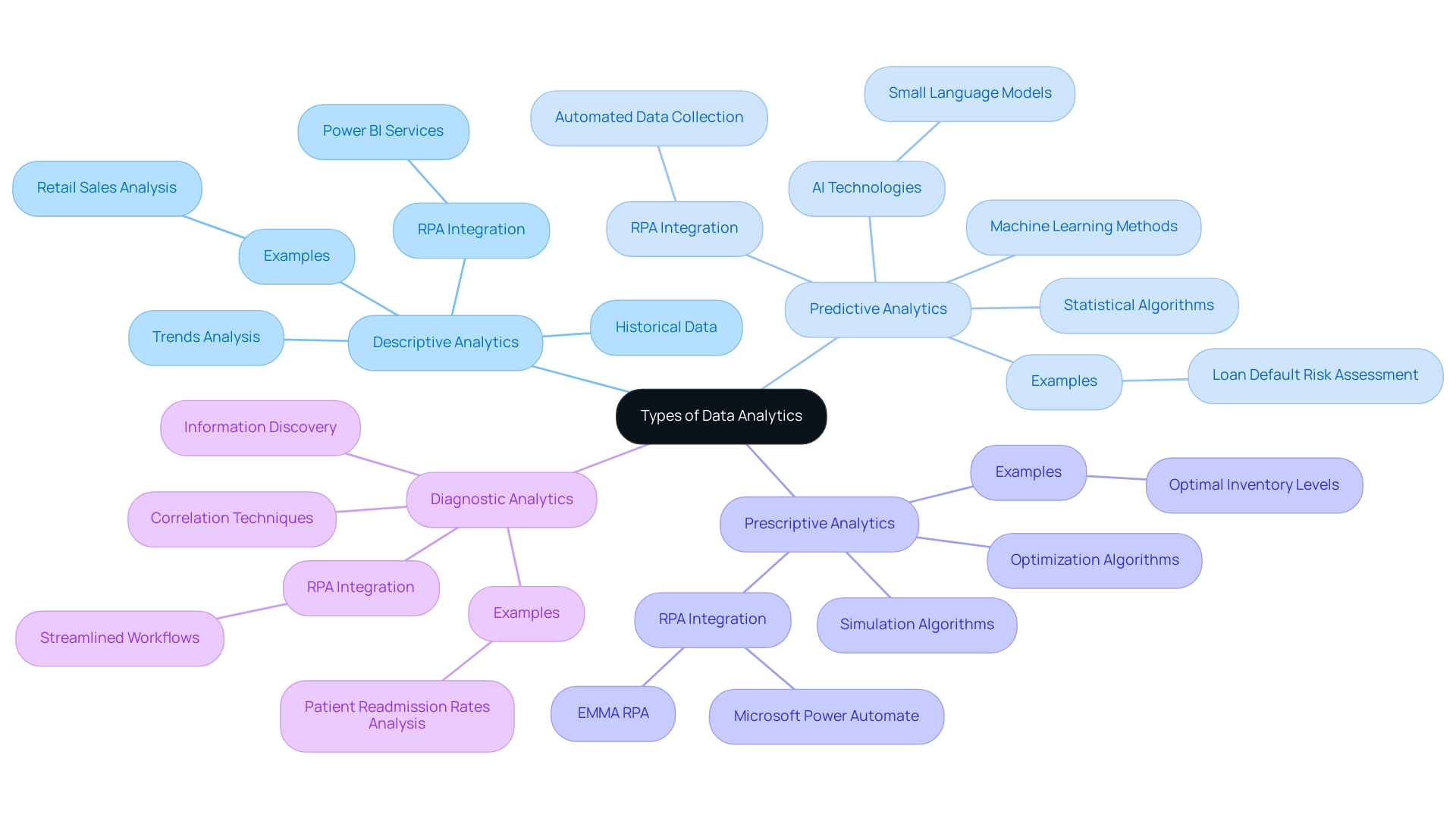
Real-World Applications: Examples of Each Type of Data Analytics
Descriptive analysis is one of the types of data analytics with examples that is commonly used in marketing to examine customer behavior and preferences. For instance, Netflix employs descriptive analysis to comprehend viewer demographics and viewing habits, enabling them to customize content suggestions. Integrating Robotic Process Automation (RPA) can enhance the efficiency of gathering and processing this information, minimizing manual efforts and reducing errors.
This is especially crucial in tackling the challenge of insufficient insight-driven information, as RPA can automate information collection processes, ensuring prompt and precise details.
Among the types of data analytics with examples, predictive analysis finds applications in various sectors, such as retail, where companies like Amazon utilize it to anticipate demand for products based on historical buying patterns, thereby enhancing inventory management. Implementing RPA solutions can automate information gathering processes, ensuring that predictive models are based on real-time information, which is essential in today’s rapidly evolving AI landscape. This capability assists businesses in staying ahead of market trends and making informed decisions.
In healthcare, prescriptive analysis is one of the types of data analytics with examples that is utilized to improve patient outcomes. For example, hospitals employ prescriptive analysis to identify the optimal treatment plans for patients based on historical treatment information and patient traits. RPA can streamline administrative tasks in this context, allowing healthcare professionals to focus on patient care rather than paperwork, thereby improving operational efficiency and patient satisfaction.
In finance, diagnostic analysis is an important example of the types of data analytics with examples that are widely applied. Banks examine transaction information to identify fraudulent activities. For example, a bank may use diagnostic analytics to investigate unusual spending patterns and flag them for further review.
The integration of Business Intelligence tools with RPA can significantly accelerate this process, transforming raw information into actionable insights that drive informed decision-making and enhance operational efficiency. By leveraging RPA, banks can enhance their fraud detection capabilities, addressing the challenges posed by increasingly sophisticated fraudulent activities.
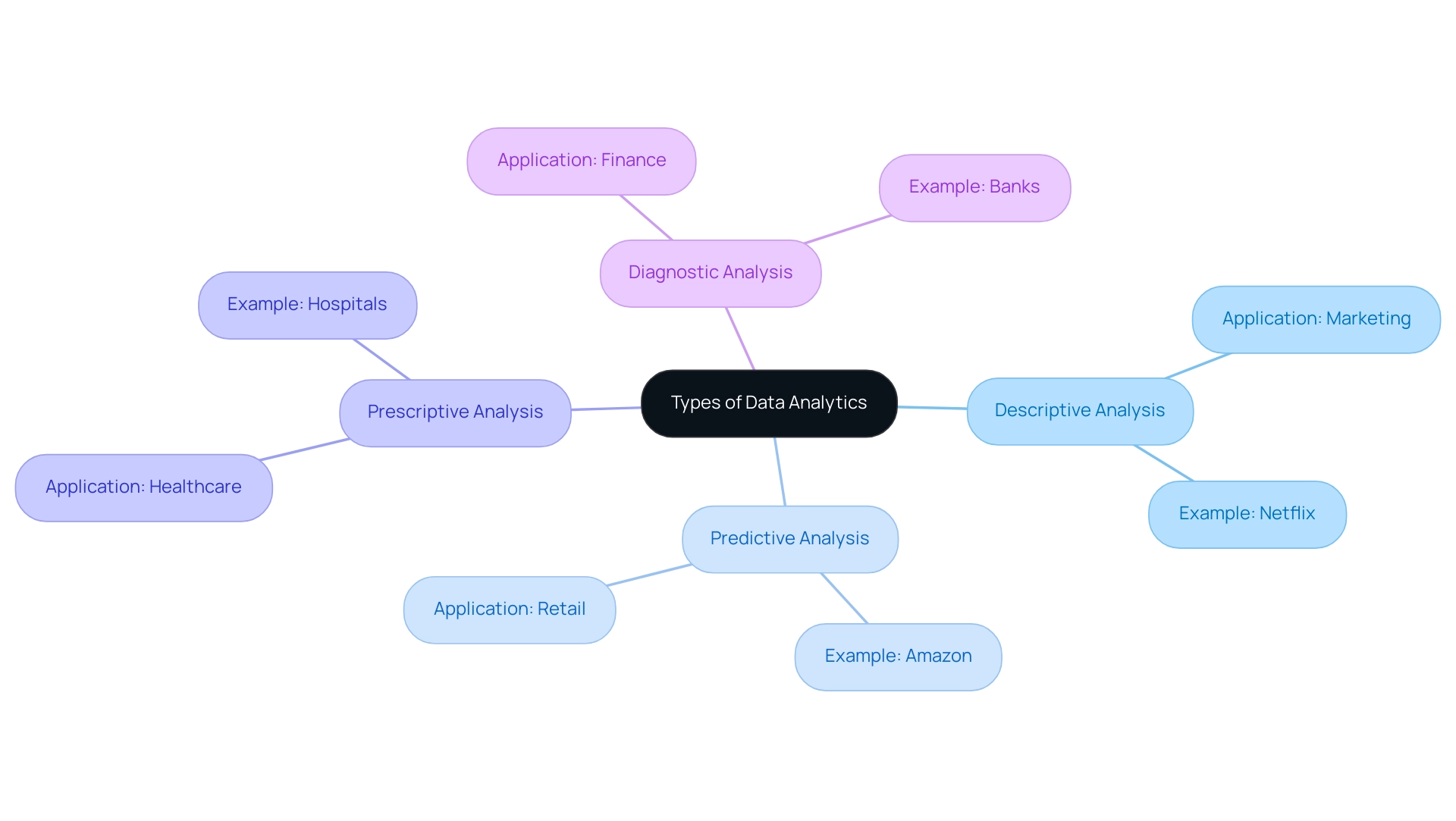
Benefits and Challenges of Different Data Analytics Approaches
The advantages of information analysis include various types of data analytics with examples, which offer numerous benefits such as better decision-making, improved operational efficiency, and the capability to recognize new business opportunities. For example, organizations utilizing predictive data analysis, which is one of the types of data analytics with examples, can anticipate market trends, allowing them to stay ahead of competitors. However, challenges such as poor master information quality, the need for skilled personnel, and potential resistance to change remain prevalent.
- Inconsistent, incomplete, or inaccurate data can severely compromise insights.
- A shortage of skilled analysts may hinder effective analytics implementation.
- Furthermore, integrating AI solutions can seem daunting, but with tailored strategies and Robotic Process Automation (RPA) tools like EMMA RPA and Microsoft Power Automate, companies can overcome these barriers. These solutions not only automate manual workflows but also improve efficiency and accuracy.
Empowering employees through change management strategies fosters cooperation and engagement, ensuring a smoother transition to data-driven practices that significantly improve efficiency and drive growth.
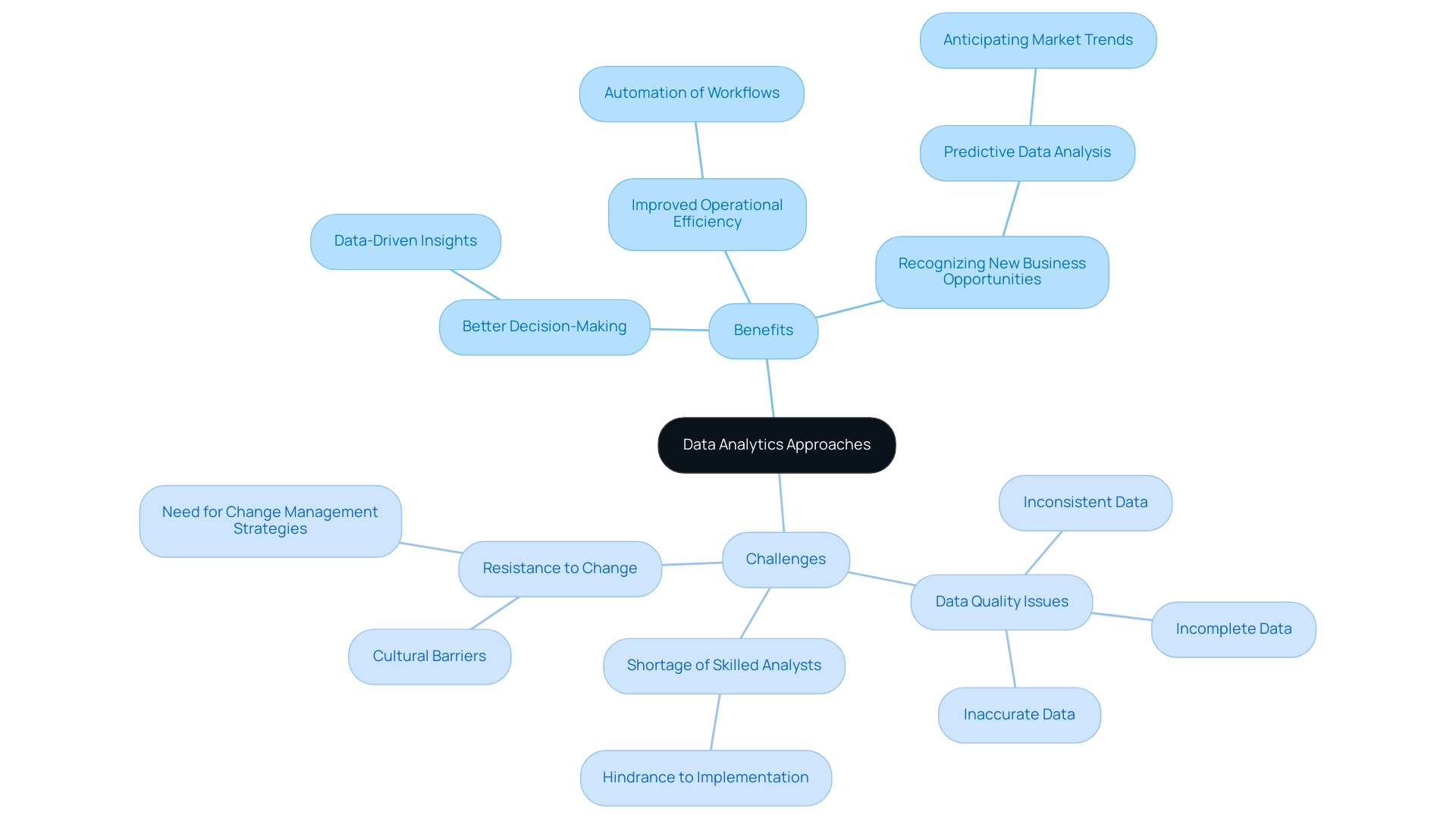
Future Trends in Data Analytics: What Lies Ahead
As technology continues to progress, several trends are influencing the future of data analysis. The incorporation of artificial intelligence and machine learning is anticipated to improve predictive and prescriptive data analysis abilities, allowing organizations to make even more informed decisions. Furthermore, the rise of real-time analytics will allow businesses to act on insights instantaneously, improving responsiveness and agility.
In this rapidly evolving AI landscape, leveraging Robotic Process Automation (RPA) can significantly streamline manual workflows, reduce operational redundancies, minimize errors, and enhance overall efficiency.
By freeing up teams for more strategic, value-adding work, organizations can overcome the perceived complexities and costs often associated with AI adoption. Tailored solutions such as Small Language Models (SLMs) can offer efficient, secure, and cost-effective analysis. Furthermore, the growing emphasis on quality is vital, as poor master information can obstruct AI adoption and result in flawed decision-making.
Organizations must adopt responsible data practices to ensure compliance with regulations while maintaining customer trust. As businesses navigate these trends, those that embrace innovation and adapt to the evolving analytics landscape will be better positioned to thrive in a data-driven world, turning challenges into opportunities for growth. For effective implementation, consider starting with a consultation to explore how RPA and AI solutions can be tailored to your specific needs.
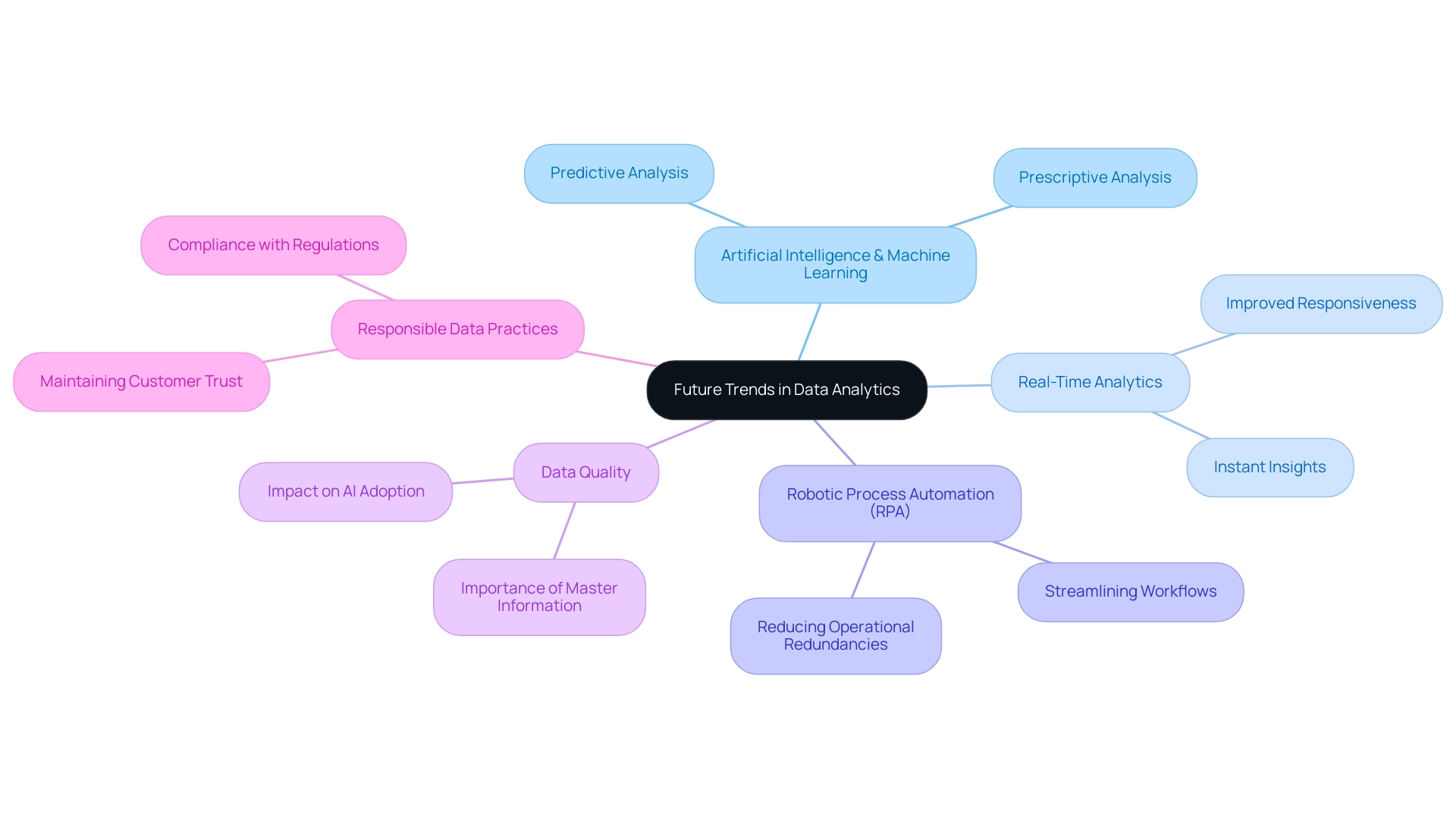
Conclusion
The power of data analytics is undeniable in today’s competitive landscape. By effectively harnessing various types of analytics—descriptive, predictive, prescriptive, and diagnostic—organizations can transform raw data into meaningful insights that drive informed decision-making and operational efficiency. The integration of tools such as Robotic Process Automation (RPA) and Small Language Models (SLMs) not only simplifies the analytics process but also enhances accuracy and reduces costs, making advanced data solutions accessible for businesses of all sizes.
While the journey toward effective analytics implementation may present challenges, such as data quality issues and the need for skilled personnel, these hurdles can be overcome with tailored strategies and the right technology. Embracing change management practices will empower teams to adopt data-driven methodologies that enhance productivity and foster innovation.
Looking ahead, the future of data analytics is bright, with advancements in AI and machine learning set to further refine predictive and prescriptive capabilities. Organizations that prioritize data quality and adaptability will be well-equipped to navigate the evolving landscape, turning potential challenges into opportunities for growth. By investing in the right analytics solutions, businesses can position themselves for sustained success in a data-driven world.
Introduction
In an era where efficiency and innovation are paramount, Robotic Process Automation (RPA) emerges as a game-changing solution for organizations striving to enhance their operational frameworks. By deploying software bots to automate repetitive tasks, businesses can not only reduce human error but also free their workforce to focus on strategic initiatives that drive growth. The benefits of RPA extend beyond mere cost savings; they encompass:
- Improved accuracy
- Scalability
- Employee satisfaction
However, the path to successful RPA implementation is fraught with challenges, including:
- Resistance to change
- Integration issues
Understanding these dynamics is crucial for organizations eager to harness the full potential of automation. As RPA continues to evolve, embracing emerging trends like hyperautomation and intelligent automation will be essential for staying competitive in a rapidly changing landscape.
What is Robotic Process Automation (RPA)?
Robotic Process Automation (RPA) capabilities are a transformative technology enabling organizations to deploy software robots, or ‘bots’, to automate repetitive and rule-based tasks traditionally handled by human workers. These bots emulate human actions, interacting with applications to carry out essential functions such as data entry, transaction processing, and records management, all without the need for direct human oversight. The RPA capabilities enable businesses to streamline operations, significantly lowering the chances of human error and improving overall operational performance.
Recent data indicates that RPA can increase productivity by enabling digital workers to undertake mundane tasks, which in turn allows employees to focus on higher-value activities. Furthermore, a notable 57% of executives report that RPA capabilities not only boost efficiency but also enhance employee engagement, allowing team members to devote their efforts to more strategic initiatives. Solutions such as EMMA RPA and Microsoft Power Automate illustrate user-friendly digitalization and business process streamlining, equipping companies with the resources to address outdated systems and improve productivity.
EMMA RPA, specifically, transforms how businesses handle automated processes, providing seamless digitalization and various applications. These RPA solutions improve RPA capabilities by specifically addressing challenges such as task repetition fatigue and staffing shortages through the automation of routine tasks, thus allowing human workers to engage in more meaningful work. To effectively implement RPA capabilities, organizations need a comprehensive platform that supports end-to-end processes, ensuring seamless integration across various workflows.
A pertinent example can be observed in the airline sector, where RPA has been effectively used to automate air traffic control processes, traveler information management, and crew scheduling, resulting in improved operational performance and enhanced customer experience. The case study of a mid-sized company demonstrates how GUI mechanization tackled issues such as manual data entry mistakes and slow software testing, resulting in an impressive 70% decrease in data entry errors and an 80% enhancement in workflow productivity within six months. The integration of RPA capabilities into business processes is a pivotal step towards achieving an agile and responsive operational framework, making it an essential consideration for forward-thinking organizations.
Furthermore, the visual depiction of a person working alongside amiable robotic figures emphasizes the synergy between human intelligence and automation, reinforcing the concept of improved operational productivity through RPA.
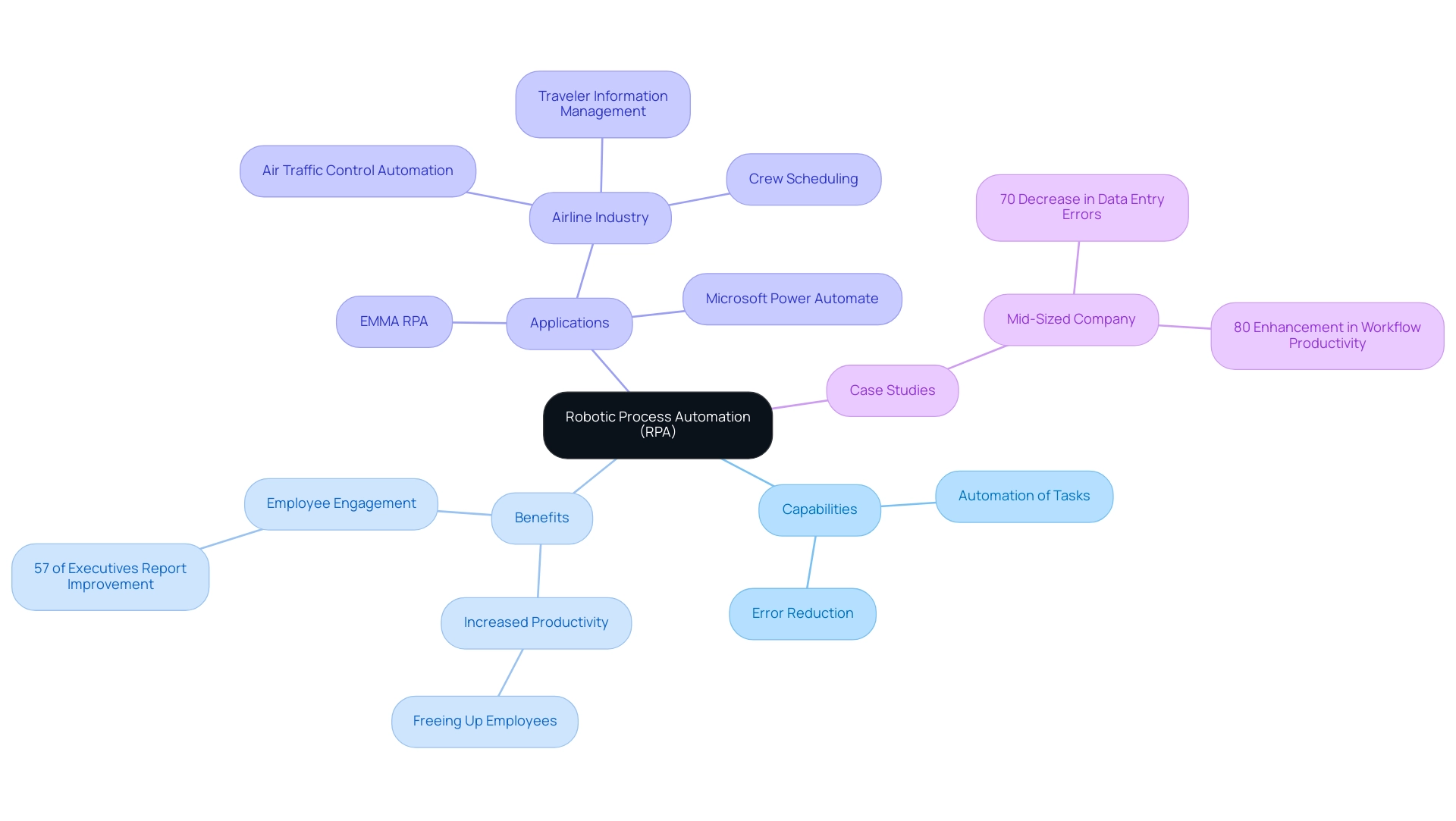
Key Benefits of Implementing RPA in Business
The RPA capabilities offer a multitude of advantages that can transform business operations in today’s rapidly evolving AI landscape. First and foremost, the RPA capabilities significantly enhance productivity; they can execute tasks around the clock without fatigue, leading to accelerated process completion times. This capability is especially valuable as companies strive to enhance productivity and streamline operations by leveraging RPA capabilities in an increasingly competitive environment.
Cost reduction is another critical benefit of RPA. By automating routine and repetitive tasks, companies can lower labor costs and redirect human resources to more strategic and higher-value work. In fact, 65% of RPA survey respondents indicated they would benefit from usage-based pricing, which not only enhances cost efficiency but also allows teams to focus on innovation and growth.
Accuracy is greatly improved with RPA, as it minimizes human errors, ensuring more precise data handling and strict compliance with regulations. This improved accuracy contributes to more reliable decision-making processes throughout the entity, aligning with the importance of tailored AI solutions and Business Intelligence for informed decision-making.
Moreover, the scalability of RPA solutions highlights their RPA capabilities. Organizations can quickly scale their automation efforts up or down in response to fluctuating demands without incurring significant new investments. However, it’s important to note that scaling RPA capabilities has proven more difficult than anticipated, with only 3% of organizations successfully scaling their digital workforce.
This statistic highlights the challenges of implementing RPA, emphasizing the need for strategic approaches to overcome these technology implementation hurdles.
Furthermore, the integration of RPA capabilities with tailored AI solutions can enhance operational performance even further. By leveraging AI, businesses can gain deeper insights into their processes, enabling more informed decision-making. Additionally, Business Intelligence plays a crucial role in extracting actionable insights from data, further supporting the benefits of RPA capabilities in driving growth and innovation.
Finally, the impact of RPA capabilities on employee satisfaction is profound. By automating mundane tasks, employees are liberated to engage in more meaningful and strategic work, leading to enhanced job satisfaction. According to recent insights, 83% of employees utilizing AI-driven technology report a reduction in burnout and an increase in job satisfaction.
As Yana Pokora, Content Manager at Flobotics, stated, “We hope this list of RPA stats has convinced you that automation is the next step you should take to enhance the overall productivity of your business.” Furthermore, a case study on future investment in RPA reveals that 78% of organizations that have implemented RPA expect to significantly increase their investment in RPA over the next three years, indicating a strong belief in its value despite the challenges faced in scaling its implementation. In 2024, the current benefits of RPA are clear: it enables businesses to achieve greater efficiency gains while fostering a more satisfied and engaged workforce.
For more insights and resources on RPA, consider exploring our latest publications.
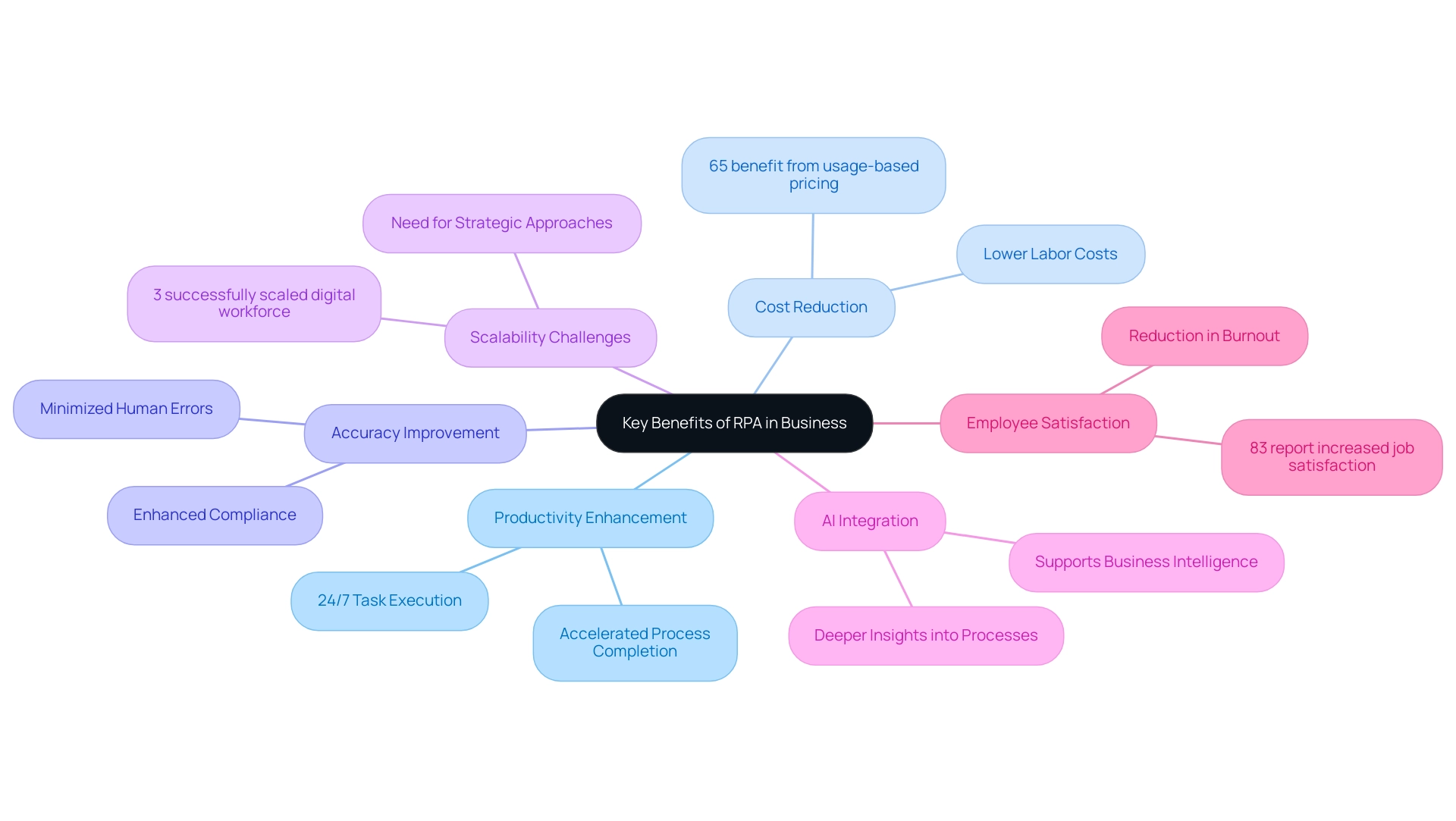
Challenges and Considerations in RPA Deployment
-
Resistance to Change: A common hurdle in the implementation of Robotic Process Automation (RPA) is employee resistance, often rooted in fears of job displacement. To alleviate these concerns, proactive communication is crucial, along with retraining initiatives that emphasize enhancing employees’ skills for new positions that support technological advancements. As highlighted by Anirudh M., addressing these fears is crucial for fostering a supportive environment for technological advancements. Furthermore, it is noteworthy that according to a report by Everest Group, 30% of businesses struggle with maintaining and managing their RPA capabilities post-implementation, emphasizing the need for effective strategies to overcome resistance while enhancing productivity through RPA solutions.
-
Integration Challenges: Successful RPA implementation relies on the seamless incorporation of RPA capabilities and automated solutions with existing systems. Leaders must conduct thorough assessments of compatibility and proactively plan for potential integration challenges. This foresight not only streamlines the implementation process but also improves overall operational effectiveness. For example, the supply chain management case study demonstrates how intelligent technology can enhance inventory management and order processing, significantly improving operational accuracy, which is crucial in today’s rapidly changing AI landscape. Additionally, integrating tailored AI solutions can further enhance these processes by providing advanced analytics and decision-making capabilities.
-
Maintaining Quality Control: While mechanization offers numerous efficiencies, it is imperative to maintain rigorous oversight of automated processes. Continuous monitoring ensures that the RPA capabilities function correctly and adhere to established quality standards, thereby safeguarding the integrity of operations. The case of the e-commerce company, which achieved a 90% reduction in order processing errors through intelligent technology, underscores the importance of quality control in realizing the benefits of RPA and making informed decisions that drive growth and innovation.
-
High Initial Costs: Although the RPA capabilities can yield significant long-term savings, entities must acknowledge the substantial initial setup and development costs associated with these solutions. Careful budgeting and a comprehensive return on investment (ROI) analysis are vital to ensure that the financial commitment aligns with the expected operational gains. As demonstrated by the e-commerce company, intelligent automation not only improved performance but also showcased the potential for cost-effectiveness in the long run, helping to address staffing shortages and outdated systems. By considering tailored AI solutions alongside RPA, organizations can further optimize their investment and enhance overall productivity.
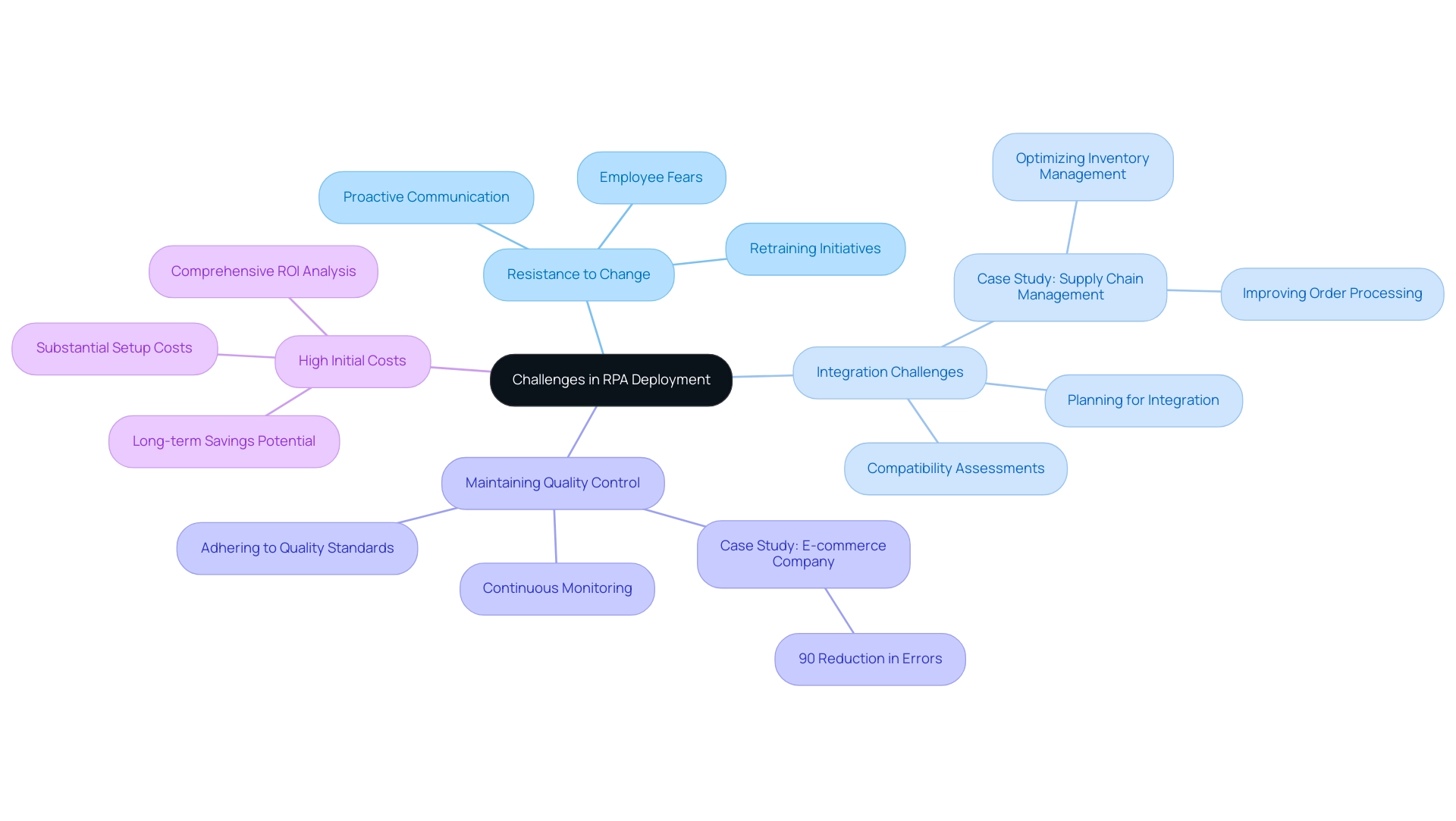
Strategies for Successful RPA Implementation
- Engage Stakeholders Early: Involve key stakeholders from the beginning to gain buy-in and address concerns, ensuring a supportive environment for RPA initiatives.
- Define Clear Objectives: Establish clear goals for RPA initiatives aligned with overall business strategy to measure success effectively. Consider how Creatum’s custom dashboards can track these objectives in real-time.
- Start Small: Begin with smaller, manageable projects to demonstrate quick wins and build momentum for larger implementations. This approach allows for the seamless integration of data from multiple sources, enhancing insights from the outset.
- Invest in Training: Provide comprehensive training and support to employees to help them adapt to new technologies and processes. Leverage Creatum’s expert training services to equip your team with the skills needed to maximize RPA capabilities.
- Monitor and Optimize: Continuously observe RPA performance using advanced analytics to discover trends and enhance effectiveness over time. This data-driven approach not only enhances decision-making but also ensures that the ROI from RPA initiatives is maximized, addressing potential challenges effectively.
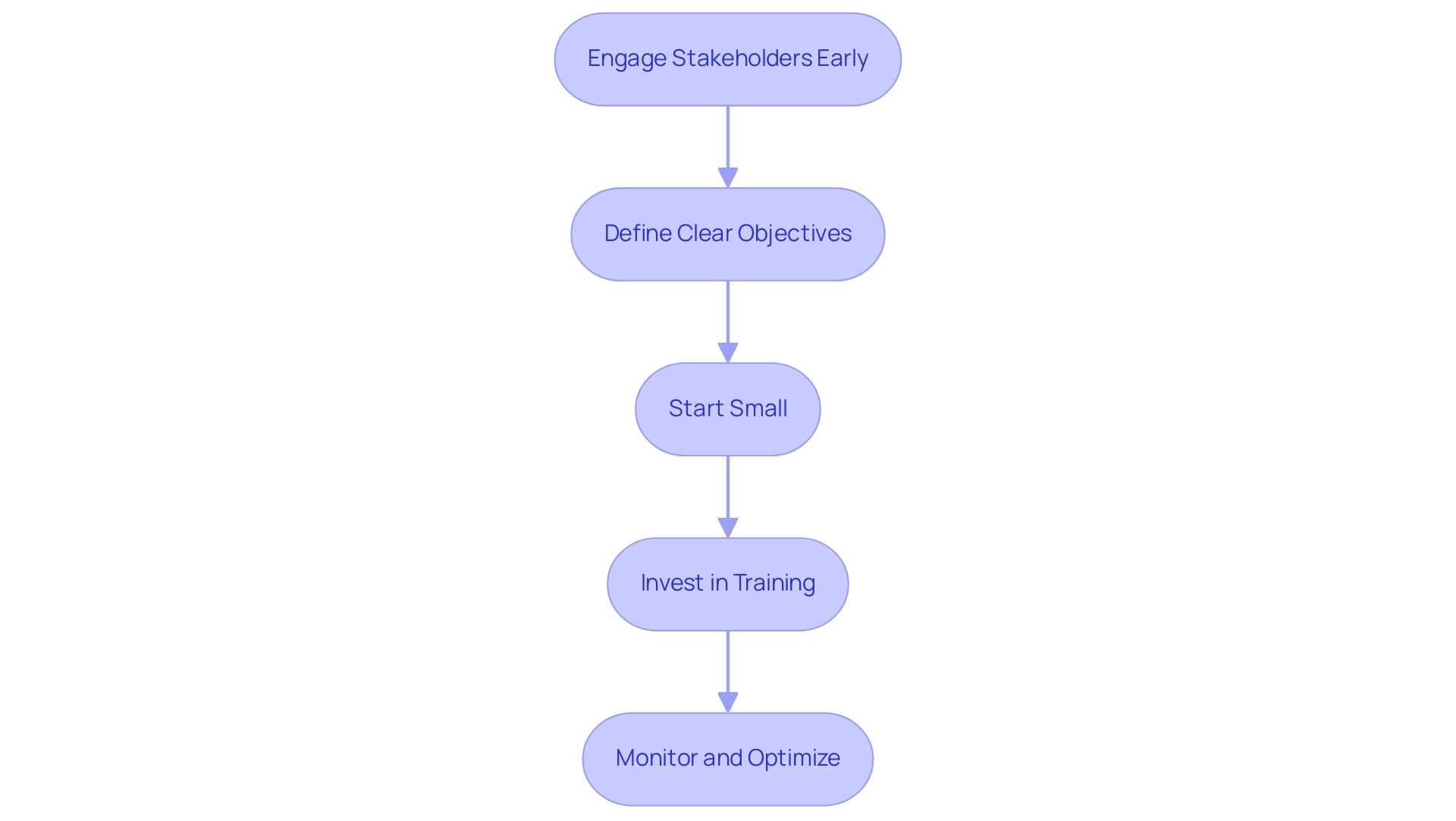
The Future of RPA: Trends and Innovations
The future of Robotic Process Automation (RPA) is being shaped by several key trends that promise to redefine operational efficiency:
-
Hyperautomation: The fusion of RPA with artificial intelligence (AI) and machine learning is paving the way for hyperautomation, which facilitates complex decision-making processes that were previously unattainable with traditional automation methods. This evolution allows organizations to cut through the complexities of the rapidly evolving AI landscape, identifying tailored solutions that align with their specific business goals.
-
Intelligent Automation: This evolution will enhance RPA capabilities, enabling it to manage unstructured data and execute more sophisticated tasks, ultimately driving greater productivity across operations. Solutions such as the Nividous Intelligent platform demonstrate this by integrating RPA, AI, and low-code methods to lower expenses and improve process efficiency, thereby enabling teams to concentrate on strategic initiatives.
-
Increased Focus on Governance: As entities expand their RPA initiatives, there will be a heightened emphasis on governance frameworks to ensure compliance and maintain control over automation processes, safeguarding against potential risks. This governance is essential for addressing compliance and risk management concerns.
-
AI-Driven Insights: The integration of AI into future RPA solutions will enable businesses to harness predictive analytics, transforming raw data into actionable insights that serve as strategic advantages in a competitive landscape. This approach is vital for entities striving to leverage Business Intelligence for informed decision-making, driving growth and innovation.
-
Real-World Application: For example, a specialized healthcare management firm adopted RPA for Patient Data Extraction, Review, and Claim Submission, leading to a 70% decrease in claim processing time, demonstrating the concrete advantages of RPA in enhancing operational performance. These developments underscore a pivotal shift in how organizations approach automation, making RPA capabilities not just a choice but a strategic imperative.
The urgency to adopt these trends is clear, especially with the RPA market projected to reach an astonishing $50.50 billion globally by 2030. As Alan Hester, president of Nividous, encapsulates, embracing RPA transcends being merely a choice; it represents a strategic move toward a future characterized by agility, efficiency, and innovation.
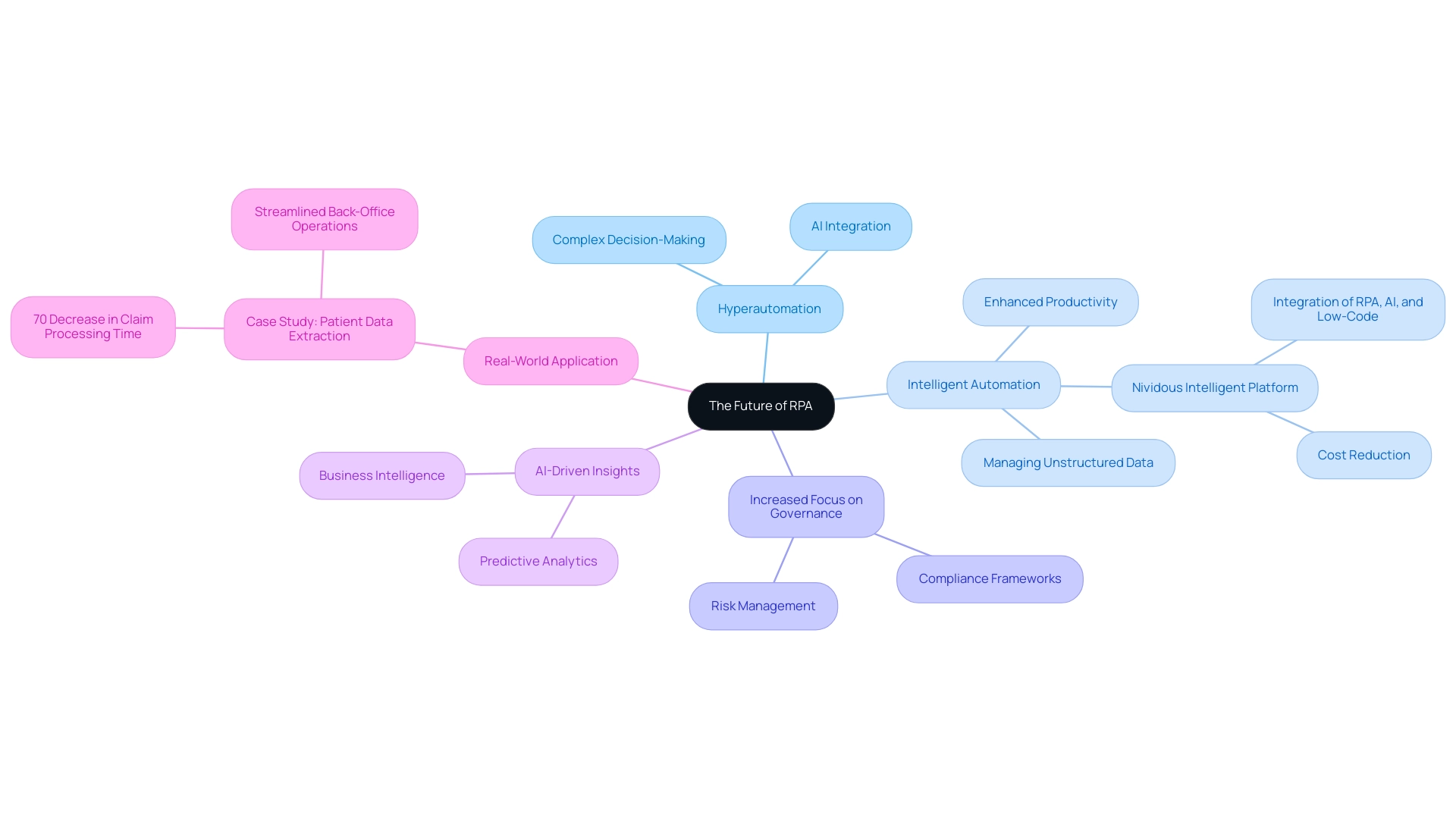
Conclusion
Embracing Robotic Process Automation (RPA) is crucial for organizations looking to enhance efficiency and drive innovation in today’s competitive landscape. By automating repetitive tasks, businesses not only improve accuracy and scalability but also significantly boost employee satisfaction. The case studies highlighted throughout the discussion demonstrate that RPA can lead to remarkable improvements in operational efficiency, allowing teams to focus on strategic initiatives that contribute to growth.
However, the journey toward successful RPA implementation is not without its challenges. Organizations must proactively address:
- Resistance to change
- Integration issues
- Maintaining quality control
- Managing initial costs
By engaging stakeholders early, defining clear objectives, and investing in training, companies can navigate these hurdles effectively. Continuous monitoring and optimization of RPA performance are essential for maximizing return on investment and ensuring sustained benefits.
Looking ahead, the future of RPA is bright, with trends like hyperautomation and intelligent automation poised to redefine operational capabilities. By integrating AI-driven insights and focusing on governance, organizations can harness the full potential of RPA to not only streamline their processes but also create a more agile and innovative operational framework. The time to act is now; those who embrace RPA today will be the leaders of tomorrow.
Introduction
In a world where efficiency is paramount, Robotic Process Automation (RPA) emerges as a game-changing technology that can redefine how organizations operate. By automating repetitive and rule-based tasks, RPA not only streamlines workflows but also liberates human resources to focus on strategic initiatives that drive growth.
As businesses grapple with the challenges of outdated systems and staffing shortages, RPA offers a compelling solution, enhancing productivity while minimizing errors. From financial services to healthcare, the applications of RPA are vast, showcasing its potential to transform operations across various industries.
This article delves into the core functions of RPA, its benefits, and the challenges organizations may face during deployment, ultimately highlighting how embracing this technology can position companies for success in an increasingly competitive landscape.
Understanding Robotic Process Automation (RPA) and Its Core Functions
Process robotics, exemplified by Robotic Process Automation (RPA), is a transformative technology that leverages software robots, or ‘bots’, to automate repetitive, rule-based tasks traditionally performed by human workers. In contrast to traditional processes, process robotics functions mainly on organized information, enabling it to engage with applications with the same accuracy and speed as a human user, frequently with enhanced effectiveness. The main roles of process robotics encompass:
- Information extraction
- Information entry
- The thorough mechanization of processes
This integration enables organizations to significantly streamline workflows with process robotics, alleviating the burden of mundane tasks and enhancing operational efficiency. For example, one bot can troubleshoot 200-300 video units or cameras daily, illustrating the substantial impact of RPA on operational productivity. However, it is essential to acknowledge that process robotics has constraints in handling unstructured information and intricate decision-making, which requires the integration of AI for improved operational capabilities.
By embracing process robotics, businesses can minimize errors and redirect human resources to more strategic activities that add value. Key features of EMMA RPA encompass:
- Seamless digitalization
- Intuitive interfaces that cater to various applications
While Microsoft Power Automate provides strong capabilities for transforming operations through process robotics and mechanization. A compelling case study highlights a mid-sized company that faced challenges with:
- Manual information entry errors
- Slow software testing
- Difficulty integrating outdated systems without APIs
By implementing process robotics for automating data entry and software testing through GUI automation, they reduced data entry errors by 70%, accelerated testing processes by 50%, and achieved an impressive 80% enhancement in workflow performance, with a return on investment realized within six months. As Alan Hester, President of Nividous, aptly states, ‘Embracing RPA transcends being merely a choice; it represents a strategic move toward a future characterized by agility, effectiveness, and innovation.’ This forward-thinking approach not only optimizes daily operations using process robotics but also positions companies advantageously in competitive markets while effectively addressing staffing shortages and outdated systems.
To learn more about how RPA can transform your operations, book a free consultation today.
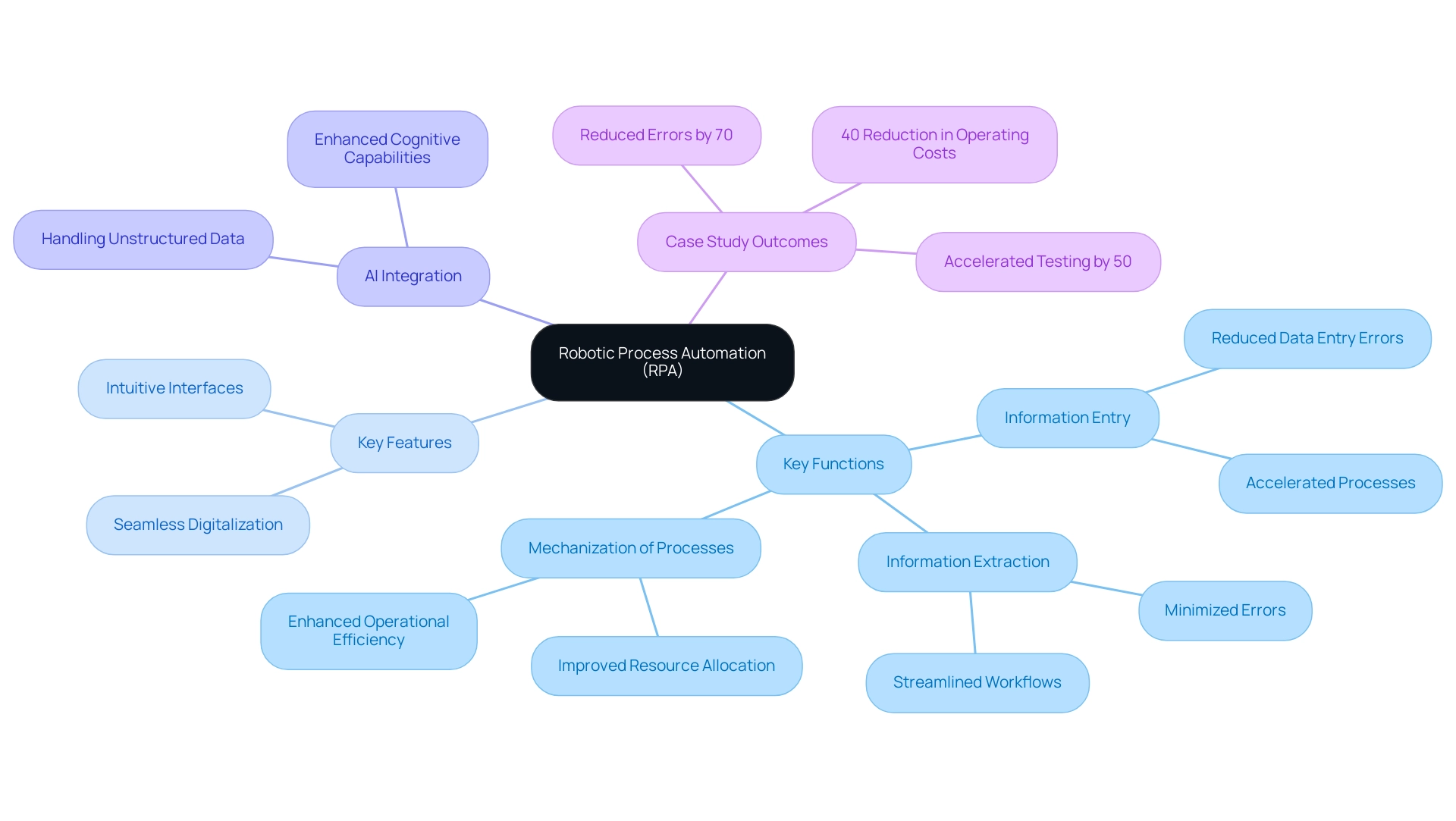
Key Applications of RPA Across Industries
Process robotics is transforming operations across numerous industries, showcasing significant potential to enhance efficiency and effectiveness. In the financial services sector, RPA automates:
- Reconciliation
- Fraud detection
- Transaction processing
This results in quicker service delivery and enhanced compliance. In healthcare, a mid-sized company successfully implemented GUI technology to streamline:
- Patient onboarding
- Appointment scheduling
- Claims processing
This involved automating data entry tasks, enhancing software testing, and integrating legacy systems, resulting in a remarkable 70% reduction in data entry errors and an 80% improvement in workflow productivity. The ROI from these automation solutions was achieved within just 6 months, significantly enhancing the patient experience. Customer service departments leverage RPA to automate responses to frequently asked questions and manage support tickets, allowing human agents to focus on complex queries.
These applications emphasize the strength of process robotics in enhancing operational effectiveness while addressing technology implementation challenges, enabling organizations to make informed decisions and optimize productivity.
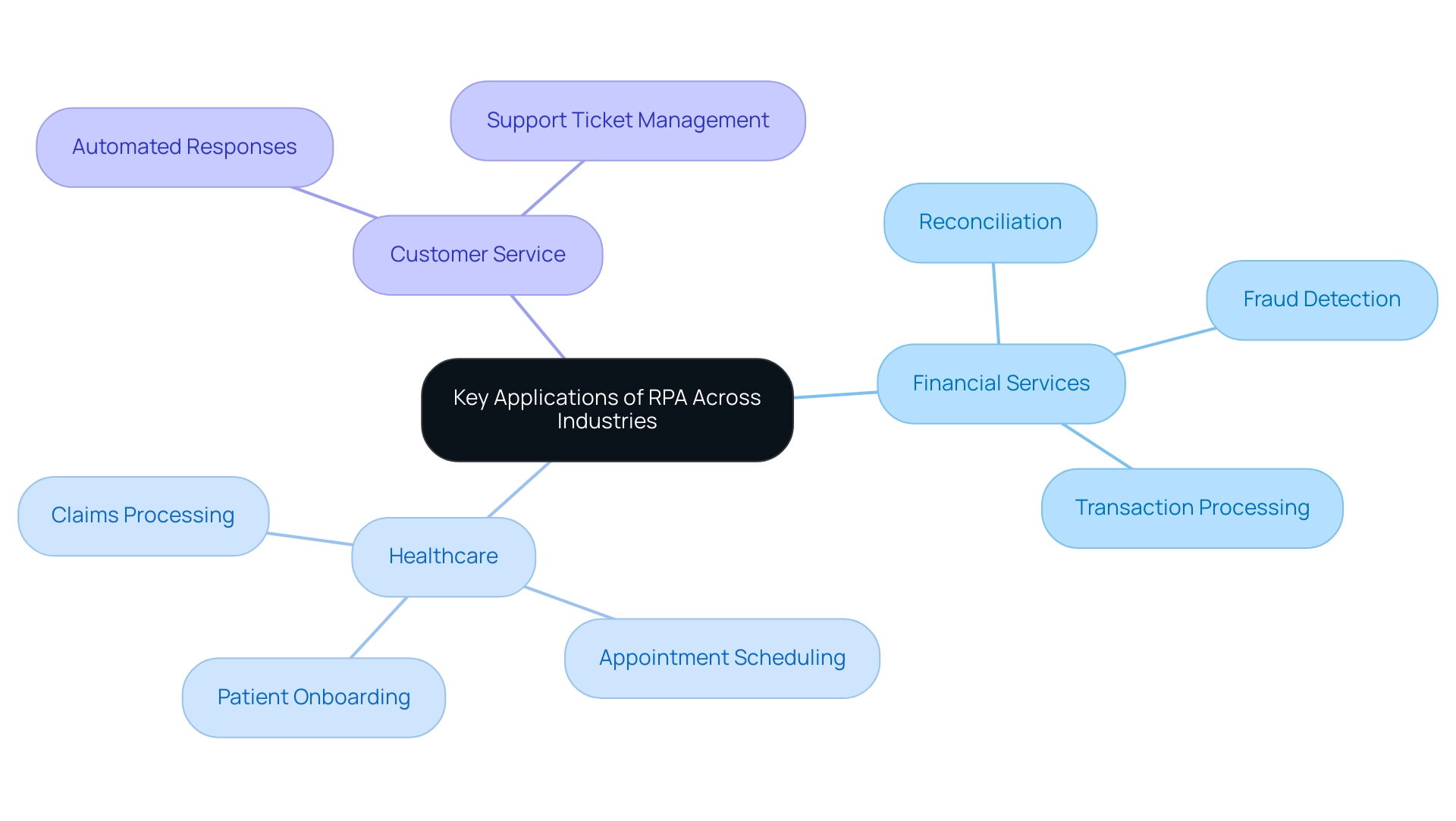
Benefits of Implementing RPA in Business Processes
Implementing process robotics offers numerous benefits, including increased productivity, cost savings, and enhanced compliance. By utilizing process robotics to automate manual and repetitive tasks, organizations can significantly reduce processing times, freeing employees to concentrate on higher-value activities. RPA minimizes human error, ensuring greater accuracy and compliance with regulatory requirements, which is critical in today’s data-rich environment.
Moreover, RPA tackles challenges like task repetition fatigue and staffing shortages, enabling businesses to sustain productivity even during peak periods. The scalability of RPA solutions enables rapid adaptation to changing demands, providing a competitive edge in a rapidly evolving AI landscape. Coupled with tailored AI solutions and robust Business Intelligence, RPA empowers informed decision-making, driving growth and innovation while overcoming technology implementation challenges.
Overall, process robotics enhances operational efficiency, positioning organizations for sustained success.
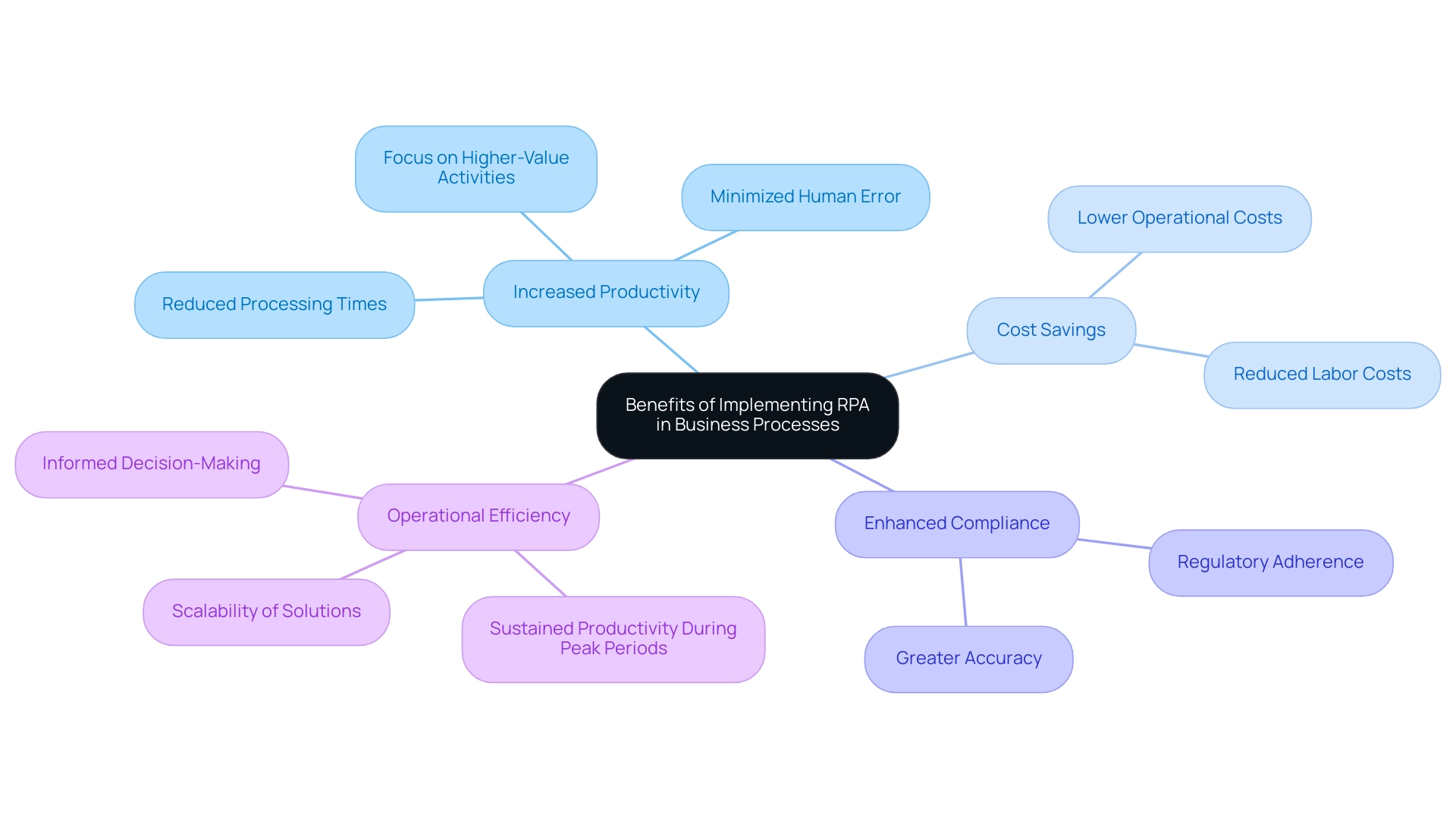
Challenges and Considerations in RPA Deployment
While RPA offers substantial advantages, organizations often face challenges during its deployment. Common obstacles include employee resistance to change, stemming from fears of job displacement or feelings of being overwhelmed by new technologies. Additionally, establishing robust governance frameworks is essential for effective RPA management and regulatory compliance.
Choosing the appropriate processes for process robotics is essential, as not all tasks are suitable for RPA. Furthermore, modernizing outdated systems is vital to streamline operations and enhance innovation. By proactively addressing these challenges, such as streamlining repetitive tasks, tackling staffing shortages, and modernizing outdated systems, organizations can harness the full potential of process robotics solutions, ensuring a smooth transition and maximizing productivity.
Our risk-free, ROI-driven methodology includes the following steps:
- Evaluating your existing procedures for mechanization potential
- Calculating the efforts needed for mechanization
- Estimating time savings and calculating ROI
- Implementing the mechanization with certified professionals
This method, illustrated through successful GUI control case studies, highlights how operational productivity can be significantly improved across industries.
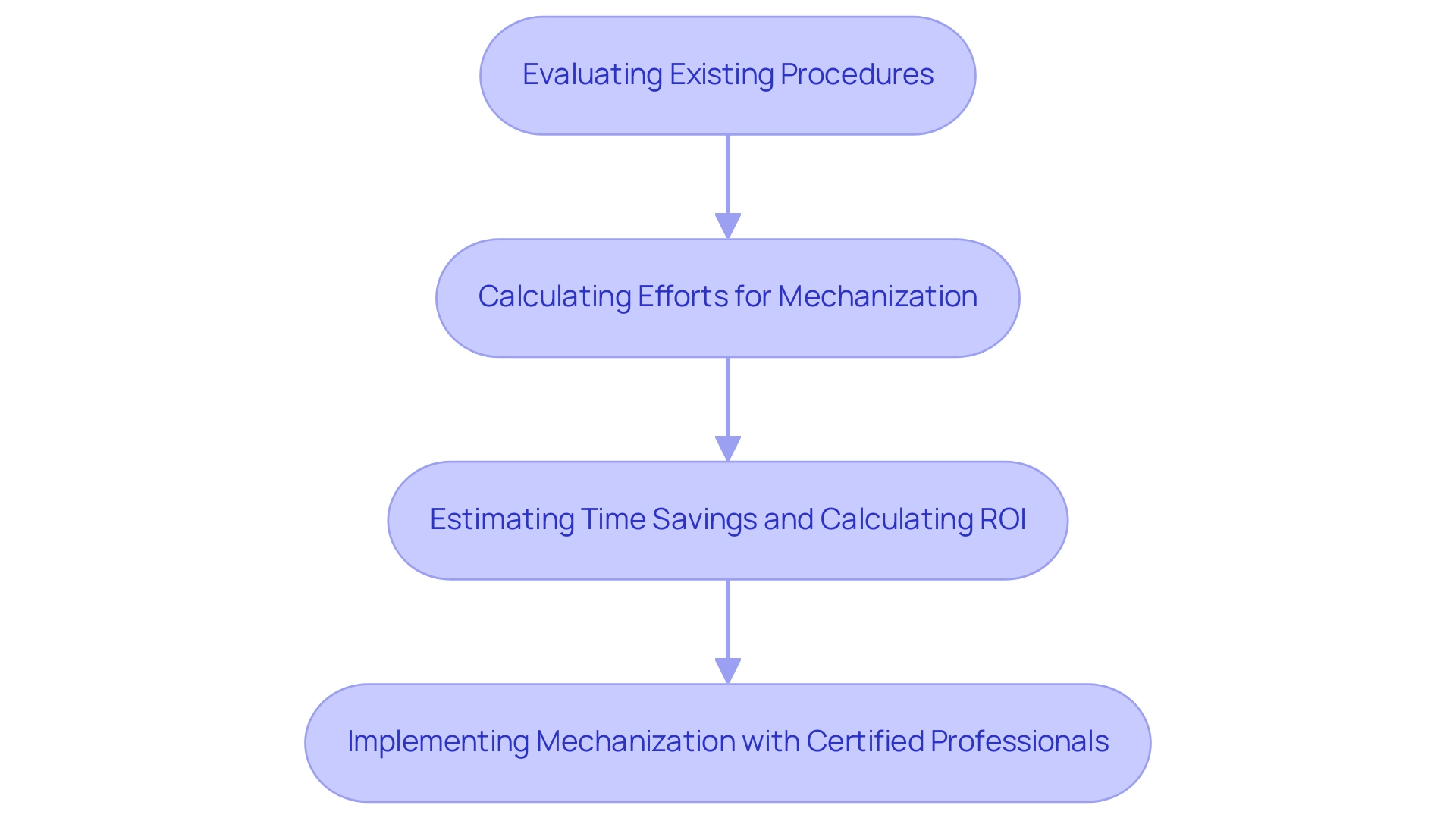
The Future of RPA: Integration with AI and Emerging Trends
The future of process robotics lies in its seamless integration with artificial intelligence, paving the way for a more robust automation landscape. As AI technologies, like Small Language Models (SLMs), continue to evolve, RPA can harness machine learning and natural language processing to tackle increasingly complex tasks and enable data-driven decision-making. This powerful integration empowers organizations to automate not only repetitive tasks but also processes that require cognitive capabilities, significantly enhancing overall operational efficiency.
Furthermore, emerging trends such as hyperautomation, which fuses RPA with AI and other innovative technologies, promise to drive transformative change in process robotics within business operations. By embracing these advancements, organizations can overcome the challenges of poor master data quality and initial adoption hesitations, including concerns about costs and complexities, positioning themselves as leaders in operational excellence. To explore how our tailored AI solutions can enhance your business processes, book a free consultation today.
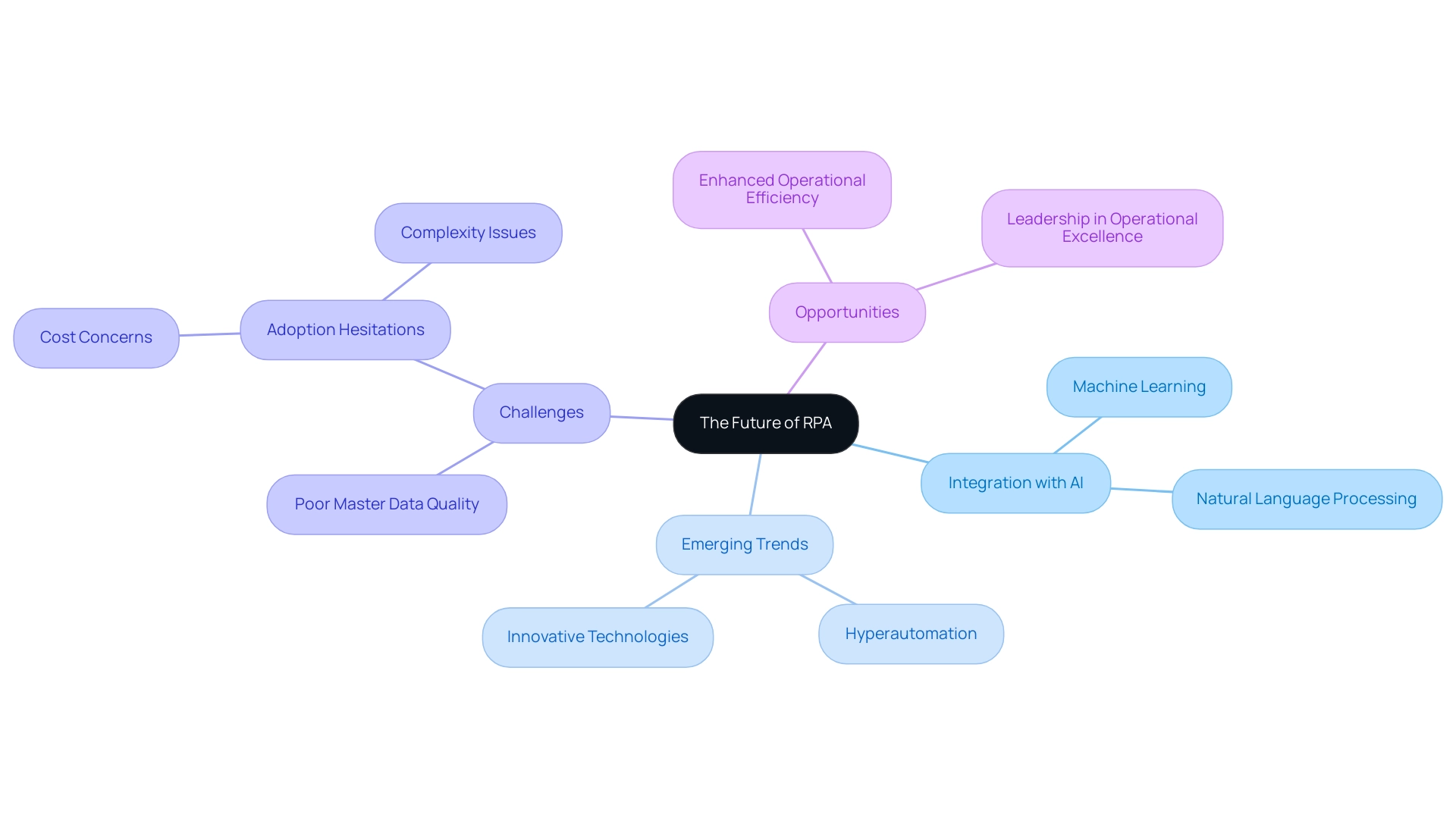
Conclusion
RPA stands at the forefront of operational transformation, offering organizations the tools they need to enhance efficiency and drive growth. By automating repetitive and rule-based tasks, businesses can significantly reduce processing times, minimize errors, and free up human resources for more strategic initiatives. The diverse applications of RPA across industries—such as financial services, healthcare, and customer service—demonstrate its potential to streamline operations and improve service delivery, all while achieving impressive returns on investment.
However, the journey to successful RPA implementation is not without its challenges. Organizations must navigate employee resistance, select appropriate processes for automation, and modernize outdated systems to fully leverage RPA’s benefits. By proactively addressing these obstacles, companies can ensure a smooth deployment and maximize productivity gains.
Looking ahead, the integration of RPA with artificial intelligence presents exciting opportunities for further enhancing automation capabilities. As businesses adopt hyperautomation strategies, they can tackle complex tasks that require cognitive functions, thereby positioning themselves as leaders in their respective markets. Embracing RPA is not just about keeping pace with technological advancements; it is a strategic move that empowers organizations to thrive in an increasingly competitive landscape. The time to take action is now, and the path to operational excellence begins with RPA.
Introduction
In the rapidly evolving landscape of modern business, the adoption of Robotic Process Automation (RPA) stands out as a game-changer, offering organizations a path to unprecedented efficiency and innovation. By deploying software bots to handle repetitive and rule-based tasks, businesses can not only streamline operations but also empower their workforce to focus on strategic initiatives that drive growth.
As the RPA market continues to expand at a remarkable pace, with projections indicating substantial growth across various sectors, the potential for transformation is immense. However, the journey to successful RPA implementation is not without its challenges.
This article delves into the key benefits, common use cases, and future trends of RPA, while also addressing the obstacles organizations may face along the way. By equipping businesses with practical insights and solutions, it paves the way for a seamless transition into the world of automation, ensuring that they remain competitive in an increasingly digital marketplace.
Defining Robotic Processing Automation (RPA)
Robotic processing is a transformative technology that utilizes software robots or ‘bots’ to automate repetitive, rule-based tasks traditionally handled by human workers. These tasks often encompass data entry, transaction processing, and record management. By mimicking human interactions with digital systems, robotic processing automation allows organizations to streamline their operations significantly.
The deployment of robotic processing not only enhances operational efficiency and minimizes errors but also empowers employees to redirect their focus toward more strategic activities that leverage human judgment and creativity. This pivotal shift signifies that robotic processing is more than merely a mechanization tool; it represents a fundamental change in how businesses can optimize workflows and elevate overall productivity. With 90% of invoices not linked to a purchase order being handled manually, the potential for mechanization becomes clear, paving the way for significant operational enhancements.
Furthermore, 83% of employees using AI-powered tools believe it can help reduce burnout and enhance job satisfaction, underscoring the positive impact of RPA on workforce morale. As the global RPA market is projected to grow at a CAGR of 27.7% from 2023 to 2028, driven by increasing adoption of robotic processing across various industries, small and medium-sized enterprises (SMEs) are expected to adopt RPA solutions at a growth rate of 25% annually. However, navigating the rapidly evolving AI landscape can present challenges in identifying the right solutions for your business needs.
Without leveraging Business Intelligence, organizations risk falling behind their competitors, as struggling to extract meaningful insights can leave a business at a disadvantage. Our tailored AI solutions can help you navigate these challenges and leverage business intelligence to drive data-driven insights. If you’re unsure where to start, we’ve got you covered—reach out to our RPA consultants and get a free consultation now!
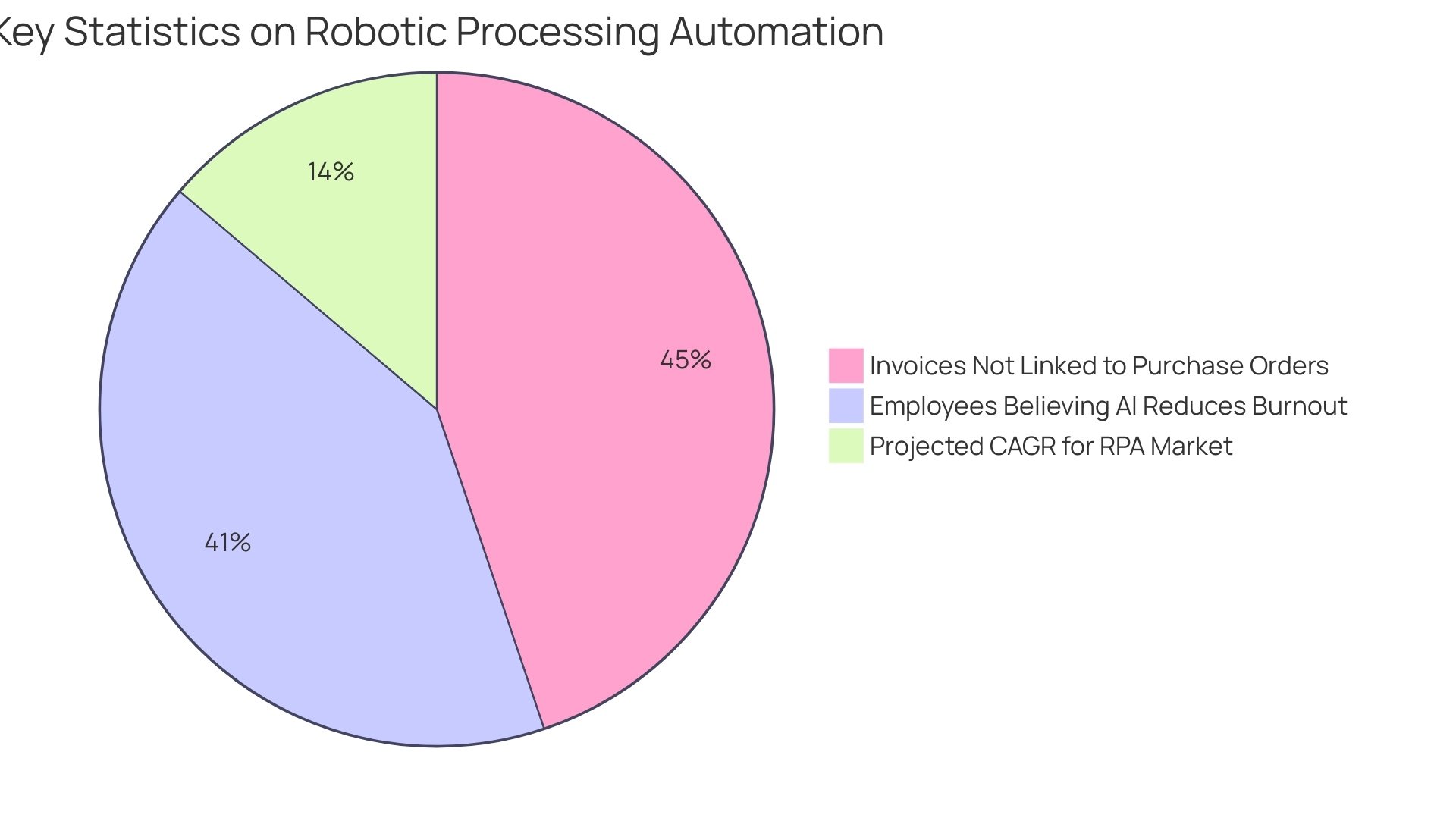
Key Benefits of Implementing RPA in Business
Implementing robotic processing in business operations yields a multitude of benefits that can transform organizational efficiency.
- Cost Reduction: Automation of routine tasks, such as data entry and software testing, can lead to significant reductions in operational costs associated with manual labor. For example, a recent case study showed that a mid-sized company encountered difficulties with manual data entry mistakes and sluggish software testing, which were resolved by streamlining these tasks with GUI solutions, leading to a 70% decrease in data entry mistakes and significant cost savings.
Additionally, 90% of invoices not attached to a purchase order are processed manually, highlighting the financial implications of adopting robotic processing solutions.
- Improved Efficiency: RPA bots, operating continuously without breaks, enhance processing times significantly. A notable example is the aforementioned case study, where mechanization accelerated testing processes by 50%, effectively removing workflow bottlenecks.
Utilizing technology, particularly in language-oriented tasks, which represent 25% of total work time, can further enhance operational efficiency, as noted by McKinsey’s insights into advancements in natural language processing.
-
Enhanced Data Quality: The risk of human error in data handling is significantly reduced with automation, leading to higher accuracy and reliability. This enhancement in data quality directly aids better decision-making processes throughout entities, aligning with the need for effective data management in modern operations.
-
Scalability: Robotic processing solutions are inherently scalable, allowing companies to adapt swiftly to changing business needs. This includes integrating legacy systems without APIs, as demonstrated in the case study, where seamless legacy system integration was achieved through the features of EMMA RPA and Power Automate. This flexibility is crucial in today’s fast-paced market environment, where agility is key to maintaining a competitive edge.
-
Employee Satisfaction: By alleviating employees from mundane, repetitive tasks, RPA fosters engagement in more meaningful work. The case study illustrates this impact, with 91% of employees believing automation saves time and improves work-life balance. RPA integration not only enhances job satisfaction but also contributes to higher retention rates, with 89% reporting increased job satisfaction.
Overall, the strategic implementation of RPA not only drives operational efficiency but also cultivates a culture of innovation and continuous improvement, positioning organizations for long-term success.
The measurable results, including a 70% reduction in data entry mistakes and a 50% speedup in testing activities, highlight the considerable effect of RPA on improving operational efficiency.
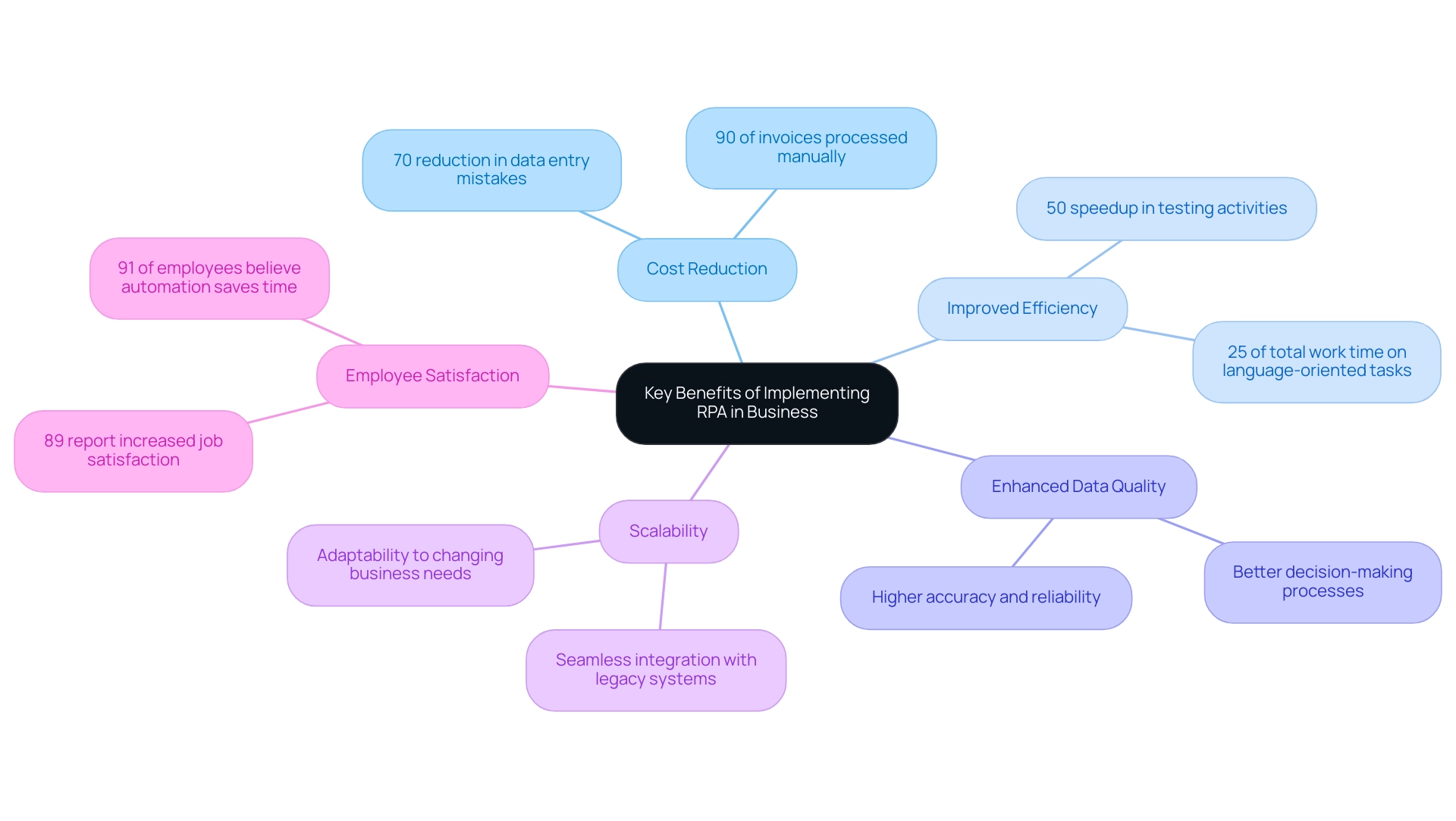
Common Use Cases of RPA in Various Industries
Robotic processing has emerged as a transformative force across various sectors, demonstrating its capability to enhance efficiency and streamline operations in the face of common workplace challenges. Key implementations include:
-
Finance and Banking: RPA is revolutionizing processes such as account reconciliation, loan processing, and compliance reporting.
By automating these tasks, companies can significantly reduce transaction times and operational risks. A Deloitte survey indicates that 78% of organizations are adopting RPA, highlighting its critical role in digital transformations within the financial sector. Furthermore, RPA systems can update operations automatically as new regulations are introduced and maintain comprehensive logs essential for audits, ensuring compliance in financial practices.
For example, in the case of General Ledger Automation, RPA can automate account reconciliation and data validation, reducing errors and saving time. -
Healthcare: In the healthcare industry, RPA is being utilized to improve patient scheduling, automate claims processing, and manage data entry into electronic health records (EHRs).
These applications not only enhance patient care but also streamline administrative workflows, ultimately leading to better outcomes for both patients and providers. -
Manufacturing: RPA optimizes supply chain operations by automating inventory management, order processing, and procurement tasks.
This automation enhances production efficiency and allows manufacturers to maintain a competitive edge in a rapidly evolving market. -
Retail: Retailers are leveraging RPA for inventory tracking, managing customer service inquiries, and fulfilling orders.
This technology enables them to respond swiftly to customer demands, thereby improving service levels and customer satisfaction. -
Telecommunications: In the telecommunications sector, RPA automates customer onboarding, billing inquiries, and service provisioning.
These enhancements not only improve customer experience but also help reduce churn rates, positioning companies for long-term success, and these diverse examples underscore the role of robotic processing in refining operational processes across industries.
Moreover, by automating repetitive tasks, RPA alleviates staffing shortages, enabling companies to concentrate on strategic hiring and talent retention.
Additionally, RPA modernizes outdated systems, enhancing employee satisfaction by reducing mundane tasks and enabling staff to engage in more value-adding work.
Overall, robotic processing is a valuable tool for entities seeking to optimize their workflows, enhance productivity, and overcome challenges related to outdated systems and talent retention.
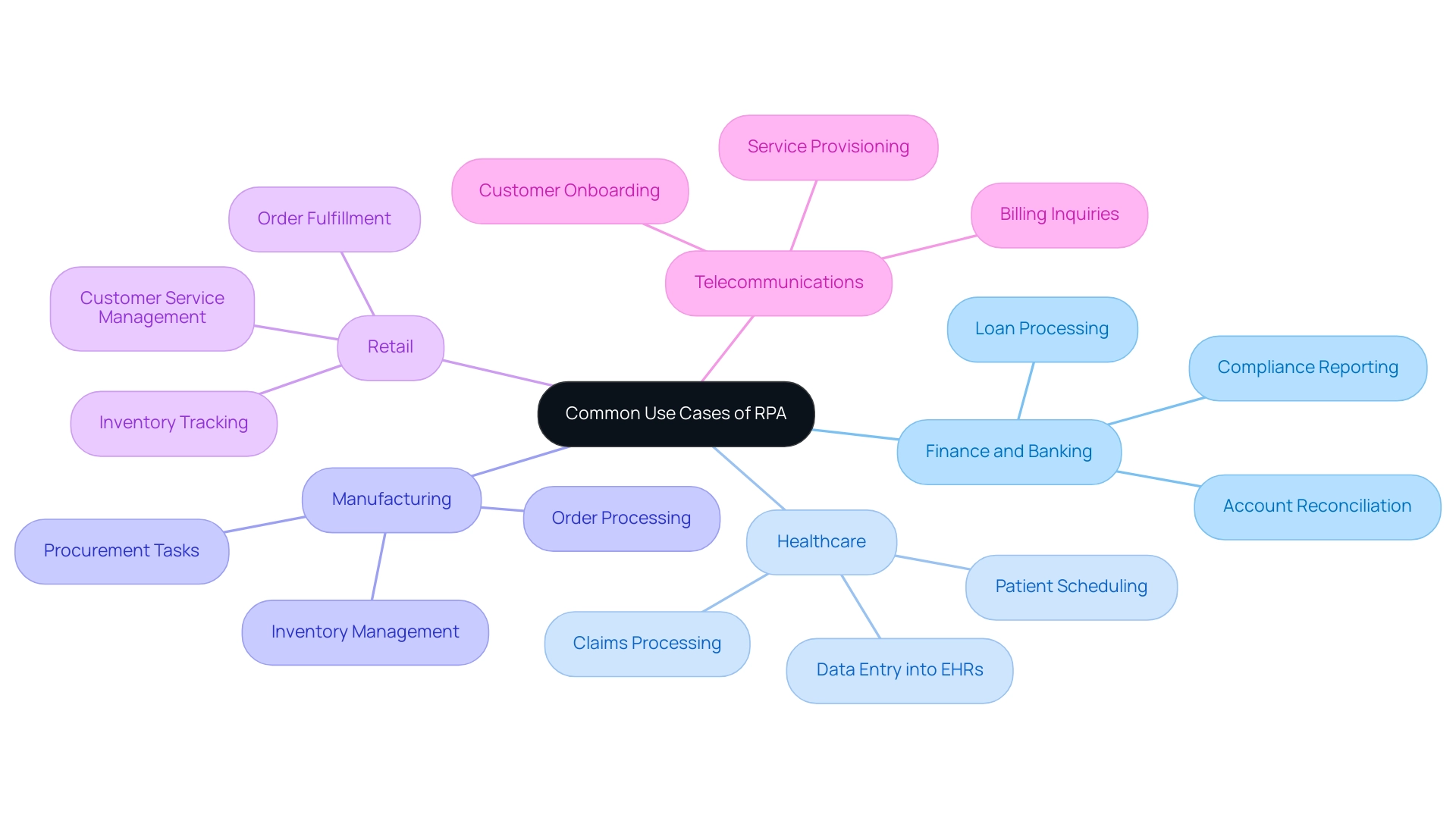
Challenges in Implementing RPA
Implementing robotic processing can unlock significant advantages for organizations, yet several challenges often arise during the transition. Addressing these hurdles proactively can enhance the likelihood of successful integration and maximize the advantages of mechanization.
-
Resistance to Change: A common concern among employees is the fear of job displacement or alterations in their roles. To alleviate these apprehensions, effective change management strategies paired with transparent communication are crucial. In fact, a recent survey revealed that 91% of employees believe that these technologies not only save time but also enhance their work-life balance, while 89% report higher job satisfaction due to such initiatives. This corresponds with the case study titled ‘Employee Satisfaction with Automation,’ which demonstrates that this technology positively influences employee productivity and job satisfaction.
-
Integration with Existing Systems: The compatibility of RPA solutions with current IT infrastructure can pose technical challenges. Organizations must conduct thorough assessments of their systems and create detailed integration plans, particularly when considering tailored AI solutions that can cut through the noise of a rapidly evolving technology landscape, ensuring seamless implementation.
-
Selection of Tasks: Deciding which tasks to automate is essential for a successful RPA strategy. Not every task is appropriate for mechanization; therefore, organizations should assess potential workflows based on their capability to provide a positive return on investment. This is where risk-free ROI-driven automation becomes vital, as highlighted by our GUI automation approach. We take the ROI risk for you because we know we will deliver: you only pay if we deliver what was promised.
-
Maintenance and Governance: Ongoing monitoring and upkeep are essential for guaranteeing that automated bots operate efficiently and adjust to changing systems. Establishing robust governance frameworks is key to managing these aspects and preventing operational disruptions.
-
Skill Gaps: The deployment of RPA may highlight skill deficiencies among existing staff, necessitating investment in training and development programs. Equipping teams with the necessary capabilities will not only facilitate the implementation of RPA but also enhance overall operational efficiency.
By recognizing these challenges and implementing strategic solutions, organizations can significantly improve their robotic processing capabilities, leading to increased productivity and employee satisfaction. The success of Cem Dilmegani at Hypatos, which achieved a 7-digit annual recurring revenue and a 9-digit valuation in just two years, exemplifies the commercial growth potential that effective RPA implementation can offer. Furthermore, our customized AI solutions will assist in simplifying the evaluations and ROI calculations, guaranteeing that your journey towards efficiency is both productive and effective.
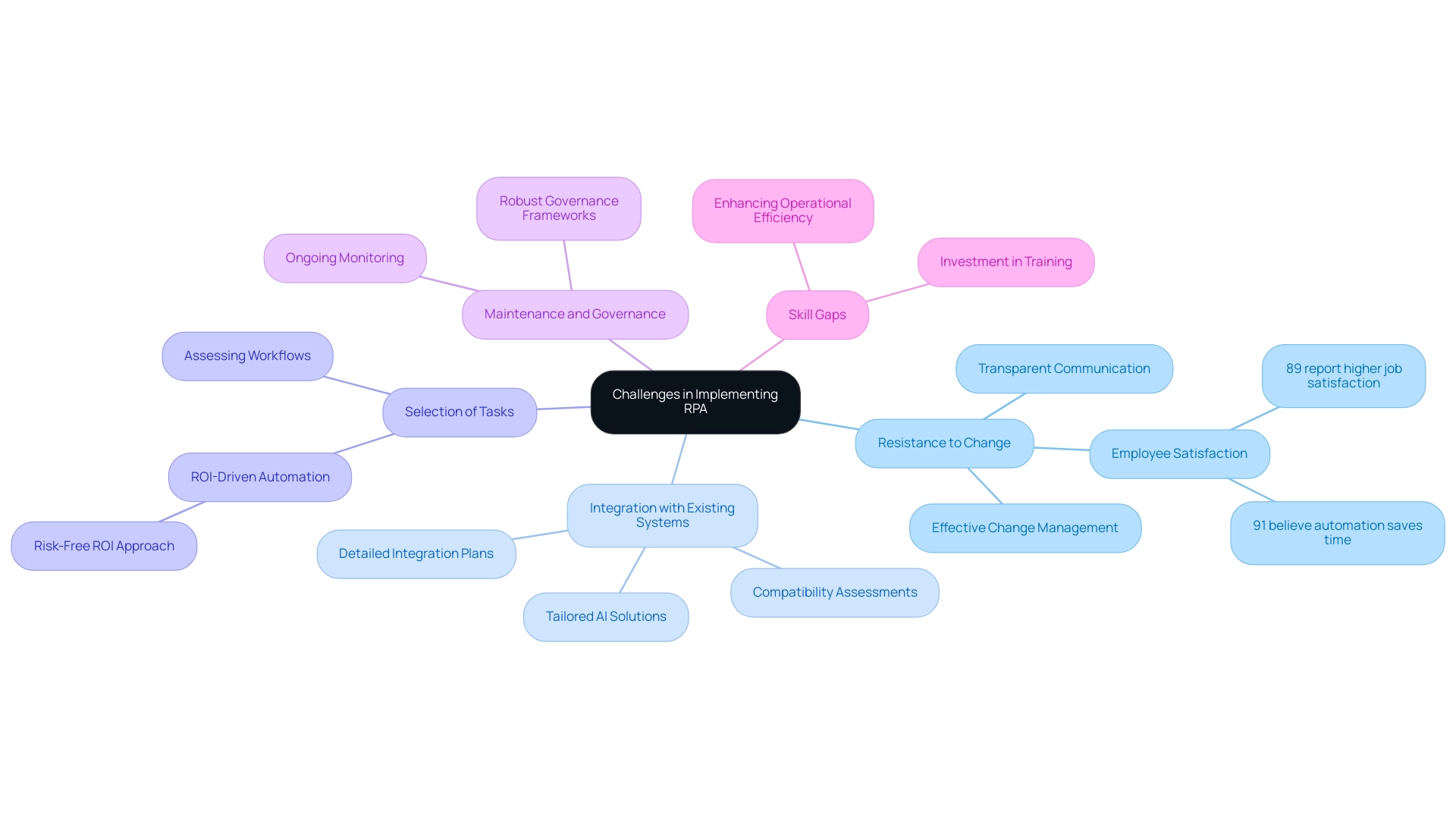
Future Trends in RPA and Its Impact on Business
The future of Robotic Process Automation (RPA) is poised for remarkable evolution, characterized by several pivotal trends that will reshape its landscape:
-
Intelligent Automation: The integration of artificial intelligence (AI) and machine learning with traditional RPA, known as intelligent automation, empowers bots to handle more complex tasks that demand decision-making capabilities. This advancement in robotic processing is expected to significantly enhance operational efficiency, allowing businesses to streamline processes more effectively.
-
Rise of Cloud-Based Robotic Processing: As organizations increasingly move towards cloud infrastructures, robotic processing solutions based in the cloud will become more prominent. These offerings provide scalable and flexible options while lowering infrastructure expenses, making them an attractive choice for contemporary businesses aiming to boost productivity through robotic processing and mechanization.
-
Hyperautomation: Advancements in robotic processing are driving companies to increasingly adopt hyperautomation, which combines RPA with various other technologies to streamline comprehensive business processes. This strategic approach drives extensive operational enhancements by utilizing robotic processing, allowing entities to optimize efficiency at all levels.
-
User-Centric Innovations: Future RPA solutions will focus heavily on enhancing user experience through robotic processing. By streamlining the development and oversight of automated workflows for non-technical users, these solutions will make such processes accessible, enabling employees throughout the company to enhance operational efficiency.
-
Stringent Security and Compliance: With the rise of RPA adoption, businesses must prioritize security and compliance within their operational strategies. This requires robust governance frameworks to ensure that robotic processing implementations meet necessary standards, protecting sensitive data and maintaining regulatory compliance.
The RPA market is projected to grow at a robust rate of 24.31% CAGR, aiming for a market value of USD 13.9 billion by 2031. These emerging trends indicate a dynamic future for robotic processing, suggesting that organizations proactive in adapting to these changes will be best positioned to utilize mechanization for sustained growth and innovation. As noted by Josef Martens, a Ph.D. CTO Coach and Advisor, “John, thanks for sharing!”
This highlights the collaborative nature of progress in the RPA landscape. Furthermore, a case study titled “Future of RPA in Various Industries” suggests that over the next 5-10 years, robotic processing will evolve differently across sectors, aiding in personalized medicine, optimizing production lines, and enhancing customer service. For instance, in the healthcare sector, RPA can streamline patient data management, while in manufacturing, it can optimize supply chain processes.
As highlighted by CM First Group, implementing robotic processing technology can yield a high return on investment, especially when integrated with intelligent automation strategies.
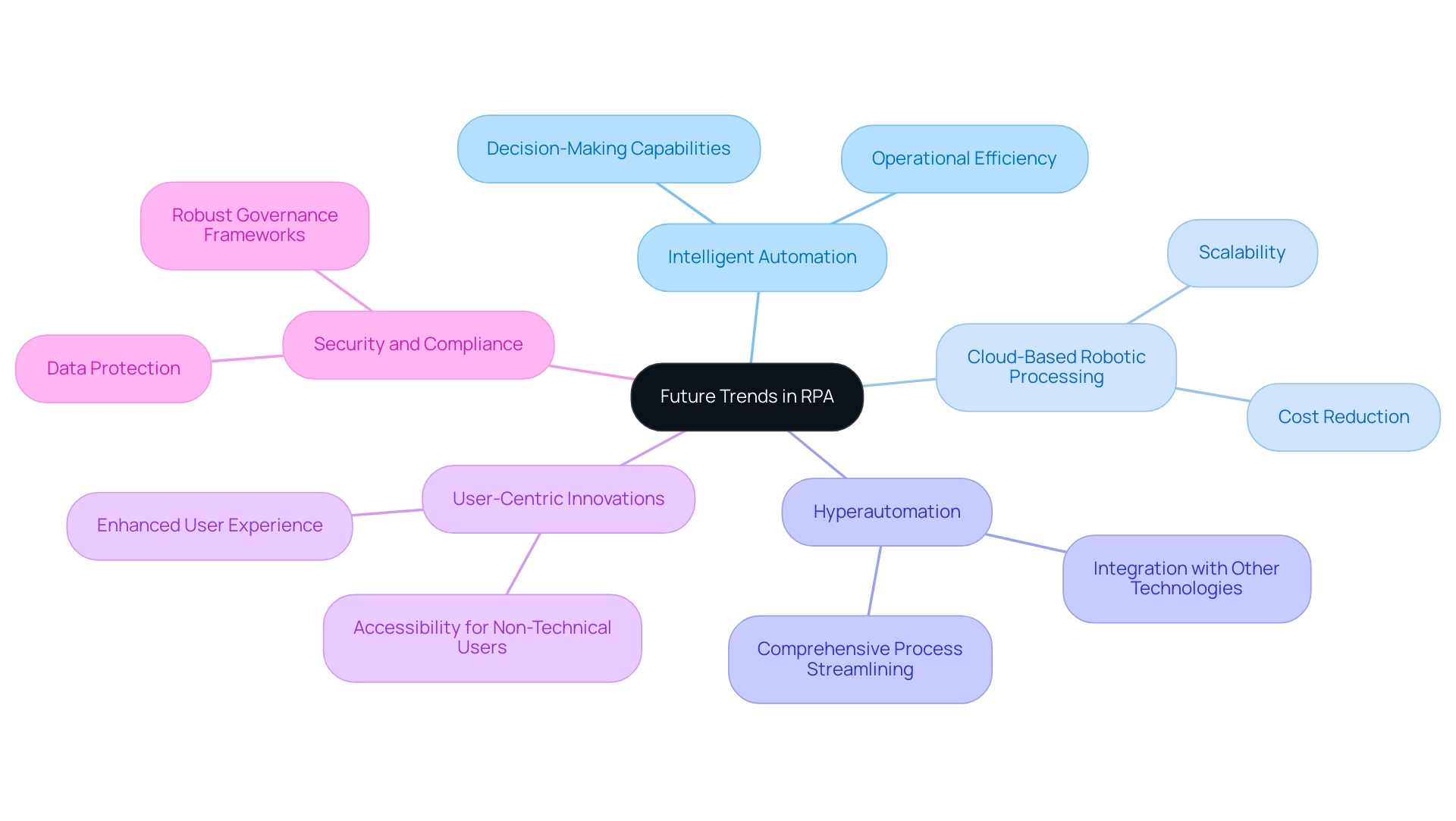
Conclusion
The implementation of Robotic Process Automation (RPA) is not merely a technological upgrade; it represents a strategic shift that can redefine operational efficiency across various industries. By automating repetitive tasks, organizations can significantly reduce costs, improve data quality, and enhance overall productivity. The ability to redirect human resources towards more strategic initiatives not only boosts employee satisfaction but also fosters a culture of innovation that is essential for long-term success.
Despite the myriad benefits, the journey to successful RPA integration is fraught with challenges, including:
– Resistance to change
– Integration complexities
– The need for skilled personnel
However, by proactively addressing these obstacles with effective change management and tailored solutions, organizations can unlock the full potential of RPA. As the market continues to evolve, embracing intelligent automation and cloud-based solutions will further enhance capabilities, allowing businesses to remain competitive in an increasingly digital landscape.
In conclusion, the future of RPA is bright, with emerging trends poised to drive even greater efficiencies and innovations. Organizations that adapt to these changes will not only streamline their operations but also position themselves as leaders in their respective fields. The time to act is now; harnessing the power of RPA can propel businesses toward achieving their strategic goals and thriving in the modern marketplace.
Introduction
In a world increasingly driven by technology, automation emerges as a game-changer, reshaping the landscape of operational efficiency across various industries. From reducing the burden of repetitive tasks to enhancing decision-making through intelligent systems, the integration of automation is no longer a luxury but a necessity for organizations striving to stay competitive.
However, the journey to successful automation is fraught with challenges, including:
- Resistance to change
- The complexities of integrating new technologies with legacy systems
This article delves into the essentials of automation, its intersection with artificial intelligence, and a practical guide to implementation, equipping organizations with the knowledge to navigate potential pitfalls and unlock the full potential of their operational capabilities.
By embracing these strategies, businesses can transform their workflows, improve productivity, and foster a culture of innovation that thrives in the face of constant change.
Understanding the Basics of Automation
The use of technology involves understanding how does automation work by integrating systems to perform tasks with minimal human involvement, significantly altering operational environments across industries. It can manifest in various forms, from straightforward scripts that automate routine functions to sophisticated systems that orchestrate entire workflows seamlessly. Key aspects of automation include:
- Definition: At its core, automation serves to streamline processes, drastically reducing manual effort and enhancing overall efficiency. Robotic Process Automation (RPA) illustrates how does automation work by automating routine tasks and improving accuracy, which frees employees to focus on strategic initiatives.
- Purpose: The primary objective is to eliminate repetitive tasks, thereby improving accuracy and allowing employees to dedicate their expertise to more strategic initiatives. As Pierre Nanterme aptly stated, “Digital is the main reason just over half of the companies on the Fortune 500 have disappeared since the year 2000,” which emphasizes the critical need for businesses to understand how does automation work in adopting automated processes.
- Industry Impact: Digitalization and mechanization are transforming the services industry, affecting all sectors and necessitating a proactive approach to adapt to these changes. In healthcare, for example, GUI mechanization has been demonstrated to greatly improve operational efficiency by decreasing data entry mistakes by 70% and speeding up testing activities by 50%.
- Challenges: However, companies often face challenges in adopting automated processes, such as resistance to change, integration with legacy systems, and the need for skilled personnel. Tailored AI solutions can help address these challenges by providing customized approaches that align with specific business needs.
- Business Intelligence: Utilizing business intelligence along with automated systems can further improve decision-making methods, enabling organizations to convert data into actionable insights that stimulate growth.
- Examples: Automation finds its application in numerous areas, including email marketing campaigns that nurture leads, data entry tasks that minimize errors, and inventory management systems that optimize stock levels. Moreover, platforms such as Tigersheet, a no-code solution, assist in automating and streamlining business processes effortlessly, making these tools accessible to a broader array of enterprises. These examples demonstrate how does automation work by showing how successful mechanization can result in significant enhancements in operational effectiveness and workforce productivity.
- Case Study: A recent case analysis demonstrated how a mid-sized company enhanced productivity by utilizing GUI technology to address issues like manual data entry mistakes and sluggish software testing, resulting in an 80% improvement in workflow productivity and attaining ROI within 6 months. The article titled “Effective Strategies for Efficiency” suggests that businesses should focus on how to manage repetitive tasks rather than who should manage them. By evaluating workflows and recognizing opportunities for automation, businesses can enhance processes and increase productivity.
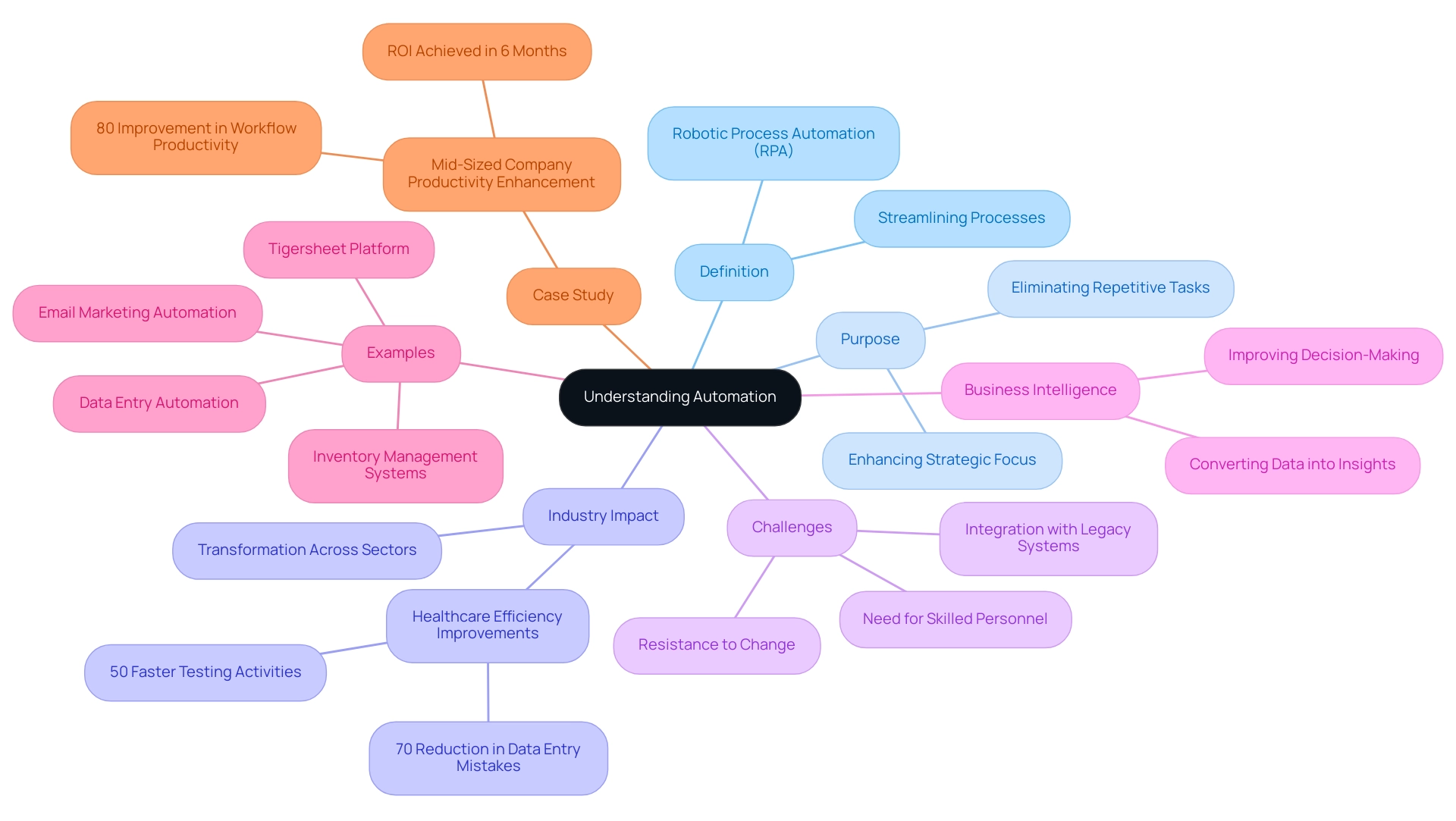
The Intersection of Automation and Artificial Intelligence
Mechanization and Artificial Intelligence (AI) are closely connected but fundamentally distinct ideas that serve essential functions in operational productivity. Understanding these distinctions is essential for effective implementation:
- Automation refers to the execution of predefined tasks without the need for human intervention. This procedure is intended to enhance efficiency and reduce mistakes in repetitive tasks, illustrating how does automation work. Our Robotic Process Automation (RPA) solutions, such as EMMA RPA and Microsoft Power Automate, exemplify this by streamlining workflows, alleviating the burden of manual, repetitive tasks, and addressing issues like task repetition fatigue and staffing shortages.
- Artificial Intelligence, on the other hand, encompasses the development of systems that can mimic human intelligence, allowing machines to learn from data and make informed decisions. John McCarthy succinctly captures this relationship by stating, “Artificial intelligence is the science of making machines do things that would require intelligence if done by humans.”
The integration of AI into automated processes helps illustrate how does automation work, significantly enhancing their capabilities. By introducing cognitive functionalities, AI empowers automated systems to adapt and optimize workflows, prompting us to explore how does automation work based on real-time data analysis. For instance, chatbots exemplify this integration; they automate customer service interactions while continuously learning from each engagement, ultimately improving user experience.
As we look toward 2024, the statistics reflect a growing trend: over half of Fortune 500 companies have vanished since 2000 due to the pressures of digitalization. This emphasizes the urgent need for effective mechanization strategies to overcome outdated systems and enhance productivity. Moreover, addressing potential conflicts of interest arising from technological anxiety among employees is crucial for fostering a culture of innovation and adaptability within organizations.
The ‘Predictions of Singularity‘ further emphasize the profound changes that may occur if AI surpasses human intelligence, highlighting the importance of carefully considering AI’s development and its implications for the workforce. EMMA RPA, featuring its user-friendly interface and diverse applications, transforms processes by enhancing operational efficiency. Power Automate, with its AI-powered capabilities, connects apps and data to streamline workflows, ensuring that businesses can adapt to modern challenges effectively.
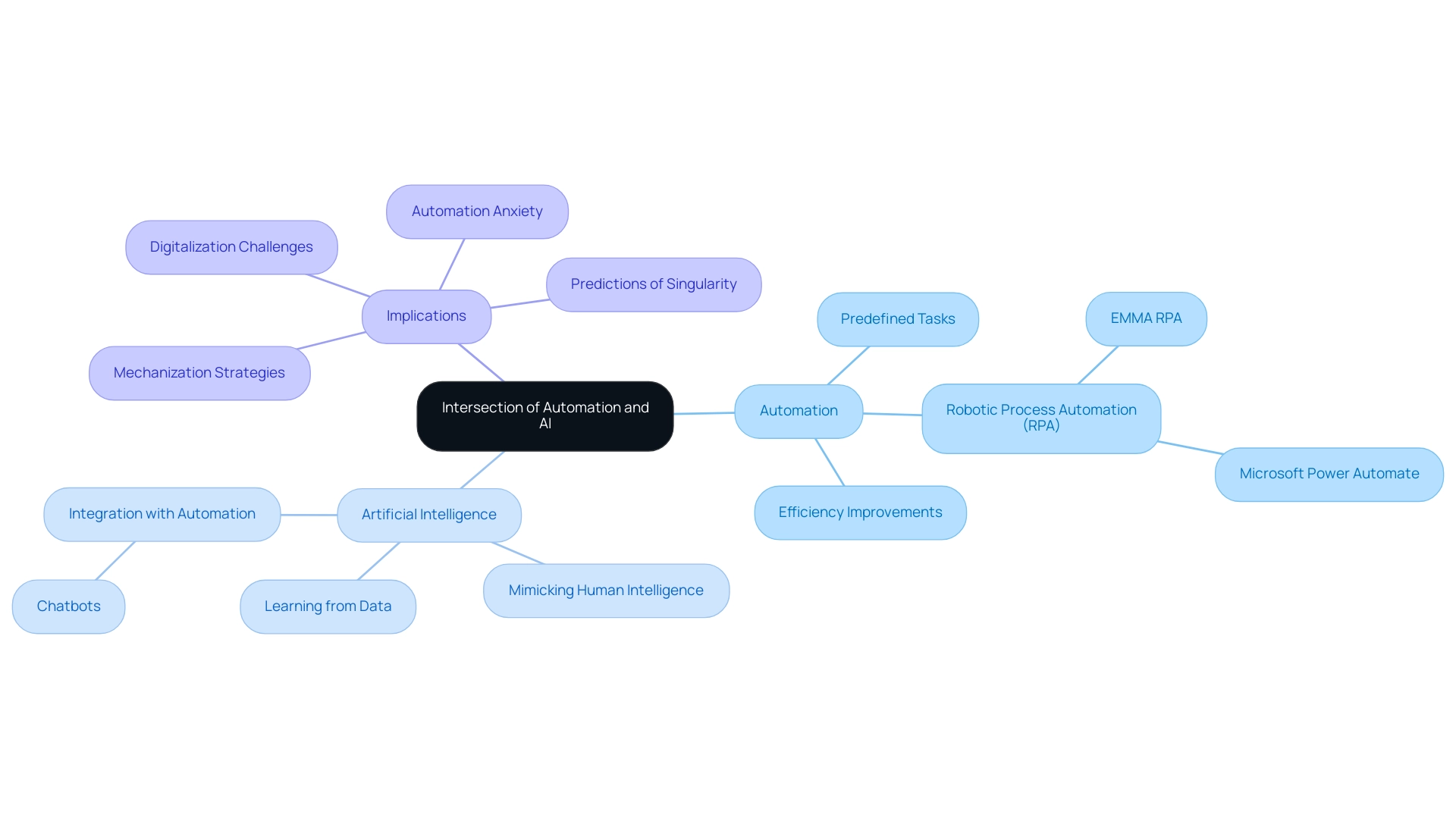
A Step-by-Step Guide to Implementing Automation
To implement mechanization effectively in your organization, follow this comprehensive step-by-step guide:
-
Identify Repetitive Tasks: Begin by conducting a thorough analysis of your workflows to pinpoint tasks that are not only time-consuming but also susceptible to human error. Recognizing that these tasks may also benefit from manual testing ensures that you can uncover issues that automated tests may miss. This foundation will help prioritize which processes to automate first, addressing common workplace challenges that can diminish morale and productivity, thereby explaining how does automation work.
-
Set Clear Goals: Establish specific objectives for your mechanization efforts to clarify how does automation work. Whether your emphasis is on lowering operational expenses, boosting productivity, or refining service delivery, having clear objectives will steer your technological strategy. It’s essential to include goals related to maintaining quality through manual testing, as it remains necessary to verify that business requirements are met, especially in an environment where talent retention can be a challenge due to difficulties in attracting and retaining the right personnel for operational roles.
-
Choose the Right Tools: Conduct detailed research to select tools for mechanization that align with both your organizational goals and your existing technology stack. Look for tools that offer scalability, ease of integration, and robust support to ensure a smooth transition. These tools should not only aid in mechanization but also improve the overall effectiveness of your operations, particularly in learning how does automation work to address the difficulties presented by obsolete systems that can hinder workflows and suppress innovation.
-
Develop a Pilot Program: Initiate a small-scale pilot program to test the chosen mechanization process. This trial run helps you explore how does automation work in identifying potential challenges and refining your approach before committing to a full-scale implementation. During this phase, incorporating manual testing can help to validate the effectiveness of the automated processes and ensure that your team is prepared for the changes ahead.
-
Train Your Team: Equip your team with the training necessary to thrive in an automated environment. Promoting ongoing learning and adaptation is essential to nurture a culture of innovation and productivity, as it helps teams understand how does automation work. Training should also address the significance of manual testing as a component of your overall strategy, supporting the aim of maximizing productivity while minimizing errors.
-
Monitor and Optimize: Establish metrics for success and continuously track performance. Consistently assess the results of the processes and implement data-informed modifications to improve both efficiency and effectiveness. This involves evaluating the role of manual testing in your ongoing activities, ensuring that your organization stays agile and responsive to changes in workflow demands.
-
Incorporate Manual Testing: Acknowledging that mechanized processes have their boundaries, it’s essential to integrate manual testing into your procedures. As noted by Priyanka Sharma, a Senior Systems Software Engineer at NVIDIA,
Manual testing is the only way to verify that the business requirements are successfully met and the customer gets the desired experience.
This balance guarantees that quality is upheld while utilizing the advantages of technology, ultimately boosting business productivity through Robotic Process Automation (RPA), customized AI solutions, and actionable insights.
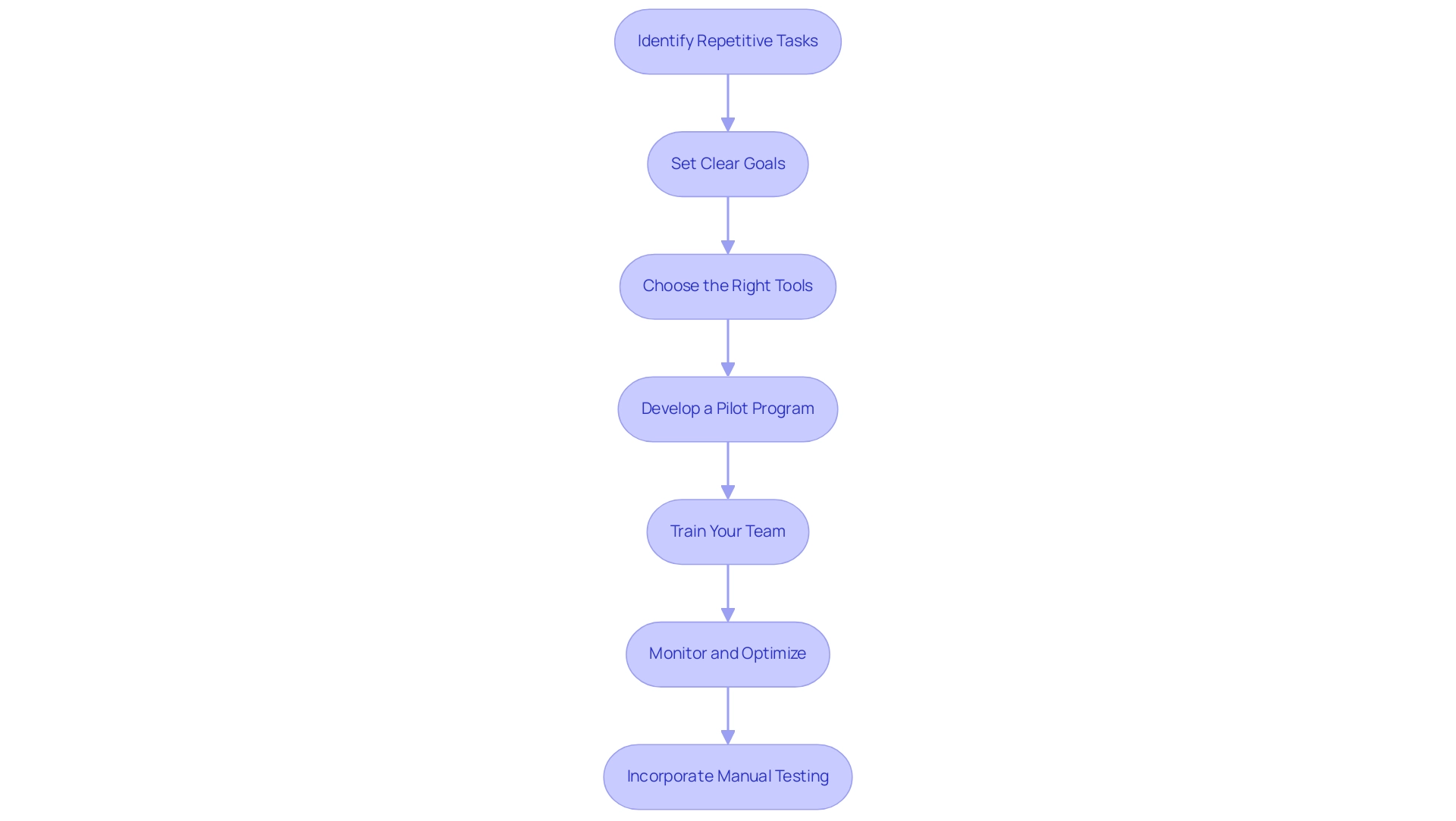
Exploring Different Types of Automation Technologies
When examining automated technologies, it’s crucial to comprehend the varied choices accessible, each customized to particular organizational requirements:
- Robotic Process Automation (RPA): This groundbreaking technology streamlines repetitive tasks through software robots that imitate human actions, significantly enhancing productivity and enabling employees to shift their attention toward more strategic activities. RPA allows organizations to tackle manual workflow challenges, thereby improving operational performance in a rapidly evolving AI landscape, which demonstrates how does automation work. However, organizations should be aware of high initial setup costs and potential resistance from workers when implementing RPA.
- Business Process Automation (BPA): BPA streamlines complex business processes involving multiple systems and stakeholders, improving operational efficiency and fostering interdepartmental collaboration, which helps to understand how does automation work.
- IT Process Automation (ITPA): ITPA automates essential IT operations, such as system monitoring, backups, and incident response, illustrating how does automation work to reduce downtime and optimize resource management.
- Workflow Management: This technology simplifies business workflows by managing the flow of information and tasks among various systems and users, illustrating how does automation work to promote a seamless operational environment.
- How does automation work: By integrating AI capabilities into processes, organizations can enhance decision-making and adapt based on data insights, which illustrates how automation work towards smarter operations. Customized AI solutions can assist in tackling particular business challenges, ensuring that the systems implemented align with organizational goals.
As pointed out by Mikell P. Groover, a notable figure in industrial engineering, > Another significant advancement in the history of mechanization was the Jacquard loom, which showcased the idea of a programmable machine <. The Jacquard loom, created by Joseph-Marie Jacquard around 1801, was able to produce intricate designs in textiles, demonstrating the early influence of mechanization on manufacturing. This historical viewpoint, together with Charles Babbage’s suggestion of the mechanical ‘analytical engine’ in the 19th century, demonstrates the progression of mechanization and its foundational role in contemporary technology.
The advantages of mechanization in manufacturing include increased productivity, reduced labor costs, improved quality control, and enhanced safety, while challenges such as high initial setup costs and potential resistance from workers are important considerations for organizations.

Navigating Challenges in Automation Adoption
Understanding how does automation work is crucial, as embracing automated technologies can present several challenges that organizations must navigate effectively to ensure a smooth transition. Key obstacles include:
-
Resistance to Change: Employees often express hesitance towards new technologies. A case study titled ‘Streamlining Operations with GUI Automation’ illustrates how does automation work, as a mid-sized healthcare company faced initial resistance to systemization in data entry and software testing.
By involving team members in the decision-making process and providing comprehensive training, the company empowered its workforce to embrace these new tools, leading to a 70% reduction in data entry errors. -
Integration Issues: Ensuring that new mechanization solutions integrate seamlessly with existing systems is a significant hurdle. For the aforementioned company, understanding how does automation work through thorough compatibility assessments prior to implementing GUI mechanization helped identify potential conflicts, particularly with outdated systems lacking APIs, and address them proactively, resulting in enhanced software quality and a 50% acceleration in testing processes.
-
Lack of Clear Objectives: Mechanization initiatives without defined goals are likely to struggle. Establishing specific, measurable objectives at the outset guided the healthcare company’s process optimization efforts, motivating the team and aligning their actions towards common goals, ultimately achieving an 80% improvement in workflow efficiency, which illustrates how does automation work to generate a return on investment within six months.
-
Data Quality Concerns: Reliable systems are built on accurate data. Investing in data cleansing and management practices is crucial to eliminate inaccuracies, which helps in understanding how does automation work to ensure that the outputs produced by automated tools reflect the best possible quality.
-
Ongoing Maintenance: Automated systems require regular maintenance and updates to perform optimally. Developing a long-term support plan that includes scheduled evaluations and upgrades ensures sustained effectiveness and adaptability in the face of evolving needs, and understanding how does automation work is crucial for overcoming resistance to change, requiring a combination of user-friendly tools and effective change management to foster a culture of adaptability in organizations.
Our GenAI workshops focus on enhancing business operations with personalized AI experiences, hands-on training, integration strategies, and ethical usage, directly addressing the automation challenges faced by the healthcare company and emphasizing that embracing change is essential for growth and innovation.
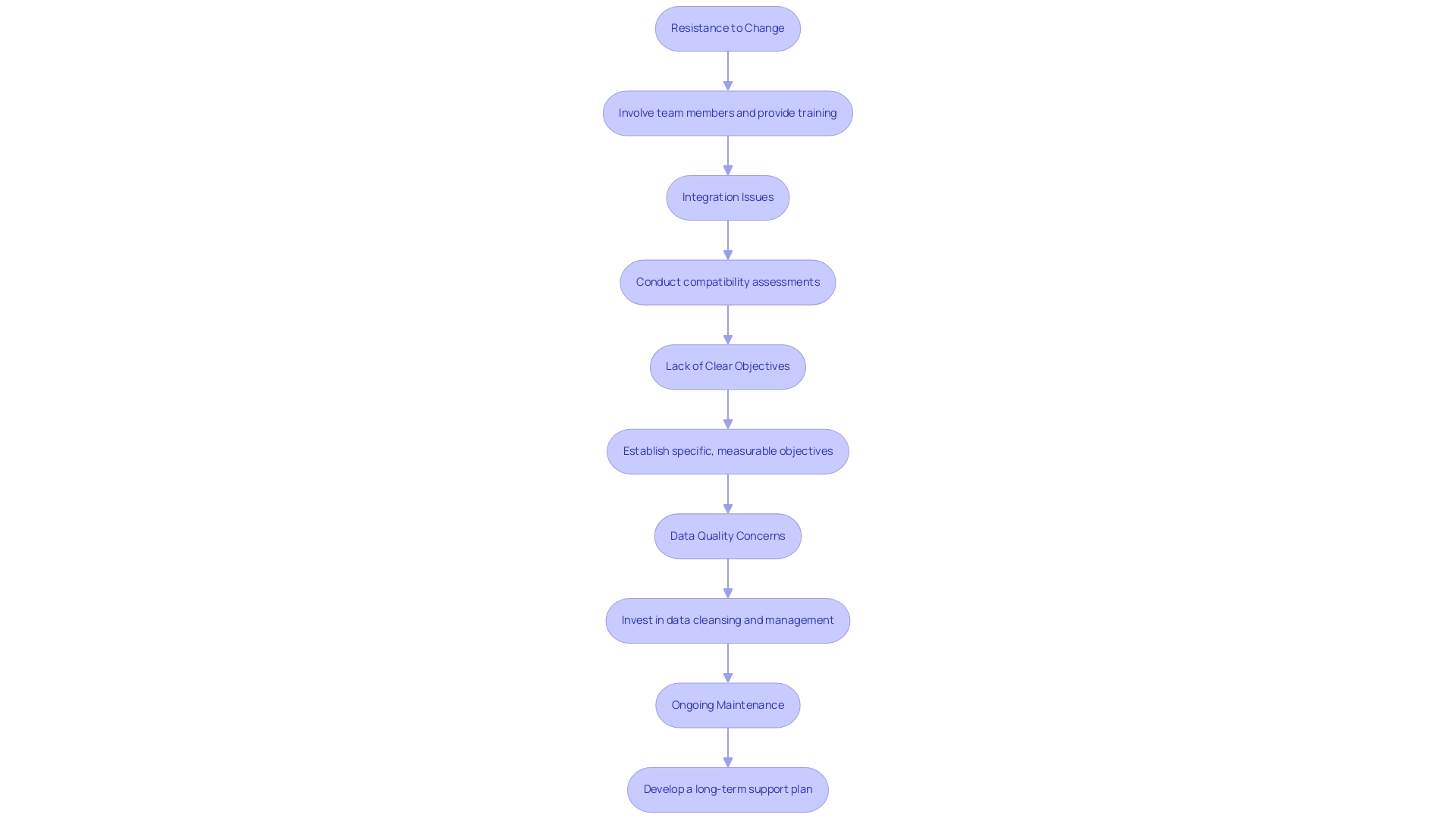
Conclusion
Embracing automation is not merely a response to the demands of modern industry; it is a strategic imperative for organizations seeking to thrive in an increasingly competitive landscape. By understanding the fundamentals of automation, its intersection with artificial intelligence, and the various technologies available, businesses can effectively streamline operations and enhance productivity.
The journey toward successful automation involves:
- Identifying repetitive tasks
- Setting clear objectives
- Choosing the right tools to facilitate integration
Implementing a pilot program and investing in team training ensures that organizations are well-prepared to leverage automation effectively. Moreover, recognizing and addressing challenges such as resistance to change and integration issues are crucial in fostering a culture of innovation and adaptability.
Ultimately, the successful implementation of automation not only transforms workflows but also empowers employees to focus on strategic initiatives that drive growth. By committing to this transformative journey, organizations can unlock new levels of operational efficiency, paving the way for sustained success in the face of evolving market demands. Now is the time to take action, harness the power of automation, and redefine the future of work.
Introduction
In the rapidly evolving world of artificial intelligence, Large Language Models (LLMs) stand at the forefront, revolutionizing the way organizations approach data and education. These sophisticated systems not only generate human-like text but also present unique challenges that must be addressed for effective integration.
As educators and business leaders seek to harness the power of LLMs, understanding their capabilities and limitations becomes crucial. By exploring practical strategies for implementation, such as adopting Custom Small Language Models (SLMs) tailored to specific needs, organizations can enhance operational efficiency and foster innovative educational experiences.
This article delves into the fundamentals of LLMs, best practices for their integration in educational settings, and the future trends that promise to reshape the landscape of AI in both learning and business contexts.
Understanding the Basics of Large Language Models (LLMs)
Current llms are sophisticated AI systems designed to understand and generate human-like text by leveraging vast datasets and deep learning techniques. While they can produce coherent and contextually relevant responses, their limitations include a lack of true understanding and reasoning capabilities. This is crucial to consider, especially for organizations grappling with poor master data quality, which can hinder effective AI implementation.
However, by embracing Custom Small Language Models (SLMs), organizations can overcome these challenges. SLMs offer tailored solutions for:
– Efficient data analysis
– Enhanced privacy through on-premise deployment
– Cost-effectiveness due to lower computational demands
Moreover, SLMs can significantly reduce the time and cost associated with AI projects, making the integration process smoother and more accessible.
Grasping these fundamentals enables leaders to establish realistic expectations for AI integration, employing these systems as powerful tools to enhance operations instead of perceiving them as intricate obstacles.
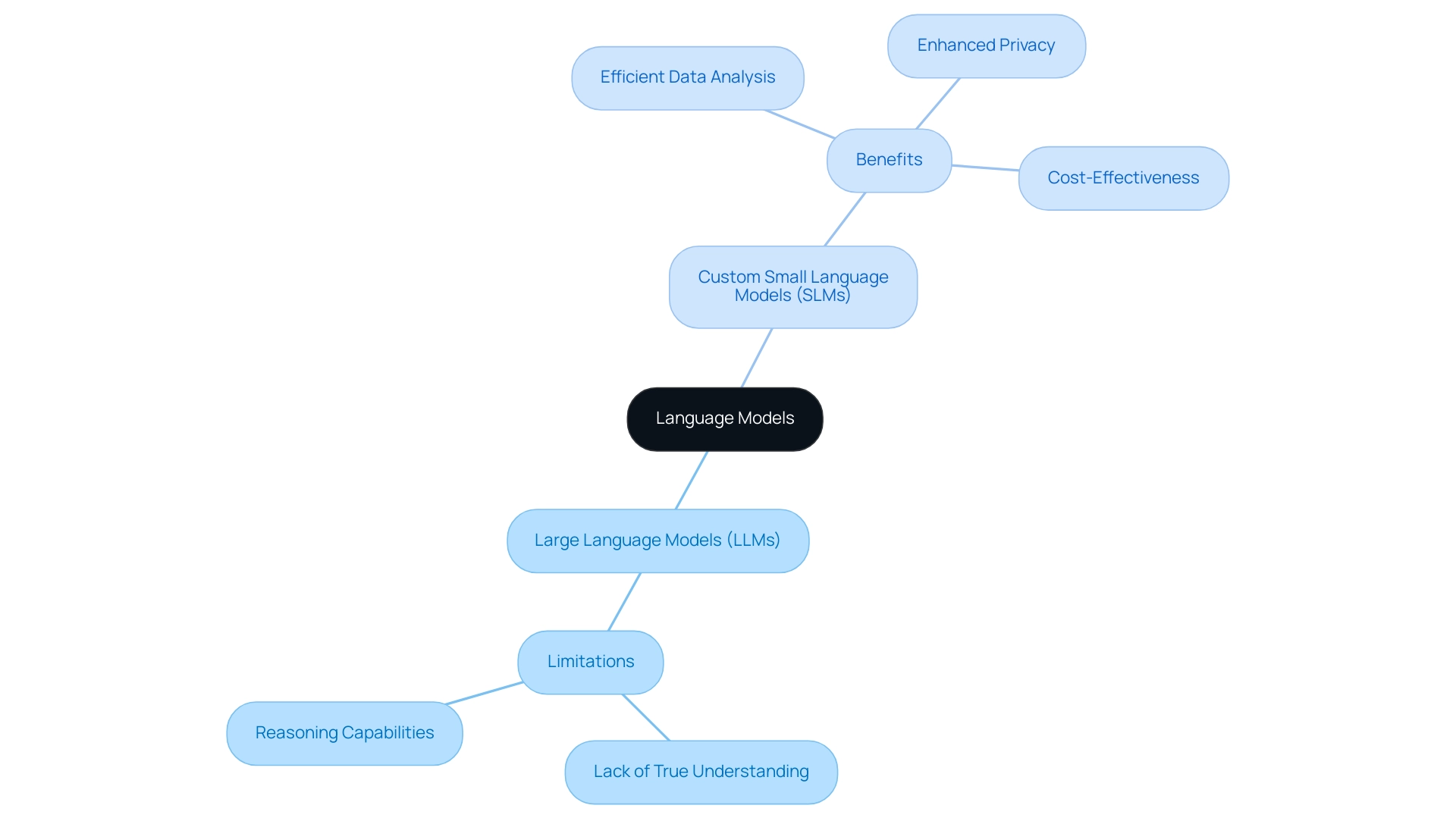
Leveraging LLMs for Effective Teaching Strategies
Educators have a remarkable opportunity to utilize large language systems to enhance their teaching strategies. These models can create personalized educational materials that cater to the unique needs of each student, effectively promoting differentiated instruction and ensuring that all learners receive the support they require. Moreover, current llms can enhance interactive educational experiences by mimicking real-world dialogues, enabling students to hone their language abilities in significant contexts.
This approach not only enhances engagement but also builds confidence in their abilities. Additionally, the ability of large language models to provide instant feedback on student writing is invaluable. This feature encourages learners to refine their skills through iterative practice, fostering a growth mindset.
By thoughtfully incorporating current llms into lesson plans, educators can create dynamic learning experiences that inspire active participation and critical thinking.
However, it is crucial to address the ethical implications of using large language models in education, particularly regarding publication ethics. As educators develop materials using language models, they must ensure that the content adheres to ethical standards and respects intellectual property rights. Additionally, current llms can enhance access to learning resources through open access initiatives, allowing broader distribution of study materials and fostering equity in education.
Moreover, the incorporation of current llms can simplify processes in academic publishing, especially through manuscript tracking systems. These systems can gain advantages from current llms by automating aspects of submission and review, thus enhancing efficiency in managing learning materials. While large language models offer significant advantages, they should serve as supplementary tools that enhance traditional teaching methods rather than replace the essential human insight and guidance that educators provide.
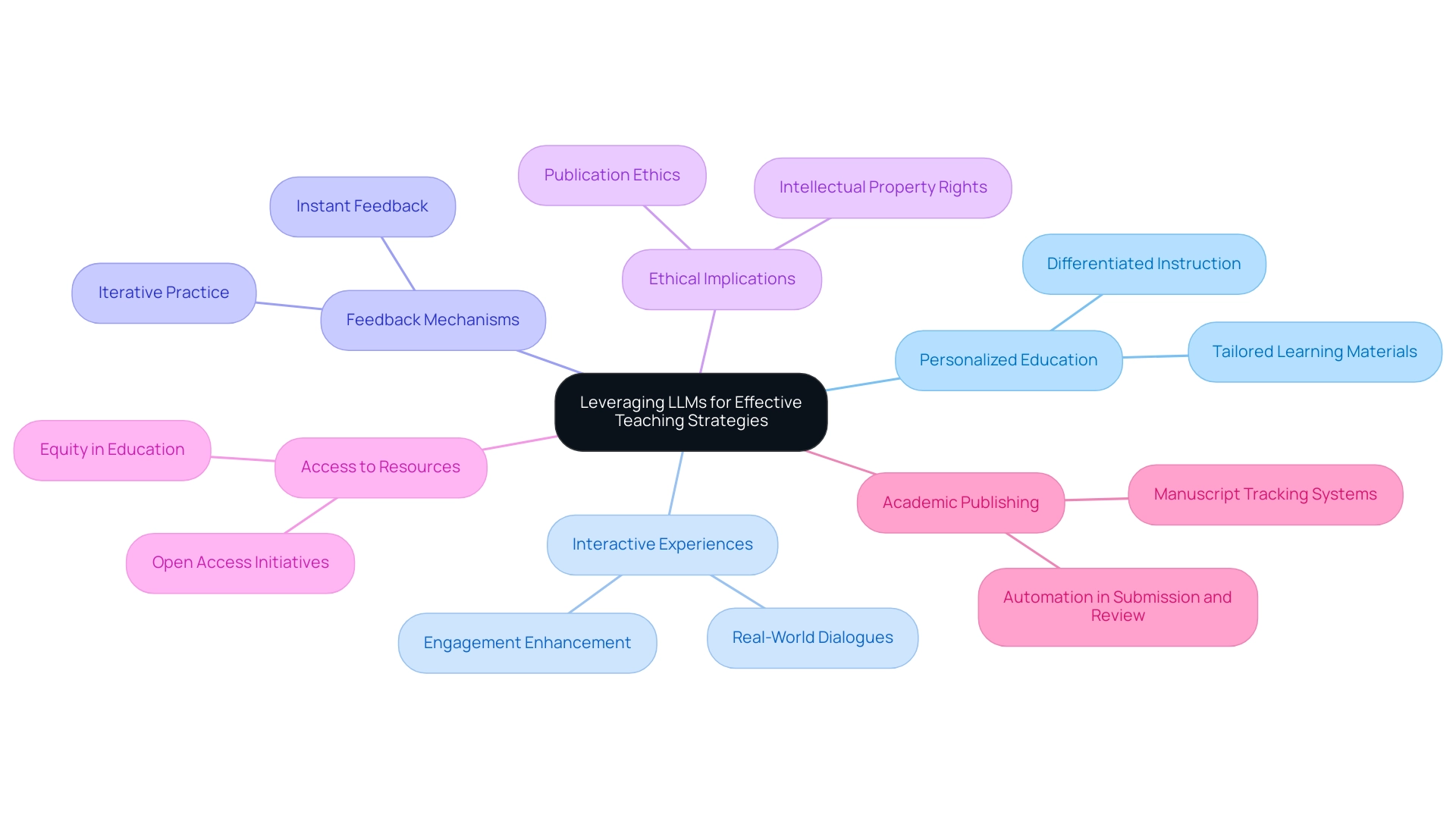
Best Practices for Integrating LLMs in Educational Settings
To effectively integrate current llms in educational settings, educators should adopt a few best practices:
- Establish clear guidelines on how to use current llms responsibly, including discussions about data privacy and the ethical implications of AI technology.
- Provide training for both educators and students on how to interact effectively with current llms, ensuring that they understand the limitations of these models.
- Encourage critical thinking by prompting students to analyze and question the information produced by language models, fostering a culture of inquiry.
- Regularly evaluate the effect of current llms integration on student learning outcomes to refine strategies and ensure that the technology is enhancing the learning experience rather than detracting from it.
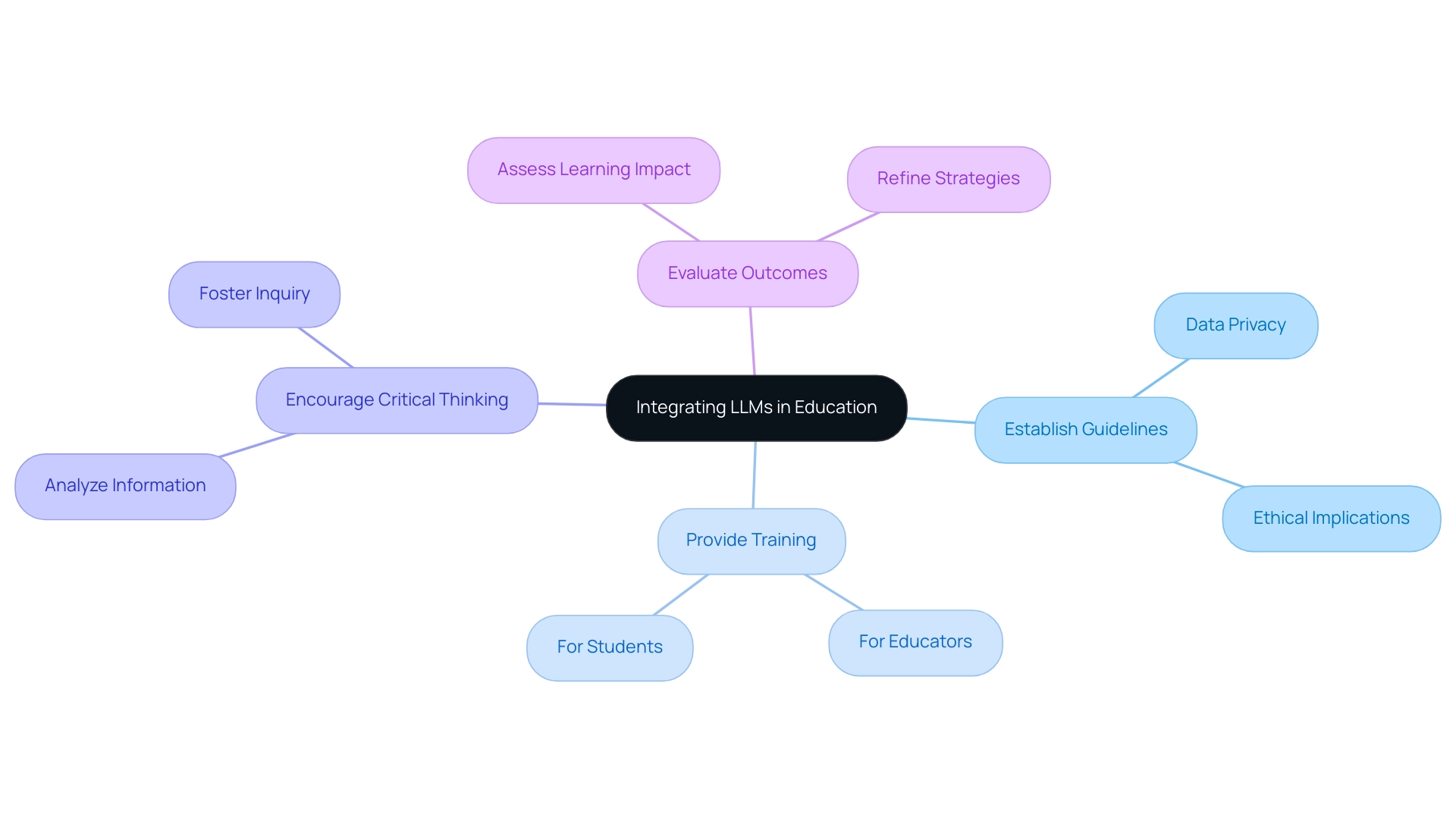
Challenges and Limitations of LLMs in Education
While current llms hold immense potential for enhancing educational experiences, they also present significant challenges that educators must navigate. One of the primary concerns is the propensity for these models to generate biased or inappropriate content, a reflection of the biases embedded in the data they are trained on. With over 2.3 billion citations in the research community highlighting the prevalence of this issue, it is essential that educators actively review and curate the outputs of large language models to maintain content appropriateness.
Moreover, current llms may face difficulties with context-dependent inquiries, potentially resulting in incorrect or irrelevant responses that could mislead students if not carefully framed and monitored.
Moreover, the emotional intelligence of large language models is significantly deficient; they cannot emulate the human empathy crucial for nurturing meaningful learning interactions. As Hao Qin highlights, instructional platforms such as Khan Academy have started incorporating AI tutors powered by current llms to deliver personalized experiences, yet the challenges persist significantly. Future research should concentrate on improving the accuracy and emotional intelligence of current llms, as these enhancements are vital for advancing personalized and adaptive education in educational environments.
Furthermore, the key aspect of HTM improving accuracy and speed during tool retrieval is vital, as it alleviates cognitive load on the system and can enhance the overall learning experience. The case study ‘Transforming Education with Current LLMS‘ emphasizes the need for a balanced integration of current LLMS, advocating for the development of ethical frameworks and strategies to mitigate bias. This case study highlights the importance of robust content verification and the establishment of clear boundaries for LLM application in the classroom, ensuring that the benefits of these technologies can be maximized while safeguarding learners.

Future Trends in LLMs and Their Impact on Education
The terrain of current LLMs is continuously evolving, with trends indicating that future iterations will become more sophisticated in understanding context and nuance. As organizations face challenges with poor master data quality and barriers to AI adoption, including perceptions that AI projects are time-intensive, costly, and challenging to implement, innovations such as fine-tuning LLMs for specific industry needs can provide tailored and effective interactions. Custom Small Language Models (SLMs) empower businesses by offering enhanced data analysis capabilities while ensuring data privacy and security.
SLMs are also cost-effective, requiring less computational power, which makes them more affordable to implement and maintain. Furthermore, as multimodal models combining text, images, and sounds become more prevalent, the potential for interactive and engaging business processes will increase. Directors of Operations should stay informed about these developments and consider how to integrate new features into their strategies.
By fostering a culture of continuous learning and adaptability, organizations can leverage current LLMs to enhance operational efficiency and drive innovation. Book a free consultation to explore how our tailored solutions can meet your specific needs.
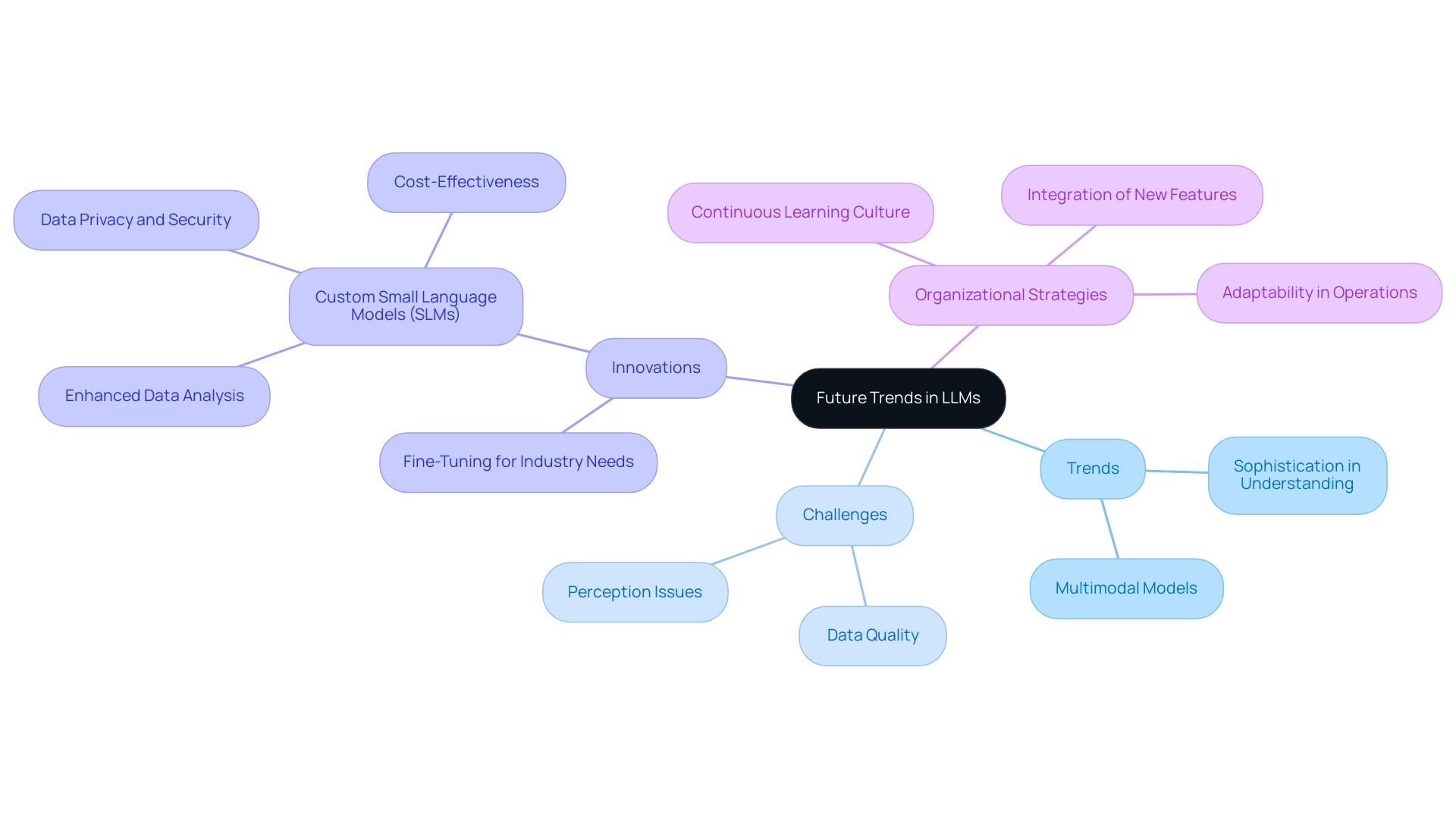
Conclusion
The integration of Large Language Models (LLMs) into education and business represents a transformative opportunity, yet it comes with its own set of challenges. Understanding the foundational aspects of LLMs and their tailored counterparts, Custom Small Language Models (SLMs), is critical for leaders looking to navigate this complex landscape. By embracing these technologies, organizations can enhance operational efficiency, foster innovative educational experiences, and create personalized learning environments that cater to diverse learner needs.
However, the potential of LLMs is not without limitations. Issues such as bias in generated content and the lack of emotional intelligence highlight the importance of responsible implementation. Establishing clear guidelines, providing training, and fostering critical thinking are essential practices that can mitigate these challenges while maximizing the benefits of LLMs in educational settings. As educators and business leaders adopt these models, they must remain vigilant and proactive, continually assessing their impact on learning outcomes and operational effectiveness.
Looking ahead, the future of LLMs is promising, with advancements poised to enhance their contextual understanding and usability. By staying informed about emerging trends and innovations, organizations can leverage LLMs and SLMs to drive meaningful change. The journey towards effective AI integration is ongoing, and with the right strategies in place, both education and business can thrive in this new era of artificial intelligence. Embracing this change not only prepares organizations for future challenges but also empowers them to lead with confidence in a rapidly evolving technological landscape.
Introduction
In the rapidly evolving landscape of modern business, organizations are increasingly turning to Robotic Process Automation (RPA) as a key driver of efficiency and innovation. By harnessing the power of software robots to automate routine tasks, businesses can unlock substantial gains in productivity while simultaneously reducing operational costs.
This article delves into the various types of RPA, highlighting their distinct functionalities and the significant benefits they offer. It also addresses the common challenges organizations face during implementation, providing practical strategies to overcome these obstacles.
As RPA technology continues to advance, understanding its future trends will be essential for organizations aiming to stay ahead in a competitive market. By exploring these facets of RPA, businesses can better position themselves to enhance operational effectiveness and foster a more engaged workforce.
Understanding Robotic Process Automation: Types and Definitions
Robotic Process Automation (RPA) is a transformative technology that shows what RPA can do by enabling organizations to automate repetitive, rule-based activities traditionally handled by human workers. By deploying software robots, or ‘bots’, RPA demonstrates what can RPA do by streamlining processes across a multitude of applications, significantly boosting operational efficiency. There are three primary types of RPA:
- Attended RPA: These bots operate alongside human employees, automating parts of their responsibilities while requiring human initiation for activation. This collaborative approach not only enhances productivity but also ensures that employees remain engaged in their roles.
- Unattended RPA: Operating independently, these bots perform activities autonomously without human oversight, often optimized to run during off-peak hours. This capability can lead to significant time savings and operational efficiencies.
- Hybrid RPA: This model merges the advantages of attended and unattended RPA, offering entities the flexibility to customize execution based on specific operational needs. Identifying these forms of RPA is crucial for organizations seeking to understand what can RPA do in establishing effective solutions that align with their operational objectives. With 74% of users reporting that automated tools expedite task completion and 91% of employees affirming that these systems enhance time management and work-life balance, it is clear what RPA can do in terms of elevating productivity and fostering a more satisfying work environment.
Furthermore, a case study on a mid-sized company revealed that implementing GUI automation reduced data entry errors by 70% and accelerated testing processes by 50%, achieving an ROI within six months. The company faced challenges such as manual data entry errors and slow software testing, which were effectively addressed through RPA. This highlights what RPA can do to enhance operational efficiency and employee morale.
As entities consider their RPA strategy, understanding these distinctions, along with the integration of tailored AI solutions and business intelligence, will guide them in selecting the most suitable approaches to meet their unique needs, ultimately overcoming technology implementation challenges and enhancing efficiency.
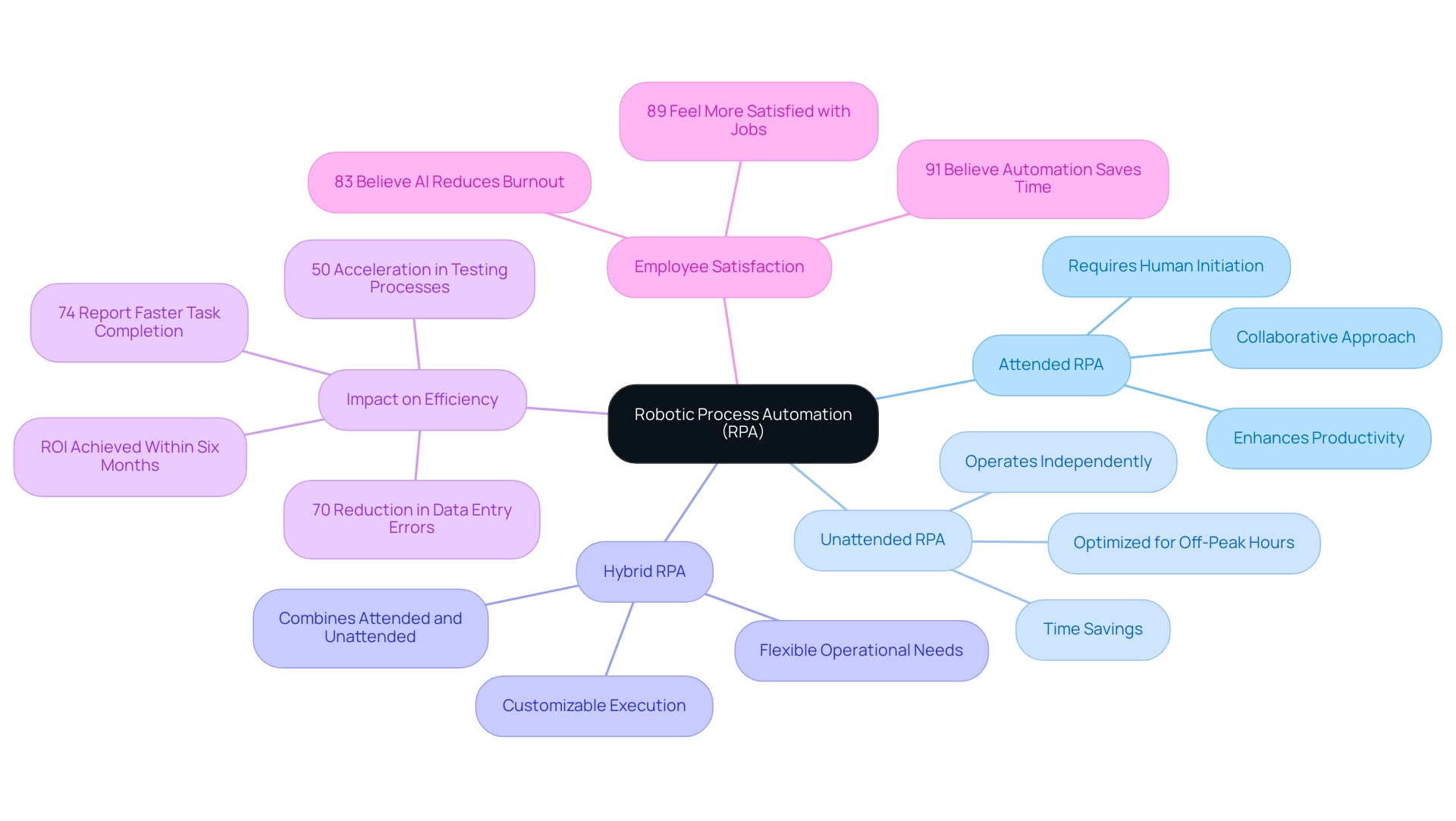
Key Benefits of RPA: Enhancing Efficiency and Reducing Costs
Implementing Robotic Process Automation (RPA) demonstrates what RPA can do by offering a multitude of advantages that significantly enhance operational efficiency and reduce costs. Key benefits include:
- Increased Efficiency: RPA can execute tasks at a speed that surpasses human capabilities, leading to remarkable reductions in processing times.
- Cost Reduction: By automating repetitive activities, entities not only lower labor costs but also minimize human error, resulting in decreased operational expenses.
Statistics reveal that companies employing RPA have observed substantial cost savings, with many reporting reductions of up to 30% in labor costs alone.
– Enhanced Accuracy: Automation ensures high precision in execution, resulting in fewer errors and improved data integrity, which is crucial for maintaining compliance, particularly in sectors like healthcare. As Tufayel Ahmed notes,
RPA improves the quality, completeness, timeliness, and interoperability of healthcare data.
Furthermore, 92% of respondents reported improved compliance with the use of RPA in healthcare, highlighting its effectiveness in this area.
– Scalability: RPA enables organizations to quickly scale operations without necessitating a proportional increase in workforce, allowing for agile responses to changing business demands.
– Employee Empowerment: By relieving employees from repetitive duties, RPA enables them to participate in more strategic, value-added activities, consequently enhancing job satisfaction and overall productivity.
Moreover, RPA solutions tackle critical challenges such as repetition fatigue and staffing shortages, offering a means to modernize outdated systems. For instance, a financial institution that adopted RPA for transaction processing reported an impressive 70% reduction in processing time alongside a significant decline in operational costs. Additionally, the integration of robotics is illustrated by a stylized image of a human figure collaborating with robotic figures, emphasizing the synergy between human intelligence and automation.
RPA has the potential to revolutionize healthcare by automating repetitive tasks, showcasing what RPA can do, as illustrated by the case study titled ‘Closing Thoughts on RPA in Healthcare,’ which emphasizes the transformative potential of RPA in enhancing business efficiency and delivering better patient outcomes.
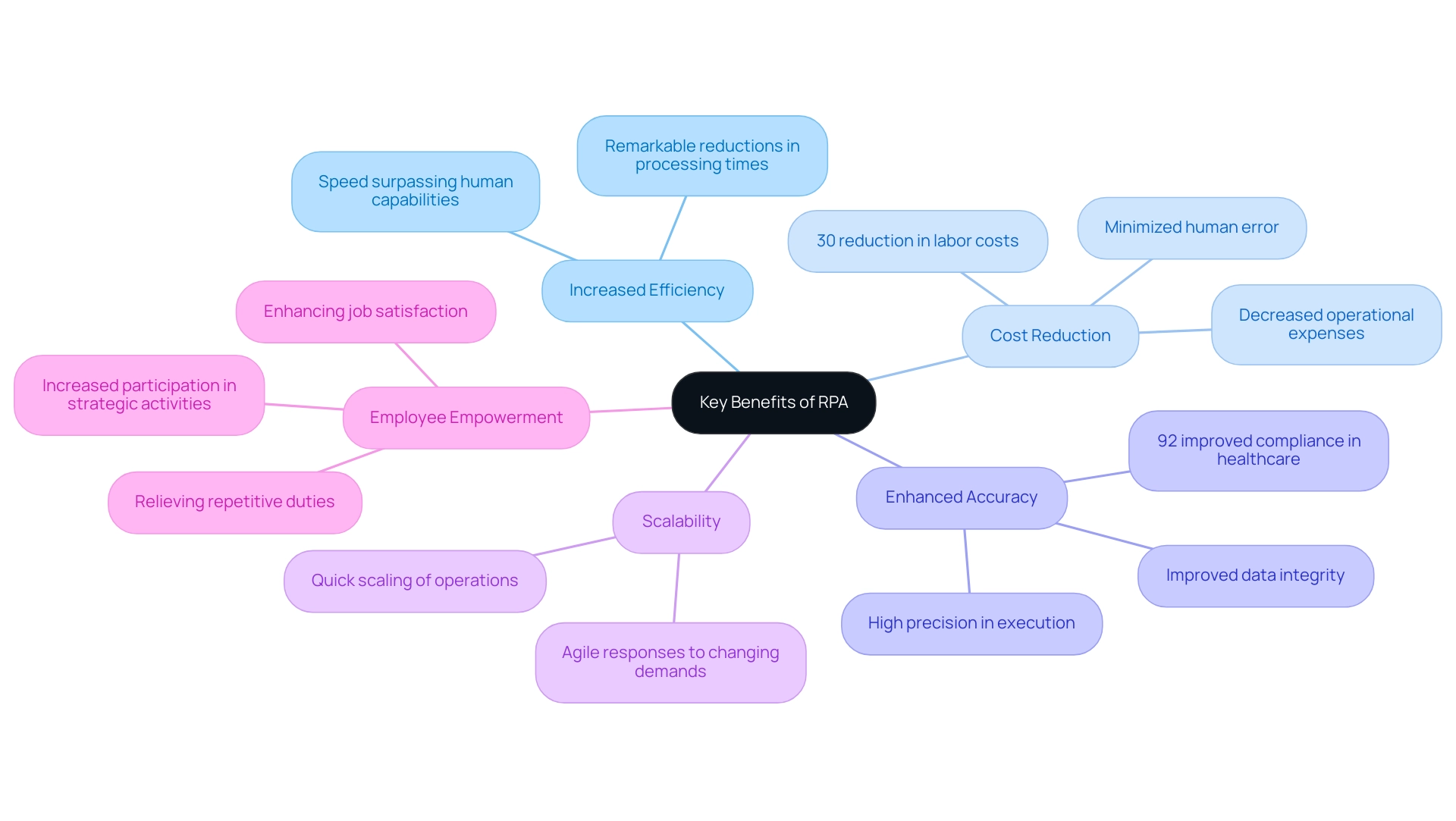
Challenges in RPA Implementation: Navigating Obstacles
Implementing Robotic Process Automation (RPA) can significantly enhance operational efficiency by streamlining workflows and reducing errors; yet companies often encounter key challenges that must be navigated effectively. One prevalent issue is Resistance to Change. Many employees harbor fears of job displacement or are reluctant to adjust established workflows.
Statistics show that 83% of employees using AI-powered automation believe that it can help reduce burnout and enhance job satisfaction, while 89% feel more satisfied with their jobs due to automation. This highlights the importance of clear communication and effective change management strategies to alleviate these concerns. By providing comprehensive training and fostering an open dialogue about what RPA can do, including its ability to tackle repetitive tasks, companies can mitigate resistance and encourage acceptance, ultimately addressing workplace challenges like combatting repetitive tasks and improving talent retention.
Another challenge is Integration Issues. The complexity of ensuring that RPA tools work seamlessly with existing systems can pose significant hurdles. Successful integration necessitates meticulous planning and the technical expertise to execute it.
Organizations should consider conducting thorough assessments of their current systems and engaging skilled professionals to facilitate a smooth integration process, thus modernizing outdated systems that hinder innovation and addressing staffing shortages.
Finally, Maintenance and Governance are critical components that organizations must address. RPA solutions require ongoing oversight and maintenance to ensure they remain effective and compliant with organizational policies. Establishing a governance framework that outlines responsibilities and procedures can enhance the sustainability of RPA initiatives.
Organizations that proactively tackle these challenges, emphasizing training, communication, and structured governance, significantly increase their chances of successful RPA implementation. Significantly, a case study titled ‘Employee Satisfaction with Technology’ revealed that 91% of employees believe that such systems save time and enhance work-life balance. This further emphasizes the positive effects of mechanization on employee productivity and job satisfaction.
Furthermore, with the global robotic process technology market expected to achieve USD 178.55 billion by 2033, the significance of efficient RPA implementation becomes even more vital. By tackling these challenges, entities can ultimately lead to improved productivity and employee satisfaction.
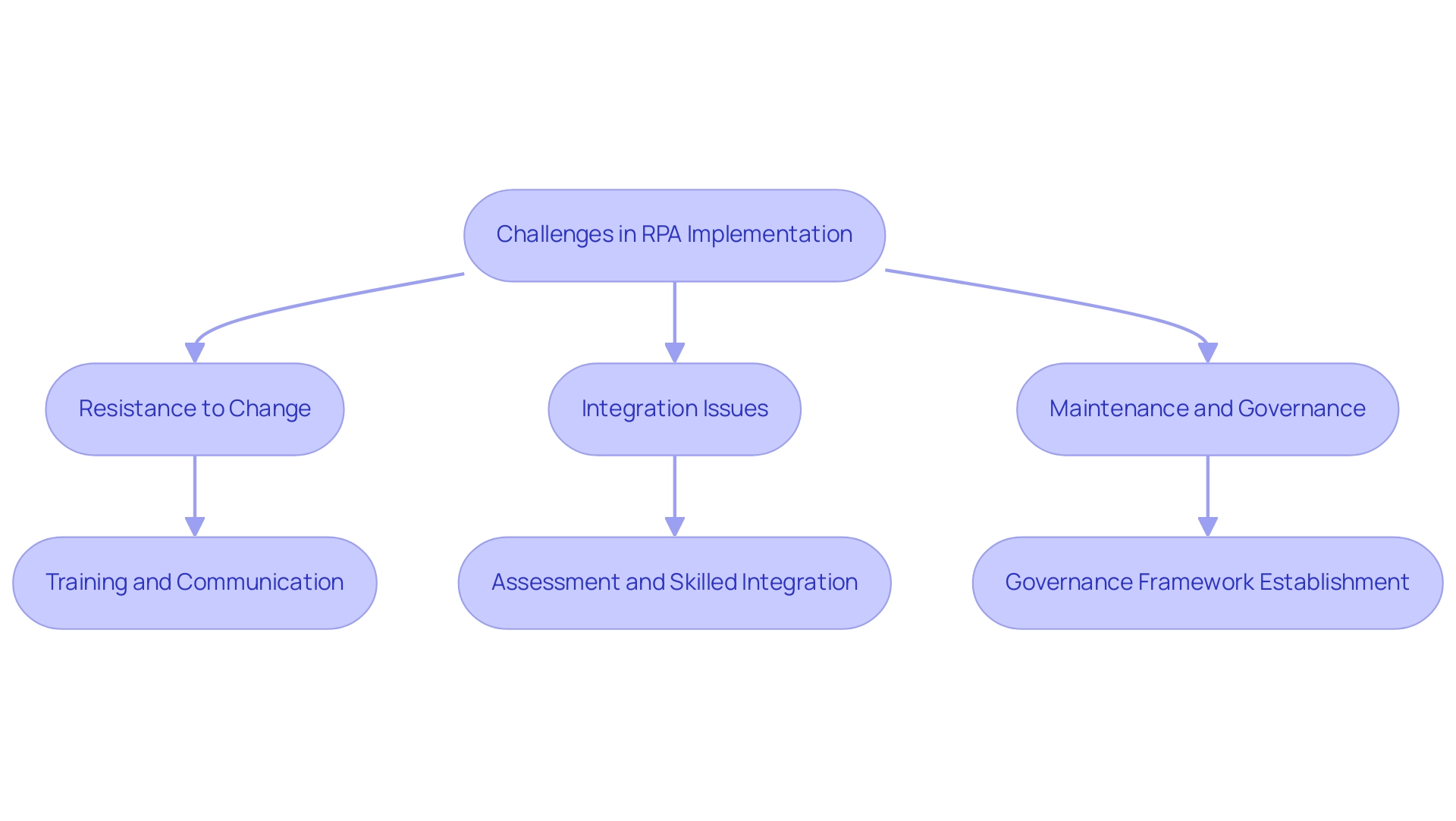
Future Trends in RPA: Evolving Capabilities
As robotic process automation (RPA) technology transcends its traditional boundaries, several pivotal trends are shaping the future landscape that organizations must actively monitor:
- Intelligent Automation: The convergence of artificial intelligence and machine learning with RPA is empowering bots to undertake more intricate tasks that involve decision-making capabilities. This evolution not only improves operational efficiency but also illustrates what RPA can do by broadening the range of mechanization across various business functions. The integration of tailored AI solutions is crucial, as these technologies can effectively address specific business goals and challenges, enabling seamless workflows.
As noted by Gartner, the RPA system will automate the manipulation of data and propagate the source data across other systems, illustrating what RPA can do to make intelligent processes integral to this transformation.
-
Increased Focus on User Experience: Future RPA solutions are anticipated to emphasize user-friendly interfaces, enabling non-technical personnel to easily design and manage workflows. This approach fosters greater engagement and facilitates broader adoption of RPA initiatives within entities, ultimately enhancing business productivity.
-
Cloud-based RPA Solutions: The transition towards cloud computing is set to simplify the deployment and scalability of RPA solutions. Organizations will benefit from accessing advanced automation tools, leading to a clearer understanding of what RPA can do, without the burden of substantial infrastructure investments, which allows for more agile decision-making backed by robust Business Intelligence analytics.
-
Cost Savings: By implementing RPA, organizations can explore what RPA can do to achieve significant cost reductions by minimizing manual labor and increasing the speed of operations, allowing for more effective resource allocation.
-
Challenges in Adoption: Entities may face challenges such as resistance to change, integration complexities, and the need for employee training when adopting RPA solutions.
With SMEs projected to adopt RPA solutions at a growth rate of 25% annually, and the global RPA market expected to grow at a CAGR of 27.7% from 2023 to 2028, it is crucial for entities to remain vigilant about these trends. By harnessing the latest advancements in RPA and leveraging Business Intelligence, they can optimize their operations and maintain a competitive advantage in an increasingly automated world.
Learn more about how our tailored RPA solutions can help your organization navigate these trends and enhance operational efficiency.

Conclusion
Robotic Process Automation (RPA) emerges as a vital asset in modern business, offering the potential to transform operations through increased efficiency and cost reduction. By understanding the distinct types of RPA—attended, unattended, and hybrid—organizations can tailor their automation strategies to maximize productivity and enhance employee engagement. The statistics reveal a compelling narrative: automation not only expedites task completion but also fosters a more satisfying work environment, underscoring the multifaceted benefits of RPA.
However, the journey toward successful RPA implementation is not without challenges. Resistance to change, integration issues, and the need for ongoing maintenance and governance are critical hurdles that organizations must confront. By prioritizing effective communication, comprehensive training, and structured governance frameworks, businesses can navigate these obstacles and harness the full potential of RPA.
Looking ahead, the future of RPA is poised for significant evolution, driven by trends such as intelligent automation, user experience enhancements, and cloud-based solutions. Organizations that stay attuned to these developments will be better equipped to leverage RPA, ensuring they remain competitive in an increasingly automated landscape. Embracing RPA not only modernizes operations but also empowers employees, allowing them to focus on more strategic, value-added tasks. In doing so, companies can cultivate a workforce that is not only efficient but also engaged and satisfied, paving the way for sustained success in the dynamic business environment.
